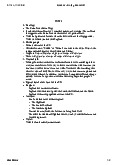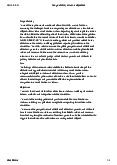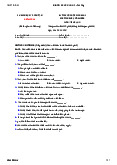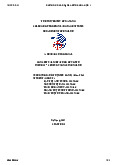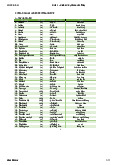



























































































































































































Preview text:
DANANGUNIVERSITY COLLEGEOFFOREIGNLANGUAGES ENGLISHDEPARTMENT ------ ------ Essential COLLEGESTUDY SKILLS (Compiledby DinhThiThuThao) DANANGUNIVERSITY COLLEGEOFFOREIGNLANGUAGES ENGLISHDEPARTMENT ------ ------ Essential COLLEGESTUDY SKILLS (Compiledby DinhThiThuThao) CONTENTS Page
Introduction.........................................................................................................6
PartA:OrganizingforSuccess..........................................................................7
Chapter1:Adjustingto CollegeandDoingYourBest
1.1.Adjustingtocollege ................................................................ 9
1.2.Knowingwhy youareattendingcollege ................................ 9
1.3. Purchasing textbooks immediately .......................................11
1.4. Knowing your teachers' requirements ..................................11
1.5. Attending classes faithfully ..................................................13
1.6. Using the right study equipment ...........................................14
1.7. Organizing your notebook ....................................................15
1.8. Starting a reference library ...................................................16
1.9.Keepingup-to-datewithcoursework .................................. 16
1.10.Doingassignmentsontime ................................................ 17
1.11. Submitting neat assignments ..............................................18
1.12.Usingawordprocessor ...................................................... 18
1.13.Beingpreparedfortests ...................................................... 18
1.14.Participatingindiscussions ................................................ 19
1.15. Building good relationships ................................................20
1.16.Findinghelpifyouneedit .................................................. 20
Exercises .......................................................................................22
Chapter2:DiscoveringandUsing YourLearningStyle
2.1.Adefinitionoflearningstylesandlearningstrategies ......... 24
2.2. Three kinds of learning .........................................................24
2.3. Environmental conditions .....................................................26
2.4. Your learning style ...............................................................26
Exercises .......................................................................................27 2 Chapter3:DealingWith Stress
3.1. Understanding stress ............................................................36
3.2. Sources of stress ...................................................................37
3.3.Reactiontostress .................................................................. 37
3.4.Copingwithstress ................................................................ 38
Exercises.......................................................................................39 PartB:UsingTimeWisely
Chapter4:SettingandReaching Goals
4.1. Types of goals .......................................................................43
4.2. Steps for achieving goals ......................................................45
4.3. Writing goals .........................................................................45
4.4.Planningintermediateandcurrentgoals-Settingtime for
current goals .................................................................................46
4.5.Doingyourbesttoachieve goals .......................................... 47
4.6.Monitoringandassessingyourprogress................................ 47
4.7.Revisinggoalswhennecessary.............................................. 48
Exercises........................................................................................49 Chapter5:ManagingYour time
5.1. Analyzing the demands on your time. .................................52
5.2.Deciding howmuchtostudy ................................................ 53
5.3.Determiningtimeavailableforstudy ................................... 54
5.4. Setting priorities for what to study ........................................58
5.5.Decidingwhentostudy......................................................... 60
5.6. Making better use of time .....................................................61
5.7. Balancing your responsibilities..............................................62
Exercises........................................................................................64
Chapter6:IncreasingConcentration
6.1. Accommodating your preferences ........................................68
6.2.Selectingaspecificplacetostudy ........................................ 68
6.3. Eliminating interruptions ......................................................68
6.4. Keeping records of concentration .........................................69 3
6.5.Usingyourlistofthingstodo .............................................. 69
6.6.Deciding thatyouwanttostudy ........................................... 69
6.7. Doing routine tasks first .......................................................70
6.8.Doinglargetasksabitata time ........................................... 70
6.9. Accepting difficult tasks .......................................................71
6.10. Rewarding yourself for studying. .......................................72
Exercises .......................................................................................71
PartC:StudyingEffectivelyandTakingTestSuccessfully
Chapter7:UsingEffectivelyStudyMethods
7.1.Listeningand takinggoodclassnotes.................................. 77
7.2. Previewing before you read ................................................77
7.3.Markingandmakingnotesfortextbooks ............................ 77
7.4. Anticipating test questions ...................................................79
7.5.Rememberingandrecalling .................................................. 82
Exercises...................................................................................... 84
Chapter8:ListeninginClassandTakingGoodClassNotes
8.1.Beinganactivelistener ........................................................ 85
8.2. Taking good class notes........................................................ 88
Exercises.....................................................................................100
Chapter9:PreviewingTextbooksandPreviewingChapters
9.1. Previewing textbooks .........................................................108
9.2. Previewing chapters ...........................................................109
Exercises.....................................................................................110 Chapter10:Markingyourbooks
10.1.Reasonsformarkingbooksandhow tomarkbooks…….112
10.2. Number and vertical lines ................................................114
10.3. Helps for finding details ...................................................117 Chapter11:MakingNotes forbooks
11.1. Notes on cards. .................................................................123
11.2.Majorandminordetails ................................................... 125 4
11.3. Paragraph Summaries .......................................................126
11.4. Definitions of terminology ...............................................127
11.5. Classification charts .........................................................128
11.6. Time lines .........................................................................129
11.7. Maps .................................................................................130
Exercises.....................................................................................131
Chapter12:LanguageLearningStrategies
12.1. A definition of a good language learner ..........................132
12.2.LearningtolearnEnglish................................................. 133
12.3. Assessment of performance in language learning ...........136
Exercises………………………………………………………138 Chapter13:OralPresentation
13.1.Oralpresentation:time,purpose,structureandmanner. .. 142
13.2. Presentation aids ...............................................................145
13.3.Thechairpersonandtheaudience .................................... 147
13.4.Someexamplesoflanguageusedfororalpresentation..... 151
13.5. Sample seminar performance assessment ........................155
Exercises.....................................................................................156
Chapter14:Rememberingand RecallingInformation-DoingWellonTests
14.1.Rememberingandrecallinginformation....................... 157
14.2.Doingwellontests ........................................................ 160
Exercises...................................................................................169 Appendices:
Appendix1: Exercises for chapter 9…………………………173
Appendix2: Exercises for chapter 10………………………..184
References .......................................................................................................187 5 INTRODUCTION
Allcollegestudentswanttodowelloncollegecourses,butnotallof
themaresuccessfulhoweverhardthey try.Itisbecausemostcollege students
donotknowhowtoorganizeforsuccess,howtousetimewisely,howto
studyeffectively andhowtodowellontests.Thereforeeffectivecollege
studyskillsareveryimportantforstudentstosuccessfullypursuea college education.
Thisbookisaimedatequippingstudentswithsomeeffectivecollege
studyskillsthatareneededforsuccessincollege.Itconsistsofthreeparts:
Organizingforsuccess-Usingtimewisely -Studyingeffectivelyandtaking testssuccessfully.
Hopefully,studentswillfindthisbookusefulandconsiderittheir
companionthroughout thetimetheystudyatcollege. 6 PARTA ORGANIZINGFORSUCCESS PreviewofPARTI
ThisfirstpartofCollegeStudySkills explainsbasicmethodsyoumay
usetosuccessfullypursueacollegeeducation.
Chapter1,"AdjustingtoCollegeandDoing YourBest"
suggestswaystomakeasmoothtransitiontocollegelife,
summarizesproceduresusedbysuccessfulcollegestudents,and
discussessourcesofhelpthatare availabletoyouincaseyou haveacademicdifficulty.
Chapter2,"DiscoveringandUsingYourLearningStyle,"
givesyou anopportunityto analyzeyour studyprocedures.
Chapter3,"DealingwithStress,"includessuggestionsfor adaptingtoandcopingwithstress. 7 Chapter1 ADJUSTINGTOCOLLEGE ANDDOINGYOURBEST 1.1. Adjustingtocollege 1.2.
Knowingwhyyouareattendingcollege 1.3. Purchasingtextbooksimmediately 1.4.
Knowingyourteachers'requirements 1.5. Attendingclassesfaithfully 1.6. Usingtheright studyequipment 1.7. Organizingyournotebook 1.8. Startingareferencelibrary 1.9.
Keepingup -to-datewithcoursework 1.10. Doingassignmentsontime
1.11. Submittingneatassignments 1.12. Usingaword processor 1.13. Beingpreparedfortests
1.14. Participatingindiscussions
1.15. Buildinggoodrelationships 1.16. Findinghelpif youneedit
Thefirstweeksofcollegemaybedisturbingtoyou-theyareformost
students. Youwillneedtomakenewfriends,andyouwillhavenewteacherstoget
usedto.Youwillneedtolearnwhereclassroomsare locatedandtofindthe
easiestwaytotravelfromoneplacetoanother.Youwillwanttobuyyour books,
planwhereyouwillstudy,andschedulewhenyouwill study.Also,youmayfeel
uncomfortablebecauseyoudon'tknowwheretogoforhelpifyouhavea problem.
Thischaptersuggestssomebasicwaysto adjusttocollegelife anddo yourbestforsuccess. 8 1.1.Adjustingtocollege Freetime
Incollegeyouwillberesponsiblefordecidingwhatyouwilldoduring
thetimethatyouare notinclasses.Willyouwasteyourfree time, orwillyou
useitstudying,exercising,working,orengaginginotherconstructive activities.Onlyyou candecide! NewFriends
Youwillenjoy schoolmoreifyouhavefriendstotalkwithbeforeand
afterclasses,Inaddition, youneedfriendsinyour classeswhomyoucancall
tolearnaboutassignmentsgivenwhenyouareabsentandfromwhomyou
cancopy notesgivenondaysyouarenotinclass. Youmayalsofind itis
helpfultodiscussassignmentsortostudy fortestswithstudentswhoare
takingthesamecourseyouaretaking.Therefore,putahighpriorityon
makingfriendsineachclassyoutake. SocialActivities
Yourcollegeexperiencewillbemoreenjoyableifyoumakethe effort
toattendsocialfunctions,joinclubs,andparticipateinsports.
Yourstudentgovernment sponsorssocialevents,suchas movies,
concerts,athleticevents,anddances.Theseandother activitiesareavailable
toyouatlittleornocost.Readstudentnewspapersandnoticesonbulletin
boardforannouncementsoftheseevents.
1.2.Knowingwhyyouareattendingcollege
Itmayseemobviousthatthereasonpeoplegotocollegeistoacquire
aneducation,but thereasons forattendingacollegeoruniversityareactually
extremelyvaried.Youngpeoplewhohaverecentlycompletedhighschool
maygotocollegebecausetheycannotfind work,olderpeoplemaygoto 9
collegebecausetheopportunityhasbeenmadeavailabletothembytheir
employers.Thefollowingchecklistliststhereasonsstudentsmostgivefor beingincollege.
ChecklistofReasonsfor AttendingCollege
Checktheboxes infrontofthe threereasonsthatbestdescribewhy youarein school. Iwanttoearnacollegedegree.
Ineedabetter educationtogeta goodjob.
Iwanttopreparemyselfforaspecificoccupation. Iwanttobeawell-educatedperson.
Iwanttolearntothinkmoreclearly.
Iwanttobethefirstinmy familytograduatefrom college.
Iwanttobemoreresponsibleformyownlife.
IwantajobbetterthantheoneIhavenow.
IwanttobepromotedattheplacewhereIwork.
IwanttodecidewhatIwilldowithmylife.
Iwant tousethemoneythat isavailableformytuition. Icannotfinda jobrightnow. Idonotwanttogotoworkrightnow. Myparentswantmetogotocollege. Ilike thesociallifeat college.
Ilikethefeelingitgivesmetobeoncampus.
Iwant tofinda boyfriendorgirlfriend. Iwanttofind ahusbandorwife.
Moststudentscheckthreeboxesinfrontofthefirsttenreasons, which
areallwaysofsaying"Iwanttoimprovemyself". 10
Didyoucheckboxesinfrontofthereasonsthatarewaysofsaying"I
wanttoimprovemyself"?Ifso,youbelieveinthepossibilityofabetterlife
foryourself,andyoubelievethatifyouattendcollege,yourlifewillbebetter forit.
However,ifyouareattendingschoolonlyto pleaseyourparents,only
because youcannotfindwork,onlyfor somereasonotherthanself-
improvement,you may nothavesufficientmotivationtodowellinschool.
1.3.Purchasingtextbooks immediately
Oneimportantway thatcollegediffersfrom highschoolisthatcollege
studentsmustbuytheirowntextbooks.Some studentsencounterunnecessary
difficultiesbecausetheywaittoolongtopurchaserequiredbooksorbecause
theytry togetbywithoutbuyingthebookstheyneed.
Textbooksareexpensive,buttheyareasmallcostofattendingcollege
incomparisontotuition,housing,andother expenses.Dowhatexperienced
studentsdo-purchaseyourrequiredbooksimmediately andgeta headstart
inyourclassesby beginningtoreadthemeven beforeyourteachersgive readingassignments.
1.4.Knowingyourteachrs’requirements
Studentswhodon'tknowwhattheirinstructorsrequireusuallydon'tdo
allthethingsthatareexpectedofthem. Asaresult,theyusuallydonotearn verygood coursegrades.
Duringthe first class meeting,instructorsusuallygive anoverviewof
thecourse,explaincourserequirements,anddistributeasyllabusorother
handout.Asyllabusisaprintedoutlineofthemaintopicsofacourse.When
courserequirementsarelistedina syllabusoronother printedpages,keep
theminasafeplace,whentheyare presentedorally,maintainaccurateand 11
completenotesaboutthem.In eithercase,understandthemcompletelyand followthemexactly.
Usethefollowingchecklisttomakecertainthatyouknowexactlywhat
yourteachersexpectofyou.Some teachersrequireonlythatstudentstake
midtermandfinalexaminations,butother instructorsrequiremostofthe
itemsthatarementionedinthechecklist. ChecklistforCourseRequirements
Writechecksinpencilso you canerasethem andusethis checklistforeach course.
IknowwhatbooksorothermaterialsI mustpurchase.
IknowwhatbooksormaterialsImusttaketoclass. Imusttakenotes duringclass.
Imustparticipateinclassdiscussions. Imustdohomeworkassignments.
Imustread materialsthatareonreserveinthe library.
Imustattendalaboratory (andIknow whereitis locatedandwhen Imustattendit).
Imusthaveconferenceswiththeteacher
(andIknowwhenandwhereImustgofortheconferences)
Imustwriteapaper(andIknowtheformatforthe paperandwhenitisdue)
Imustgoonfieldtripsortoconcertsor museums.
Iknowthe classpolicyon missed and lateassignments.
Iknowthe classpolicyonlatenessandabsence.
Iknow how manytests I must take and whentheywill be given.
Iknow how myfinal grade will bedetermined.
Ifyouareuncertainaboutrequirementsforacourse,asktheinstructor toexplainthem. 12 1.5.AttendingclassesFaithfully
Atsomecollegesthereareteacherswhodonottakeattendance,thus
givingstudentstheimpressionthatitisnotimportantforthem togotoclass.
However,eventeacherswhodon'ttakeattendancearenotlikelytobe
sympathetic towardstudentswhocutclass.Studentswhoarefrequently
absentshouldnotexpecttheirteacherstodofavorsforthem iftheyhavea
problem, andchancesarethatthey willhaveaproblem.
Faithfulclassattendanceisessentialbecauseyouareresponsiblefor
everythingthathappensineachofyourclasses,evenifyouareabsent. For
instance,youareexpectedtoknowaboutallassignmentsandtestsevenif
theyareannouncedonadayyouarenotinclass!Inaddition,itisonly by
attendingclassthatyoucanknowwhatmaterial yourinstructorsemphasized
bywritingitonthe board,by repeatingit,orby othermeans;youcannotget
thisinformationfromanother student'snotes. Ifyoudon't knowwhat material
yourteachersconsidertobemostimportant, youwillnotknowwhatto
emphasizewhenyou studyfortests. WhatToDoIf YouMissaClass
Contactaclassmatetolearnaboutassignmentsortestsannounced inyourabsence.
Hand-copyorphotocopynotestaken byaclassmatewhile youwereabsent.
Deliverdueassignmentstotheinstructorassoonaspossible.
Whenyoureturntoaclass,checkwith yourteachertomake
certainthat yourclassmategave youcorrectinformationabout
assignmentsandtests,andasktheinstructorforsuggestionsabout
howyoucancatch upwithworkyoumissed.
Inadditiontoattendingallclasses, arriveontime.Students whoare
frequentlylatefor classcommunicatethemessagetotheirteachersand 13
classmatesthattheyare disorganized,inconsiderate,orimmature.Donot
createanunfavorable impressionofyourself;arriveatclassontime.
1.6.Usingthe rightstudyequipment
Professionalchefsdon'ttrytocookgourmetmealswithouttheright
cookingutensilsandqualifiedcarpentersdon'ttrytobuildhouseswithoutthe
toolsoftheirtrade,but manystudentstrytopursueacollegecareerwithnot
muchmorethanaballpointpenandaspiralnotebook.
Youwillfindthatitiseasiertobeastudentifyouhavetheequipment
thatyouneedtodotheworkof astudentefficiently.Thefollowingchecklist
mayincludesomeitemsthat youneedtopurchase. StudyEquipmentChecklist
Checktheboxesin frontoftheitems you own. Deskortable Stapleremover Deskchair Ruler Readinglamp Holepunch Wordprocessor Notebook Bulletinboard Notebookpaper Bookshelves Typingpaper File Indexcards Requiredtextbooks Filefolders Dictionary Pencilsandpens Thesaurus Pencilbag Calculator Highlightpens Pencilsharpener Eraser Paperslips Rubberbands Transparenttape Scissors Householdglue Clockorwatch Staplerandstaples Backpack,bag,orbriefcase
Figureouthowyoucanacquireany ofthisequipmentthatyouneedbutdon't have. 14 1.7.Organizingyournotebook
Organizeyournotebooksothatnotesforeachclassarecompletely
separatefrom thenotesforyourotherclasses.Forexample,notesfora
biology, amath,andanEnglishcourseshouldbekeptinthreeseparate
sectionsofanotebook.Ifyoumixyournotesforoneclasswithyournotesfor
anotherclass, your noteswillnot beproperlyorganized whenyou studythem
topreparefor tests.Inaddition, besureyousetasideinyournotebooka place
tokeeprecordsaboutassignments,tests,instructors,andclassmates.
ImportantRecordsfor YourNotebook
Informationaboutassignmentsshouldexplainexactly
whattheyare, howtheyaretobedone and whentheyare due.
Information about tests should include exactly what
materialsandtopicswillbecoveredoneachtestandthe
dates,times,andplacesthatthetestswillbegiven.
Informationaboutinstructorsshouldincludetheirnames,
office locations, office telephone numbers, and office hours.
Informationaboutclassmatesshouldincludethenames,
addresses,andtelephonenumbersofatleasttwopeoplein
eachclass, whom you can contactforassignments and notesyoumisswhenyouareabsent. 15 1.8.Startingareferencelibrary
Inadditiontotextbooks,youneedreferencebookstohelpyouindoing
yourcollegeassignment.Your basicreferencelibrary shouldincludea
standarddeskdictionary,athesaurus,andanEnglishhandbook. ABasicReferenceLibrary
Inadditiontoapaperbackdictionarytotaketoclasses,
youneedastandarddeskdictionarytousewhereyou
study.Whenyoushopfora deskdictionary, payspecial
attentiontothecleardefinitions,usagenotes, word histories,andillustrations.
AgoodEnglishhandbookisanessentialreferencebook
becauseitcontains agreatofinformation,including
answerstoyourquestionsaboutgrammar,usage,and
thecorrectformatfor termpapers.
1.9.Keepingup-to-datewith coursework
Collegetermsstart outslowly.Theygraduallyget busierandbusier,
reachingapeakofactivity atfinalexaminationtime.Ifyoufallbehindinthe
workforacourse,youmayfindyourselftryingtocatchupjustwhenyouare
verybusywithallofyourothercourses.Don'tfallbehind.Keepup-to-date withworkinallyourcourses.
Thisisdoublyimportantwhenyou mustmasterinformationor skills
taughtearlyinacourseinordertolearninformationorskillsthatare taught
laterinthecourse.Mathematics,science,technology,andforeignlanguage
coursesaresomeofthecoursesthatfallintothiscategory.Whenyoustudy,
askyourselfthisquestion:"DoIneedtolearnthisinformationorskillin 16
ordertolearnotherinformationorskillslaterinthecourse?"Iftheanswerto
thatquestionisyes,learntheinformationorskillimmediatelyandreviewit often. 1.10.Doingassignmentsontime
Instructorsgiveassignmentstoprovidepracticeforskillsandforother
purposes.Theyexpectstudentstohaveassignmentsready ontime,many
teachersdonotacceptlatework,andotherinstructorsgivelower gradesfor
assignmentsthatareturnedinlate.
Someteachersgiveassignmentsthatthey reviewinclassbutdonot
collectandgrade.Dotheseassignmentsfaithfully,theirpurposeistohelpyou
acquireaskillortolearn otherthingsthatyouneedtoknow.
Teacherssometimesrequirestudentstowritepapersthatarefive,ten,
ormorepageslong.Thegradesforpaperssuchastheseusuallyaccountfor
substantialproportionsofcoursegrades.Therefore,before youstart workon
anypaperforwhichyouwillreceivecollegecredit,makecertainthatyou
knowtheanswerstothefollowingquestions.
QuestionstoAsk BeforeStartingaPaper
Howmanypages longmustthe paperbe?
Whattopicsare acceptable forthepaper?
Inwhatformatmustthepaperbepresented? Whenisthepaperdue?
Whenyouareuncertainabouttherequirementsforapaper,schedulea
conferencewiththeteachertoreceivetheclarificationyouneed. 17
Itiswise tobeginworkonlongpapersassoonasthey areannounced.
Ifyou putoff writing a paper,you mayneed todevotemanyhourstoit just
whenyouwanttoprepareformidtermtestsorfinalexaminations.
Keepaphotocopyofeachpaperyouwriteorstorethefinalversionof
eachpaperinyourcomputersoyouwillnotneedtorewriteitifateacher
misplacesorlosesit.Youwillthenhavearecord ofreferencesandother
informationin thepapertowhichyoumaywanttoreferinthefuture. 1.11.Submittingneatassignments
Beforeyousubmitany writtenwork, keepinmindthatcollege
instructorsusuallygive highergradestopapers thatare neatin appearance
andfreeoferrorsthantoonesthataresloppy lookingandfullofmistakes.
Therefore,askafriendorrelativetoproofreadyourwrittenwork beforeyou
giveittoaninstructor,andsubmitonlypapersthatareas neatasyou can makethem. 1.12.Usingawordprocessor
Ifyoudonotknowhowtouseaword-processingprogram, itwouldbe
agoodideaforyoutolearn.Purchaseapersonalcomputer,ifyoucan.If you
cannot,onemaybeavailableforyouruseinan instructional resourcecenter
orinsomeotherfacility onyourcampus. 1.13.Beingpreparedfortests
Somefirst-yearstudentsmakethemistakeofnotpreparingproperlyfor
thefirsttesttheirteachersgive.Beingpoorlyprepared,theydonotgotoclass
ontestdays,ortheytaketestsandreceivelowgrades.Eitherway,theystart thetermata great disadvantage.
Ifyouareabsentontheday atestis given,youmayberequired totake
amake-uptestthatismoredifficultthanthetest theother studentstook.Orif 18
ateacherdoes notoffermake-uptests,youmaybegivenafailinggradefor thetest youmissed.
Ifyoureceivealowgradeforthefirsttestinacourse,youmight
becomediscouragedbecauseyourealizethatitmay beextremelydifficultfor
youtoearn agoodgradeinthecourse.Donotcreatean unnecessarysource
ofdiscouragementfor yourself.Bepreparedtodoyourbestonalltests.
1.14.Participatingindiscussions
Someinstructorsevaluatestudents on thecontributionstheymaketoclass
discussions.Ifaninstructorannouncesthere willbeaclassdiscussion,preparefor
itby readingassignedmaterialaboutthediscussiontopicbeforeyougotoclass.
Youdonotneedtodoagreatdealoftalkingduringa discussion.Itis
usuallybettertosaytoolittlethantosay toomuch.Makestatementsandask
questionsthataredirectlyrelatedtothepointsunderdiscussionandthatkeep
thediscussionmovingtowardthegoalthathasbeenestablished.Try using someofthefollowingstrategies. HowtoParticipateinDiscussions
Ifsomebodysayssomethingthat youdonot fullyunderstand,
askforamorecompleteexplanation.
Ifsomebodygivesinformationonatopicandyouhave
additional information about the same topic, offer the information.
Ifsomebodyasksaquestionthatyoucananswer,givetheanswer.
Whenitisappropriate,askanyquestionyouhaveaboutthe discussiontopic. 19 1.15.Buildinggoodrelationships
Itistoyourbenefittohave goodrelationswithyourinstructors.Ifa
problemarises,teacherswillbemoreinterestedinhelpingyoufindasolution
ifyouhavemadeafavorableimpressiononthem.Also,whentheycan’t
decidewhich oftwogrades togiveyou,theyaremorelikely togiveyouthe
highergradeifthey havepositivefeelingsaboutyou.
Studentsalsocreate agoodimpressiononinstructorswhentheyshow
thattheyarewilling and readytolearnbyattendingclassfaithfully,arriving ontime,
sittinginanattentiveposition,andcontributingtotheclassbyaskingand
answeringquestions.Mostofyourteacherswillalsoappreciateitifyousmile
andsayhellowhenyouseethemoncampus.Followingisa listofstudent
behaviorsthatareasourceofannoyancetomanycollegeteachers. BehaviorsThatMay AnnoyaTeacher Cuttingclass Actingboredor goingtosleep Arrivinglateor leavingearly
Studyingsomething foranotherclass Beingunpreparedforclass
Criticizingthecourseorsubjectmatter Holdingaconversation
Eating,drinkingorchewinggumnoisily Notpayingattention
Passingnotesor makingwisecracks Makingcommentsaboutthe Nothavinganotebookorpen teacher'sprivatelife 1.16. Findinghelpifyouneedit
Moststudentshavedifficultywithacourseatsometimeduringtheir
collegecareers.Academicdifficultyoften beginswhenastudentsfallsbehind
indoingassignments,missesaquizortest, orisabsentfrom classes. 20
Youshouldgethelpatthefirstsignofaproblem.Thefirststepin
solvingaproblemistoacknowledgethatitexists.Don'tmakethemistakeof
thinkingthattheproblem willgoaway-itprobablywon't.Ifyouhavetrouble
inacourseduringthethirdweekofa term,youarelikelytobeinworse
troublelater on.Therefore,beginimmediatelytoexplorepossiblesolutions to
yourproblem.Don'tbehasty, taketimetoinvestigateallpossibleremediesto
yoursituationandweightheadvantagesanddisadvantagesofeachalternative
beforeyousetacourseofaction.Followingarethestrategiesforsolving academicproblems.
StrategiesforSolvingAcademicProblems
There are six basic strategies you mayuse to help yourself resolve anacademicproblem.
1. Studyabook.Investigatewhether theanswertotheproblemis
printedinabookyouown,borrowfromalibrary,orpurchaseina bookstore.
2. Talkwith helpfulpeople.Conferwithateacher,counselor,adviser,
experiencedstudent,orotherperson who manysuggestasolutionto yourproblem.
3. Studywithagroup. Youmaybeabletogiveandreceivehelpfrom
classmatesbystudyingwithsomeofthem inagroup.
4. Improveyourlearningskills.If yourlearningskillsaredeficient,
takeadvantageofinstruction yourschoolprovidesinwriting, mathematics,readingorstudying.
5. Dropacourse.You mayfind it necessaryto drop a course and take
itagainlater,thewithdrawalgradeisprovidedforthispurpose.
6. Requestmoretime.If yourequest, ateacher maygive you
additionaltimetocompleteatermprojectortostudyforafinal
examination;specialgradesareprovidedforthispurpose. 21 EXERCISES
Exercise1.1:ChecklistforCourseRequirements
Usethe"ChecklistforCourseRequirements"toanalyzewhatyour
teachersrequire.Useyouranalysestowriteasummaryoftherequirements foreachofyourcourses.
Exercise1.2: AttendanceRequirements
Writetheanswersto thefollowingquestionsinyournotebook.
1.Whataretheofficialattendancerequirementsatyourcollege?
2.Ifany ofyourteachershaveattendancerequirementsthataremoreor
lessstrictthanthoseofyourcollege,listthoserequirements.
Exercise1.3: YourStudyEquipment
Whichitemsthatyoudidn'tcheckonthe"StudyEquipment
Checklist"doyouintendtopurchase?List theminyournotebook.
Exercise1.4 :CourseInformationChart
Listinformationaboutyourcourses,instructors,classmatesandtestson
the"CourseInformationChart"below: CourseInformationChart Courses Instructors Classmates TestDates Name: Title: Name: Phone: Room: Office: Name: Days/Times: OfficeHours: Phone: Name: Title: Name: Phone: Room: Office: Name: Days/Times: OfficeHours: Phone: 22 Name: Title: Name: Phone: Room: Office: Name: Days/Times: OfficeHours: Phone: Name: Title: Name: Phone: Room: Office: Name: Days/Times: OfficeHours: Phone: Name: Title: Name: Phone: Room: Office: Name: Days/Times: OfficeHours: Phone:
Exercise1.5: FindingHelpfulPeople
Seekthehelpofothersif youhaveacademicproblems.
Listthefollowingon asheetofnotebookpaper.
1. Thenamesofallyourcurrentteacherswithwhomyouwouldfeel
comfortableindiscussingany difficultyyoumighthave infulfilling
therequirementsfortheircourses.
2. The names of atleastthreesecond,third-,orfourth-yearstudents
enrolledinyourcurriculumfrom whomyouwouldseekhelpifyou
werehavingdifficulty withacourse.
3. Thenameofatleastonepersonineachofyourcourseswithwhom
youmightstudyorwhomighthelpyouinstartingastudygroupfor thecourse. 23 Chapter2 DISCOVERINGANDUSINGYOUR LEARNINGSTYLE
2.1.A definitionoflearningstylesandlearning strategies 2.2.Threekindsoflearningstyles 2.3.Environmentalconditions 2.4.Your learningstyle
Thischapterisdesignedtogiveyouinsightintothree kindsoflearning styles.You willfindoutabout:
-Thelearning strategiesyouprefertouse
-Yourpreferencesforlearningbyvisual,auditory,orkinesthetic means
-Theenvironmentalconditionsunderwhichyouprefertostudy. -Yourlearningstyle
2.1.A definitionoflearningstylesandlearningstrategies
Learningstylesarethe generalapproaches– forexampleauditoryor
visual– thatstudentsuseinacquiringanewlanguageorinlearninganyother subject.(Cornette,1983)
Learningstrategiesaredefinedasspecificactions,behaviors,steps,or
techniquesusedby studentstoenhancetheirownlearning(Scarcellaand Oxford,1992)
Useexercises2.1and2.2tothinkaboutandanalyzethelearning strategiesyouuse. 2.2.Threekindsoflearningstyles
Mostofwhatwelearnwelearnthroughreading,watching,hearing,
touchingormoving.Whenyoureadorwatch, youuseyoursenseofseeing;
whenyouhear,youuseyoursense of hearingandwhenyoutouchandmove, 24
youuseyoursensesoftouch andkinesthesia.Kinesthesiaisthesensory
experiencethatcomesfrommovingmuscles,tendons,andjoints.
Someteachersprovidestudentswithvisual,auditory,andkinesthetic
learningexperiences.Forinstance,aswimming instructorwouldprobably
teachyouanewstrokeby demonstratingit,explainingit,andhavingyou
practiceit.Youwouldreceivetheinstructionvisuallybywatchingthe
demonstration,auditorilybyhearing theexplanation,and kinestheticallyby
makingthe movementsofthe swimstroke.
Thoughwealllearn bythesemeans,somestudents haveadefinite preferenceforoneofthem.
Visual learners prefer to learn by reading and watching
demonstrations.Becausethey wouldratherreadatextbookthanlistentoa
lecture,theyenjoylecture coursesmore whentheytakemanynotesto study afterclass.
Auditorylearnersprefertolearnbylisteninganddiscussing.
Becausethey would ratherlistentoalecturethanreadatextbook, theyenjoy
readingmoreafterthey listentoabackgroundlectureonthesubjectmatter.
Kinestheticlearnersprefertolearnbybeingphysicallyinvolved,
suchasbydoingsomethingorbyhandlingandmanipulatingthings.Because
theyprefertolearnbyexperimentingontheirown,theybenefitmostfrom
listeningtolecturesandreadingtextbookswhenthey understandhowthese
activitiesbenefitthemintheirexperimentation.
Theprimaryadvantageofknowingyour instructionalpreferenceis
thatitwillhelpyouinadjustingtothedemandsofcollegestudy. Forinstance,
astudentwasdissatisfied withhishistoryprofessor'slecturesbecausehe
preferredlearning byreadingrather thanbylistening.Headjustedtothe 25
historycourse bytakingmorenotesandcomparingwhathisteacher saidto
whatwaswrittenincoursereadingmaterial.
UseExercises2.3,2.4toanalyzewhetheryouprefertolearnvisually,
auditorily,kinesthetically,orbyusingacombinationofthesemeans. 2.3.Environmentalconditions
Overthepasttwenty-fiveyears,educationalpsychologistshavestudied
learningstyleina varietyofways.Forinstance,onearea ofresearch
investigateshowstudents'performanceisaffectedbystudyingattimesthey
prefer rather than at other times. This branch of research, called
chronobiology,hasproducedclearevidencethatstudentsperformmuchbetter
whentheystudy ortakecoursesatthetimesofday whentheyaremostalert
thanwhentheystudy ortake coursesatothertimes.
Itusedtobecommonlybelievedthat everybodylearnsbestwhen they
studyinaquietplace,seatedatadesk.Today,theseassumptionsare
questioned.Researchershavefoundthatsomestudentsstudybetterwiththe
distractionofbackgroundmusicandthatotherslearnjustaswellwhenthey
studysittinginan easychairastheydowhen theystudysittingat adesk.
Someofthe otherenvironmentalconditionsthataffectstudyinginclude
roomtemperatureandthepresenceorabsenceofnoise,food,orotherpeople.
Exercise2.5providesan opportunityforyoutothinkabouttheenvironmental
conditionsunderwhichyouprefertostudy. 2.4.Yourlearningstyle
Doexercise2.6todiscoveryourlearningstyle. 26 EXERCISES
Exercise2.1:LearningStrategyChecklist
Followingisalist offifty-fourlearningstrategiesthatareexplainedin
CollegeStudySkills.Checktheboxesnexttothestrategiesthatyou actually
useandtotaltheboxesyoucheckineachcategory.Youwillusethetotals whenyoudo exercise2.2. Iusethis strategy
A.BasicStrategies(Chapter___1__)
1.Atthebeginningofeachterm,Ifindoutexactlywhat teachersrequire
2. Iattend all classesunlessI amsick.
3.Ipurchaseallrequiredbooksandothermaterialsatthe beginningoftheterm.
4.I keepup-to-datewithcoursework.
5.I haveall assignmentsreadyon time.
6. Iamalways preparedfor tests. Totalchecks ________
B.TimeManagement(Chapter___5__)
7.Ischeduletimefordoingassignmentsandpreparingfor examinations.
8.Ikeepa dailylistthings thatIneedtodo.
9.I keeparecordoftheassignmentsforallofmycoursesin oneconvenientplace.
10.Isetprioritiesfor theorderinwhichI doassignments.
11.Ischedulethestudy ofdifficultsubjectsatthetimeofday whenI ammost alert. 27
12.Ischedulemajor projectstocompletethem astepatatime overaslonga periodaspossible. Totalchecks ________
C.Preparing forTests(Chapter___14____)
13.Iuseclassnotesasaguideaboutwhattostudyfortests.
14.Whenstudyingfortests,Iemphasizeinformationteachers
saidwasimportantordifficulttolearn.
15.Iuse learninggoalsandreviewquestionsintextbook
chaptersasaguidein decidingwhatto learninthem.
16.Ialwayslearnthemeaningsofimportantterminologyin textbooks.
17. I master skills by doing exercises and problems in textbooks.
18.Ialwaysattendtestreviewswhentheyareoffered. Totalchecks ________ D.ClassNotes(Chapter___8___)
19.Ireadabout topicsintextbooksbeforeclasslectureson them.
20.Ibegineachday'snoteswithaheadingthatincludesthe dateand lecturetopic.
21.Imakemajorthoughtsstandoutclearlyinmynotes.
22.Iusesimplifiedhandwritingandabbreviationstowrite notesquickly.
23. Ireviewclassnotes immediatelyafter class.
24. Istudyclassnotes thoroughlybeforetests. Totalchecks ________ 28
E.PreviewingTextbooks(Chapter___9___)
25.Iknowhowtodetermineif abookissufficientlyup-to-date fora specificpurpose.
26.Ireadthe tableofcontentsinbookstogetanoverview of thetopicsin them.
27.Iread prefacesandintroductionsinpreparationforstudying books. 28.Ilocateanduseappendixes. 29.Ilocateanduseglossaries.
30.Ilocateandusesubjectindexesandnameindexes. Totalchecks ________
F.PreviewingChapters( Chapter___9__)
31.Iusethetitle,introduction,andheadingsinachapterto learnthetopicsin it.
32.Iuselearninggoalsorchapterpreviewsasguidesfor studyingchapters.
33.Istudy tables,graphs,diagrams,andothervisualmaterials inachapterbeforereadingit.
34.Ireadachaptersummarybeforereadingthechapter.
35.Iidentify theimportantterminologyintroducedinachapter.
36.Iuse reviewquestions,exercises,andproblems to checkmy learning. Totalchecks ________
G.MarkingTextbooks(Chapter____10___)
37.Iunderline,highlight,orotherwisemarkinformationIwant tolearnina book.
38.Ireada sectionofa bookbeforeImarkit. 29
39.Iuse avarietyof techniquestoavoidunderliningor highlightingtoomuch.
40.Itry tomarkinformationina bookthatwillhelpmemake goodnoteslater.
41. Imarkdefinitionsof terminologyin books. 42.Imarkexamplesinbooks. Totalchecks ________
H.MakingNotesforBooks(Chapter______)
43.ImakenotesforinformationIwanttolearninmy textbooks.
44.Iuseavarietyofformatsfornotes.
45.Ibeginnoteswithatitlethataccurately describesthe informationinthem.
46.Imakemajorthoughts standoutinnotes. 47.Iincludeexamplesinnotes
48.Imakenotesintheclassificationchartortime-lineformat whenappropriate. Totalchecks ________
I.RememberingandRecalling(Chapter__14___)
49.Ilearninformationbyrecitingitoverandover.
50.Ilearninformationbyanalyzingitintoitspartstostudythe
partsand understandhowtheyare related.
51.IlearninformationbyrelatingittoinformationIalready know.
52.Ireviewinformationtoguardagainstforgettingit.
53.Iuseeffectivemethodstolearnvirtuallyallkindsof information. 30
54.Iuseavarietyofeffectivetechniques torecallinformation whenItake tests. Totalchecks ________
Exercise2.2:AnalyzingYourLearningStrategies
Putacheckineachboxunderthenumberofitemsyoucheckedineach
categoryinexercise 2.1.Forexample,ifyoucheckedfourofthebasic
strategies, putacheckintheboxunder"4"for"A.BasicStrategies". NumberofChecks in Exercise “ LearningStrategy Checklist” 1 2 3 4 5 6 A.BasicStrategies B.TimeManagement C.PreparingforTests D.ClassNotes E.PreviewingTextbooks F.PreviewingChapters G.MarkingTextbooks H.Making NotesforBooks I.RememberingandRecalling
Thechecksyouplacedonthelines createaprofileofthestrategiesyouuse
forstudying.Thechecksfarthesttotherightindicateareasofrelativestrength,and
thecheckstotheleft signifyareas ofrelativeweakness.Thereisroom for
improvementinanycategory forwhichyoucheckedfewerthansix items. 31
Exercise2.3:Auditoryand Visual Learning Checkone answerforeachquestion 1.Iprefertolearnby a.readingatextbook b.listeningto alecture. 2.Iprefertolearnby a.watchingademonstration b.listeningtoanexplanation 3.I liketoread maps. a.true b.false 4.Whenlisteningtoalecture a.I take manynotes. b.Itakefewnotes. 5.Itendto rememberpeople's a.facesbutforgettheirnames. b.namesbutforgettheirfaces.
6.I don'tmindstudyingwith noiseinthebackground. a.false b.true.
7. Ilike aclassroomseat fromwhich Ican a.seewhatisgoingon b.hearwhatissaid. 8.Graphs,charts,anddiagrams a.areinterestingtome b.confuseme 32
Thea responsesareusuallycheckedbyvisuallearnersand the b
responses areusuallycheckedbyauditory learners.Ifyoucheckedaboutthe
samenumberofvisualandauditory responses,youareprobably oneofthe
majoritywhoprefervisualandauditorymethodsoflearningaboutequally.
Exercise2.4: KinestheticLearning
Checktheboxesinfrontofstatementsthatdescribeyouorthatyou believearetrue.
IfIboughtanewvideocassetterecorder,Iwouldprobablytryto
figureout howit worksbyplayingwithit ratherthanbyreadingthe owners'manual.
Ipreferajobthatkeepsmeonmyfeet,movingfromplacetoplace,
ratherthanonethatgivesmeachancetositmostofthetime.
Thebestpartofstudyingsciencesis doingexperimentsinalab.
Engineeringandconstructionworkinterestme.
Iusuallydon'tenjoysittinginaclassroomlisteningtoalecture. Iliketocookmeals.
Igetgreat enjoyment fromtypingor usinga computer.
WhenIwasingradeschool,Icouldusuallyfindanexcusetoget upandmovearoundtheroom.
WhenI'm inanairplane,IprefertositontheaislesoIcangetup
whenIwantratherthantositbya windowsoIcanseeout.
WhenIstudy,Ineedto takefrequentbreaks.
Moststudentscheckfourorfiveofthesestatements;ifyouchecked
seven or more of them, you are strongly oriented toward learning kinesthetically.
Exercise2.5: YourEnvironmentalPreferences
Checktheanswerstothefollowingquestionsthatbestdescribeyou. 33
Ifnoanswertoa questiondescribesyou,writeananswerthatdoes describeyou.
1. Iammostalertfor learning difficultsubjects inthemorning, in the afternoon, intheevening. 2. I studybest ina dormitoryroom, bedroom, livingroom,
library, kitchen, loungeor cafeteria.
3. Iprefertostudy atadesk,sittinginachair, inan armchairoron asofa, onabedoronthefloor. 4. Iliketo studyina placewith brightoverheadlight, medium light, dimlight.
5. Iprefertostudyinaroom thatis hot, warm, cool, cold. 6. I learnbest whenI studywith loudbackgroundmusicplaying,
softbackgroundmusicplaying, nobackgroundmusicplaying.
7. WhenI study,thesoundofvoicesornoise doesn'tbotherme,
bothersmealittle, makesitimpossibleformetostudy. 8. Whenstudying,Iliketo
drink abeverage, smoke, chewgum, eatcandy, eatsnackfood, eatameal, avoideatingor drinking. 9. Iprefertostudy bymyself, withoneotherperson, witha groupofpeople. 10.Istudymostefficiently
when I amunder the pressure of a
deadline, whenthereisalittlepressure, whenthereisnorushto meetadeadline.
Fromtimetotime,reevaluate theconditionsunder whichyoustudy
best.Somestudentsbelievetheystudybestlate atnightinahotroomundera
dimlight, onlyto laterfindthat, in fact,theystudymoreefficientlyearlyin
thedayinamoderatelycoolroomwithbrightsunlightfloodingthrougha 34
window.Experimentwitha variety of environmentalconditionstofindthe
optimalstudyconditionsforyourself. Exercise2.6:YourLearningStyle
Onnotebookpaper,writeadescriptionoftheproceduresthatyou
prefertousewhenyoustudy.Includethefollowing. -
asummaryofthelearningstrategiesyouprefertousewhenyou study.
- an explanation of your preference for visual, auditory, or kinestheticlearning.
- a descriptionofyourenvironmentalpreferenceswhenyoustudy.
UseyouranswerstotheExercises2.1through2.5astheprimarysource
ofinformationinwritingyourdescription.Includeadiscussionofwaysyou mightimproveyourlearningstyle. 35 Chapter3 DEALINGWITHSTRESS 3.1.Understandingstress 3.2.Sourcesofstress 3.3.Reactiontostress 3.4.Copingwithstress
Asa collegestudent,youwill havemanyopportunitiestoexperience
stress.Thischapterisdesignedtoexplaineventsthatmaybesourcesofstress
foryou,waysyoumayreacttostress,andmethodsforadaptingtoand copingwithstress. 3.1.Understandingstress
Stressismentalorphysicalstrainthatisexperiencedinresponseto
psychologicallyorphysicallydemandingevents.
Stresscanarisefromthingsthathappen atschool,athome,at work,or
inanyotherareaoflife.Forexample,havinga seriousargumentcanbe
stressfulwhetheritiswithateacheratschool,afriendorrelativeat home,oranemployeratwork.
Reactions to stress can be emotional, behavioral, or physical.
Emotional reactions include depression and anxiety; behavioral
reactionsincludeeating,drinking,or sleepingtoomuch;physical
reactionsincludeheadaches,indigestion,orskinproblems.
Somewaysofcopingwithandadaptingtostressaretoeliminate
stressors,tomanagetimeeffectively,toexercise,toeatanutritious
diet,tovalueone'sability,nottoinsistonperfection,toturn threats intochallenges,tochangegoals. 36 3.2.Sourcesofstress
Stresscancomefromproblemsatschool,at home,atwork,orinany otheraspectoflife.
SituationsinWhichStressIsLikelytoArise
Youaregoingthroughamajorchangeinyourlife,suchasentering
college,losingajob,ormovingfrom oneplacetoanother.
Youarerequiredtodotoomuchintoolittletime,suchashavingonly
onedaytostudyfora testthatrequiresthreedays studying.
Youareinvolvedinaconflict,suchas aseriousdisagreementwitha
friend,relative,teacher,employer,orcoworker.
Youare preventedfrom gettingsomethingyou want,suchasbeing
unabletoattendcollegebecauseyoudon't haveenoughmoneyfortuition. 3.3.Reactionstostress
Whenyouareunderstress,youwill alwaysreactto it.Emotional,
behavioral,orphysicalreactionsmayalertyouthatyouareexperiencing
stressorthatyouarenotcopingwithiteffectively.
EmotionalReactionstoStress Depressionand anxietyarethe most
commonemotionalreactionstostress.Eventssuchasalayoff atwork,the
deathofalovedone,orthebreakupofarelationshipoftenbringabout
depression.Depressedpeoplelose interest inlifeandfeel"down"worthless,
tired,andhopeless.Anxiouspeople,however,tendtobeworried,fearful,and
uneasyabout the future.Theyalsooftenexperienceweaknessor dizziness
andfeelirritable,tense,ornervous.
BehavioralReactionstoStress Whenpeopleareunderagreatdeal
ofstress, theyoftenhavedifficultyconcentratingon their workorstudies.
Theymayalsohavesexualproblemsoreattoo much,drinktoomuch,sleep
toomuch,watchtoomuchtelevision,orspend toomuchmoney.Any 37
excessiveorself-destructivebehaviorsuchasthesemaybearesponseto stress. PhysicalreactionstoStress. Stress hasbeenidentifiedasa
contributingfactorinmanyillnesses,includingheartdisease,diabetes, hypertension,andcancer.
CommonPhysicalReactionstoStress Achesintheneckorlowerback Tensionormigraineheadaches Frequentcoldsorotherillnesses Allergyor asthma attacks Excessiveperspiration Constantfeelingoftiredness
Indigestionconstipation,ordiarrhea
Acne,psoriasis,orother skinproblems.
Ifyou suffer anyofthesephysicalconditionsandare a greatdealof
stress,theailmentcouldbeasymptomofthestress. 3.4.Copingwithstress
Ifyouwanttoimproveyourstress-copingskills,beginbyusingthe
"SourcesofStressChecklist"inexercise3.1tohelpinmakingalistofyour
stressors.Thechecklistdoesnotincludeeverysourceofstress,butthe
examplesinit shouldhelpyouinlistingyourstressors. Then, identifyhow
youreacttothesestressors.Doyoubecomedepressedoranxious?Doyou
eat,drink,orsleeptoomuch? Doyouhavefrequentheadaches,colds,or
allergyattacks? Or,doyouhavereactions? Finally,usesomeofthe
followingsuggestionstocopewiththestress.Thereisnoonebestwayto
managestress;selectfrom thefollowingstress-managementmethodstheones 38
thatyoufeel arebestsuitedtoyourpersonalityandthekinds of stressyou experience. CopingwithStress EliminateStressors ValueYourAbility ManageYourTime Don'tInsistonPerfection SeekHelp fromOthers TurnThreatsintoChallenges Exercise ChangeYourGoals EataNutritiousDiet UseRelaxationTechniques SleepSufficiently EXERCISES Exercise3.1:Sourcesof Stress a.SourcesofStressChecklist
Thefollowingsituationscommonlycausementalorphysicalstrain.
Check theitemsthatstatesomethingyouhave experiencedinthe pastyear. School Loveand Marriage Enteredcollegeforfirsttime Newloveinterest Transferredto newschool Becameengagedormarried Toomanycourses Becamepregnant Toomuchschool work Fatheredapregnancy Seriousproblemwithteacher Becameaparent Failedacourse Sexualproblems Lowergradesthanexpected Seriousproblemwithpartner Missedtoomanyclasses Troublewithin-laws Worriedaboutgrades Divorcedorseparated 39 Dropped morethanonecourse Couldn'tfinddesiredpartner Onacademicprobation Feltphysicallyunattractive Family Work Closerelativedied Unemployed
Closerelativeseriouslyillorinjured Dislikedjob
Seriousproblemwithcloserelative Serious problem with boss or Movedandleftclose relatives coworker Parentsdivorced Firedorlaidoff Parentlostjob Worriedaboutlosingjob Started newjob Friends Health Closefrienddied Seriousillorinjured
Closefriendseriouslyillorinjured Unabletogetneeded medicalor Seriousproblemwithclosefriend dentalcare. Movedandleftclose friends Notenoughfriends Money LivingPlace Notenough moneyforschool Too manyresponsibilities Not enough money for food, Notenoughspace orprivacy clothing,orhousing. Annoyingneighbor Not enough money for car or Badneighborhood entertainment. Movedtonewplace Worriedaboutdebts Deniedlivingindesiredplace Deniedcreditcardorloan Problemswithroommate Tooklargeloan 40
b.Whatare thegreatest sourceofstressforyouatthistime? Writeyouranswerinour notebook. Exercise3.2:ReactionstoStress
Writetheanswersto thefollowingquestionsinyournotebook
1. Areyouexperiencinganyemotionalreactionstostress?Areyou
depressedoranxious,orareexperiencingotheremotions,suchas anger,shame,orguilt?
2.Isyourbehavioraffectedbystress ?Areyouhavingdifficulty
concentrating?Or,areyoueating,drinking,orsleepingtoomuch?
3. Doyouhavephysicalproblemsasa resultofstress,suchas
backaches,headaches,indigestion,constipation,orskindisorders? Exercise3.3: CopingwithStress
Consideringyourpersonalityandthekindsofstressyouexperience,
whichofthestress-managementstrategiesdescribedinsection3.4doyou
believemaybehelpfultoyouinreducingstressyouareunder nowormay
experienceinthefuture?Writeyouranswerinyournotebook. 41 PARTB USINGTIMEWISELY PreviewofPartII
Mostcollegestudentshavedifficultyinattemptingto accomplishall
thethingstheymustdoduringa typicalcollegeterm. Somestudentsare
pressedfortimebecausetheyhaveajob,careforafamily,orhaveother
responsibilities; othershaveenoughtimetodoallthe thingsthey needtodo,
buttheydonotknowhowto makegood useofit. Thispart ofCollegeStudy
Skillsexaminesthreewaysto makebetteruseoftime:
Chapter4,"SettingandReachingGoals",explainshowto
identityyourgoalssoyoucanusetomakebasicdecisions abouthowyouwilluseyourtime.
Chapter5,"ManagingYourTime",describeshowtoplanand
organizeyourtimeforstudyingandachievingyourother goals.
Chapter6,"Increasingconcentration",teachesmethodsyou
canusetomakebetteruseofstudytimebykeepingyourmind
focusedonstudyingratherthan lettingitwander.
Whenyouusetimewisely,youwilldothethingsyouneedtodoand
havemoretimetospendwithyourfriendsandfamilyandtoengagein activitiesyouenjoy. 42 Chapter4 SETTINGANDREACHINGGOALS 4.1.Typesofgoals 4.2.Stepsforachievinggoals 4.3.Writinggoals
4.4.Planningintermediateandcurrentgoals
4.5.Doingyourbestto achievegoals
4.6.Monitoringandassessingyourprogress 4.7.Revisinggoalswhennecessary
Afundamentalwaytomakegooduseofyour timeincollegeisto
prepareanefficientplanforachievingyourgoals.Yourgoalsarethe
accomplishmentsyouworktowardorstrivefor;theyarethethingsyouwant
enoughto spendyourtime, effortandmoneytoachievethem.Thischapteris
designedtogiveyouinsightintothreetypes ofgoalsandtipsforsettingand reachinggoals. 4.1.Typesofgoals
Therearethreebasictypesofgoals:primary,intermediateandcurrent:
PrimaryGoalsA primarygoalissomethingthatyouhopetoachieve
inthefuture.Followingareexamplesofprimarygoalssomestudentshavefor theireducation: toearnacollege degree
tograduatewithatleastan8.00gradepointaverage
toprepare foraspecificprofession
Primarygoalsareofspecialimportancebecausetheyareusedasa
guideinestablishingintermediateandcurrentgoals.
IntermediateGoalsAnintermediategoalisagoalthathelpsin
accomplishingaprimarygoal. Forexample, to successfullycompletea 43
collegecourseisanintermediategoalthathelpsinattainingtheprimarygoal ofearningacollegedegree.
CurrentGoalsAcurrentgoalisagoalthatleadstoaccomplishing
anintermediategoal.Toearnagoodgradeonatestyou willtakenextweek
isacurrentgoalthathelpsinattainingtheintermediategoalofsuccessfully
completingacourseyouare taking.
Asyoucomeclosetoachievingprimarygoals,theyusually become
intermediategoals.Forinstance,as youdrawnear toyourprimarygoal of
graduatingfrom college,youmay setanewprimarygoal,suchastohavea
well-payingjobortobe admittedtoa graduate school.Inso doing,your
primarygoal ofgraduating fromcollege becomesan intermediategoal that
helpsyouinattainingyourprimary goal. ExamplesofGoals CurrentGoals
Start smoking later in the day. Smokeonlytencigarettes daily.
Smokeonlyhalf of eachcigarette. Drinkwaterratherthansmoke. Chewgumratherthansmoke. IntermediateGoal Becomeanonsmoker PrimaryGoal Livea healthylifestyle. 44 4.2.Stepsforachievinggoals AchievingGoals 1. Write primarygoals.
2. Makeaneffectiveplanforachievingprimarygoalsthatis
expressedinintermediateandcurrentgoals.
3. UsesuggestionsinChapter5toscheduletheexacttimesyou
willaccomplishyourcurrentgoals.
4. Doyourbesttoachieve goals.Donotbediscouragedby obstacles.
5.Monitorandassessyourprogress inachievingyourgoals.
6.Reviseyourintermediateandcurrentgoalswhennecessary. 4.3.Writinggoals
Writeprimarygoalsfirstandusethem towriteyourintermediateand
currentgoals.Keepa listofyourgoalsinaspecialplacesoyoucanreadthem
fromtime totime.Thefollowingdiscussionsexplainhowto writegoalsthat
arepositive,measurable,andrealistic.
WritePositiveandMeasurableGoals Positivegoalsstateabehavior
youwant,whereasnegativegoalsstate abehavioryoudonotwant.Compare thefollowinggoals: Iwillearn aBaveragethisterm. Iwilltry tostopwashingmytime.
Thefirstgoalispositive-itstatesabehaviorastudentwants;the
secondgoalisnegative-itstatesabehaviorshedoesn'twant.Pursuepositive
goals;itismoresatisfyingtospendtimeandeffortworkingforthe
worthwhilethingsyouwantthantodwellon behaviorsyoudisapproveof.
Positivegoalswillfocusyourattention onself-improvementratherthanon self-defeat. 45
Thefirstgoalis alsomeasurable;itstatesexactlywhatwillbe
accomplishedintermsthatcanbemeasured.Ifthestudentkeepsrecordsof
thegradesshereceivesontests,quizzes,andassignments,shecaneasily
monitorthedegreeofsuccessshehasinearningaBaverage.Incontrast,the
secondgoalisnotmeasurable;itiswordedinaway thatmakesitvirtually
impossibletoassesswhenitisachieved.
WriteRealisticGoalsAgoalisrealisticifitisone thatyouareable
andwillingtoworktowardandoverwhichyouhavereasonablecontrol.Use
thefollowingcriteria todecidewhetheragoalisrealistic. CriteriaforRealisticGoals
Youhavetheabilitiesthatareneededto achievethegoal
Youhaveenoughtimetoachievethegoal
Youarewillingto paythepricenecessarytoachievethegoal.
Youareincontrolofthecircumstancesnecessary toachieve thegoal.
Thinkofsomethingyouwantverymuchtoaccomplish,andusethese
fourcriteriatoevaluatewhetheritisarealisticgoalforyou.
4.4.Planningintermediateandcurrentgoals–Settingtimeforcurrent goals.
Aprimarygoalisachievedbyusinganeffectiveplanthatisexpressed
inappropriateintermediateandcurrentgoals.Whentheprimarygoalisto
earnacollegedegree,intermediategoalsinvariablyincludesatisfactorily
completingallcoursesthatleadtothedegree.Followingisalistofthe
currentgoals astudentpreparedatthe beginningofaterm tohelpinearning a
gradeofatleastBinapsychologycourse:
Iwillreadrequiredmaterialbeforeeachclass.
Iwillattendallclassesandtakegoodnotes.
Iwill reviewand revisenotes immediatelyafter class. 46
Iwilldo libraryresearchfor thetermpaper.
ThestudentusedsuggestionsgivenChapter6toscheduletheexact
timeshewouldreadhispsychologytextbook, reviseclassnotes,anddo
libraryresearch forhis termpaper.
4.5.Doingyour besttoachievegoals
Youshouldtryyourbesttoreachyourgoals.Don'tbediscouragedby
obstacles.Thepathtoagoalisseldom unobstructed;ifyouarenotprepared
forhindrances,youmaybecomediscouragedandgiveup. Forinstance,an
unexpectedproblem atworkorhomecouldtakeyourattentionawayfrom
studyingand prevent youfrom achievingthegrade youwantonattest.
Temporary setbacks areinevitable;prepareyourselfforthem sothatyouwill
notbecomediscouraged.Discouragementistheenemy ofpersistence,and
youmustbepersistenttoaccomplishthethingsyouwant.
4.6.Monitoringandassessingyourprogress
Ifyouhavewrittenspecificandmeasurablegoals,itwillbeeasy for
youtomonitorandassesstheprogressyoumaketowardachieving.Following
aresomeexamplesofcurrent goalsthatare easytomonitor.
Iwillhaveallassignmentscompletedontime.
Iwill scheduletimetostudyforall tests.
Iwillparticipateinallclassdiscussions.
Continuallymonitor yourcurrentgoalstoassesswhether youare accomplishingthem.
Alsomonitoryourintermediategoals.Forexample,astudentwiththe
intermediategoalofmaintainingaBaverageassessedhisprogresstoward
thisgoaleveryfewweeks.Followingarethegradesheestimatedhehad
earnedasofthefifthweekofaterm:English,B+;chemistry,B;history,C;
speed,A;andpsychology,B.After makingtheseestimates,herealizedthat 47
hewasnotachievinghisgoalinhishistorycourseandtookmeasurestoraise thegrade. 4.7.Revisinggoalswhennecessary
Thestudentwhowantedtodobetterinhishistorycourseanalyzedhe
wasfallingshortof hisgoal.Hedeterminedthathehadusedineffective
methodsinstudyingthecoursetextbook,thathehadnot paidsufficient
attentiontohisteacher'sstudysuggestions,andthathehadnotspentenough
timereviewingfortests.Hedevelopedastrategyforimprovementthathe
expressedinthefollowingrevisedcurrent goals. ExamplesofRevisedCurrentGoals.
Iwillmakecompletenotesaboutthingstolearninmy
historytextbook(rather thantry tolearntheinformationby
readingandrereadingthetextbook).
I will spend twelve hours (rather than eight hours) reviewingforthenexttest.
WhenIreviewformynexthistory test,Iwillemphasize
learningthethingstheteacherstatesareimportanttolearn
(ratherthan onlythethings thatinterestmemost).
Theserevisedgoalshelped thestudentearnaB-inhishistorycourse.
However,inpursuingagoalyou maysometimesfindthatyouweretoo
optimisticaboutwhatyoucouldachieve.Forinstance,inworkingfora grade
ofBinachemistrycourse,astudentfoundthatdespiteherbesteffortsshe
wasunabletoearnatestgradehigherthanC+.Becauseshedid notwantto
delayherprogressbydroppingthecourseandtakingitlater,sherevisedher
goaltobring itinlinewiththeCgradethatshecouldrealisticallyearn. 48 EXERCISES
Exercise4.1:Primary,Intermediate,andCurrent Goals.
Thefollowinglistcontainsaprimarygoal,twointermediategoals,and
threecurrentgoals.OnthelinesprovidewritePinfrontoftheprimarygoal,I
infrontofintermediategoals,andCinfrontof currentgoals.
_________ 1. Iwillmaintaina gradepointaverage.
_________ 2. Iwillattendallmyclasses.
_________ 3. Iwillcompleteallassignmentsontime.
_________ 4. Iwillearnacollegedegree.
_________ 5. Iwillbethoroughlypreparedforalltests.
_________ 6. Iwilltakeallcourserequiredinmyprogram.
Thefollowinglistcontainsaprimarygoal,twointermediategoals,and
fivecurrentgoals.Onthelinesprovided,writePinfrontoftheprimary goal,
Iinfrontofintermediategoals,andCinfrontofcurrentgoals.
_________ 7. IwillreadbooksandarticlesaboutMexico.
_________ 8. Iwillsave$50eachmonthfrommy wages.
_________ 9. Iwilllearna greatdealaboutMexico
_________ 10. Iwillsavethemoney Ireceiveasgifts.
_________ 11. Iwillfindabetter-payingjob
_________ 12. Iwillspendone monthtravelinginMexico
_________ 13. IwillbuyamapandguidebookforMexico
_________ 14. I willsaveenough moneyto makethetrip. 49 Exercise4.2:WritingGoals
Writeyourprimarygoalforyoureducation.
(Practisewritingpositive,measurable,andrealisticgoals).
Exercise4.3:Writingintermediateandcurrentgoals.
1.Writetwointermediate goalsthatwillhelpyouachieveyourprimary
goalin exercise“WritingGoals”
a.________________________________________________________
b.________________________________________________________
2.Writethreecurrentgoalsthatwillhelpyouachieveeachofyour
intermediategoals.Thenscheduletheexacttimesyouwillaccomplishthese currentgoals.
a.________________________________________________________
b.________________________________________________________
c.________________________________________________________ Exercise4.4:MonitoringGoals
Writetheanswerstothefollowingquestionsonthelines.
1. What method will you use to monitor and assess the first intermediate goalyouwrotein theexercise4.3
_________________________________________________________
_________________________________________________________
2. Whatmethodwillyouusetomonitorandassessthe secondcurrent goalyouwrotein theexercise4.3
_________________________________________________________
_________________________________________________________ 50 Chapter5 MANAGINGYOURTIME
5.1.Analyzing thedemandsonyourtime. 5.2.Decidinghowmuchtostudy
5.3.Determiningtimeavailablefor study
5.4.Settingprioritiesforwhattostudy 5.5.Decidingwhento study 5.6.Makingbetteruse oftime
5.7.Balancingyourresponsibilities
Asacollegestudent,youwillhavemanydemandsonyourtime.In
additiontoattendingclassesandstudying,youwillspendtimevisitingyour
friendsandrelatives,participatinginsportsorotheractivities,andattending
topersonalmatterssuchaseating,shopping,traveling,andgrooming.You mayalsospendtimeworkingatajob.
Theproblemallcollegestudentsconfrontistofindtimetoattendclass,
study,andalsodoalltheotherthingstheyneedorwanttodo.Thisismade
moredifficultbythefactthatcollegestudyisverydemanding-itrequires
muchmoretimethanstudyinginhighschool.Inatypicalterm,full-time
collegestudentsmayreadfive,six,or moretextbooks,completea major
projectineachcourse,andtakemanytests.Withagreatdealtoaccomplish
inthefewweeksofa term,successfulcollegestudentsfinditis essentialto
scheduletheirtimetoaccomplisheverythingtheymustdo.
"HowtoManageYouTime"below,summarizestheproceduresthat
areexplainedindetailinthischapter.Youwilllearnhowto manageyour
timebyusingaweeklyassignmentsheet. 51 HowtoManageYour Time
Analyzethe demandsonyourtime.Analyzehowyouuse yourtime
forschool,work,friends,andfamily,caringforyourself,andforother activities.
Decidehowmuchto study.Figureout how muchtime youneedto
studyto get the grades you want.
Determinehow muchtimeyouhaveavailableforstudying.Use
yourlistofthings todo,yourcalendar,and youranalysisoftimes you
can'tstudybecause you are engagedin other activities.
Decidewhattostudyfirst.Keeprecordsof assignmentsona formof thetypeillustratedonpage
Decidewhenyouwillstudy.Scheduleshortratherthanlongstudy
sessionsattimes youaremostalert andnotengagedinotheractivities.
5.1.Analyzingthedemandsonyourtime
Beforeyoutrytofigureouthowtomanageyourtime,youneedto
analyzethevarious ways inwhich youuseit. SomeDemands onYourTime
School.Inadditiontothetimeyouspendinclasses, youneedtimetostudy
fortestsandtocompletepapersandotherprojectsfor yourcourses.
Work. If youhaveajob,youmay needtoplantimeyoutravelingto andfrom
yourplaceofemploymentinaddition tothetimeyouactually spendworking.
Friendsandfamily.Developingandmaintaining goodrelationswith
friendsandrelativesrequiresspendingtimewiththem.Youneedtimefor
makingtelephonecalls,writingletters,andsocializing,andforcelebrating
birthdays,anniversaries,andholidays.
Activitiesofspecialinteresttoyou.Ifyouhaveaspecialinterestsuchas
acting,gardening,playingasport,beingan activememberofchurch,or
participatinginschool orlocalpolitics, youwillneedtimeforthisactivity. Caringforyourself.
Youneedtimeforsleeping,eating,grooming,
traveling,payingbills, andcaringforyourclothing.These activitiescanbe
verytimeconsumingif youneedtoshopforgroceries,cleanyourliving
place,doyourownlaundry,ortraveltoschoolorwork.
Caringforothers.Ifyouareresponsibleforthecareofaspouse,children,
orparents,this may require manyhours each week. 52
Inadditiontoplanningtimeforthe thingsyouneedandwanttodo,
youmustbepreparedtodealwiththeunexpected.Onekeytosuccessfultime
managementistobeready tohandleemergenciessuchasthefollowing CommonTypesofEmergencies
Mechanicalfailure.Youcouldbedelayedinyourarrivaltoschool
becauseofthebreakdownofanautomobileorbus,you couldbe
unabletocomplete anassignmentbecausea computerwentdown,
oryoucouldbepreventedfromattendingclassesbecauseofan
electricalorplumbingfailurein yourhome.
Illnessorinjury.An illness orinjurycouldprevent youfromgoing
toschoolandfromcompletingassignmentsorpreparingfortests.
Familyandfriends. Someonecloseto you mayneed yourhelp or
attentionsuddenly.Or theillnessordeathofa familymember or
friendcouldmakeanunexpecteddemandonyourtime.
Loveinterest. Anewromancecouldtakeagreatdeal ofyourtime,
orabreakup with yourboyfriendorgirlfriendcouldupset youand
makeitimpossibleforyoutoconcentrateonschoolwork.
Miscalculation. You could have insufficient time to do an
assignmentbecause youunderestimatedhowlongitwouldtake you
tocompleteitorbecause youforgotoroverlookedwhenitwasdue.
Nowandthen youwillneedto adjust yourschedulebecauseof emergencies suchasthese. 5.2.Decidinghowmuchtostudy
If oneofyourgoalsistoearngoodgrades inyourcollegecourses,you
willneedtodecidehowmuchtimeyouwillspendstudyingsoyoucan achievethisgoal.
Teachersoftentellstudents thattheyshould spendtwohoursstudying
outsideofclassforeachhourtheyspendintheclassroom.Forinstance,when
studentstake acoursethatmeetsforthreeclasshourseachweek,instructors 53
customarilyrecommendthattheystudyfor sixhourseach weekoutsideof
class.Unfortunately,thisadvicedoesn'ttakeintoaccountthatsomestudents
needtodevotemoretimetostudyingthan others.
Thereisnowayforanybodybutyoutoknowhowlongitwilltakeyou
todoany particularassignments;youshouldstudy foraslongasittakesyou
toachievethegoalsyouhavesetforyourselfandtolearnwhateveritisyou
wanttolearn.Anassignmentthattakesyoutwohoursmay take another
studentfivehours,andanassignmentthattakesyoufivehoursmaytake someoneelsetwohours.
Onewaytofindouthowmuchyoumuststudyistokeeprecordsof
howlongit actuallytakes youtostudyfor yourcourses.For example, when
youreadatextbook,writethetimeinpencilonthepagewhereyou begin.
Afteryouhavefinishedreading,writethetimeagain. Thencountthenumber
ofpagesyoureadandfigureouttheaveragetimeittookyoutoreadeach
page.Ifyoudothisafewtimeswitheachbookyouarestudying,youwill
soonbeabletoestimateveryaccuratelyhowlongittakesyoutoreadten,
twenty-five,or fiftypagesin anybook youarestudying.Usethisinformation
tohelpindecidinghowmuchtimeyouwillspendstudying.
5.3.Determingtimeavailableforstudy
Usethefollowingthreestepstodeterminehowmanyhourseachweek areavailableto youforstudying.
Step1:Enterinyourscheduleallthetimeyouhavespecific
obligations,suchasattendingclass, working,traveling,orengagingin
otheractivitiesthatyoucannotchange.Use oneofthe studyschedules
below.InFigure5.1thesetypesofobligationsareshadedingray."Free"
indicatestimethatmay beusedforexercise,leisureactivities,oradditional studying. 54 STUDYSCHEDULE MON TUE WED THU FRI SAT SUN 7-8 8-9 9-10 10-11 11-12 12-1 1-2 2-3 3-4 4-5 5-6 6-7 7-8 8-9 9-10 10-11 11-12 You mayphotocopythis form
Step2:Keepa listof choresandotherthings that youhaveto do
eachweek.Thestudy schedule inFigure(5.1)includestheitemsinthe followinglist. Thingstodo Washthecar Dothelaundry Plandinnerforsat(10/14) Buybirthdaypresentformom 55
Ifyouhaveapersonalcomputerthatyouuseeachday,Irecommend
thatyoustoreyourlistofthingstodoinacomputerdocument.Dividethelist
intowhatevercategoriesbestsuityourneeds.Forinstance,it mightbe
organizedunder headingssuchas"Today," "Tomorrow,""NextWeek,"and
"Nextmonth,"or"School,""Work,""Home," and "Shopping." Each morning. Readyourlistofthingsto do.
Deletetheitemsyoudidthedaybefore.
Copythelistandselectfrom itthethingsyouwilldotoday.
Printthelistofthingsyouwilldotoday.
Refertothelistthroughouttheday,crossingoffitemsasyoudo them.
Step3: Prepareacalendarofsocialactivitiesandotherimportant
dates.Someoftheactivitiesshowninthefollowingcalendarareincludedin thestudyscheduleinFigure5.1. OCTOBER Sunday Monday Tuesday Wednesday Thursday Friday Saturday 1 2 3 4 5 6 7 PsychQuiz Jane'sparty 9P.M 8 9 10 11 12 13 14 Lunch/movie photography Friendsfor withGeorge Club8P.M dinner7P.M 15 16 17 18 19 20 21 HistorypaperFootball due game2P.M 22 23 24 25 26 27 28 Mom's Chemistry Ritavisits birthday test campus 29 30 31 Halloween party9P.M 56
Whenyouanalyzehowmuchtimeyouhaveforstudying,you mayfind
thatyoudon/thaveenoughtimetostudybecauseyoudevoteagreatdealof
timeto work,sports,familyresponsibilities,or someother activity.If youare
sobusy with anotheractivitythatit interfereswith your abilitytodo wellin
college,youmayneedreducethenumberofcoursesyoutakeeachterm,or
youmay needtospendlesstimeengagingintheconflictingactivity. Figure5.1:AWeeklyStudySchedule
Thestudentcannotstudyduringthehoursshadedingraybecauseshe
isinclass,working,orengagedinotheractivities. SAT SUN MON TUE WED THU FRI Oct.7 Oct.8 Oct.9 Oct.10 Oct.11 Oct.12 Oct.13 8-9 Psych-Read Psych-ReadChem- Ex Eng-Revise Free Chem- Math-Odd Ch9 Ch10 12.1, Prepto Prepto 9-10 Typepaper Ex11.1 - Problems1-19, Free discussques discussques 12.3,12.7- 12.9 11.5 pp187-188 1,4&6 1-7 10-11 Hist-Read Chem- x x x x x 11-12 Ch.8 Read x x x x x Pp231-252 Ch.11 12-1 x x x x x x 1-2 Lunchand Math-prep Hist-workon Hist-Read Hist-Answer Eng-Research x movie for 2-3 Ch.8,pp2 Q 5 u 3 i - zonCh Ques1-12 forpaper Paper(Library) withGrorge Hist-workon 279 4-6 pp280-281 (Library) 3-4 x x Eng-Outline x x paper(Library) 4-5 x Math- forpaper DoLaundry x x Odd (Library) Problems 20- 5-6 x Free x Washcar 39 Free x Pp172-174 6-7 Plan Free x Free x Free x dinner 7-8 for Free x x x x Free Oct.14 8-9 Math-Odd Chem- Free Free Chem- Free problems Read 9-10 1-19, Ex11.6 - Photography Free Ch12 Free pp171-172 Free 11.11 Club 10-11 Free x x x x Free 57
5.4.Settingprioritieswhattostudy
Onesecret ofsuccessisto donowthethingsthat mustbedonenow.Begin
eachdayby lookingoveryourassignmentstodecidewhichofthemmust
absolutely,positivelybedonetoday,anddo thoseassignments now.Thisdecision
iseasierto makeifyoukeepyourassignmentsintheformatillustratedinFigure 5.2. Figure5.2: AMethodforKeepingAssignments MON TUE WED THU FRI COURSE Oct9 Oct10 Oct11 Oct12 Oct13 -Revisethe -Bringoutline -Bringlistof two-page forresearch referencesfor English paper paper researchpaper -Typeneatly (atleast10) -Oddproblems - Oddproblems -Quizon - Oddproblems Math 1-19,pp171- 20-25,pp172- Chapters1-6 1-19pp187- 172 174 188 -ReadCh.11 -DoEx11.6- -ReadCh.12 -DoEx11.1- 11.11 -DoEx12.1, Chemistry 11.5 12.3,&12.7 - (Test.Oct.26) 12.9 -ReadCh.8 -ReadCh.8 - Writeanswers pp.231-252 pp.253-279 toquestions History (paperdueOct. 1012,pp.280- 18) 281 -ReadCh.9 -ReadCh.10 -Preparefor -Preparefor Psychology discussion discussion questions1,4 questions1-7 &6
TherecordofassignmentsinFigure5.2wasusedtopreparethestudy
scheduleinFigure5.1.Forexample,compareFigure5.2withFigure5.1to
notice that the student plans to complete Thursday's assignments on Wednesdayand Thursday.
Followingistheformthatyoumay usetokeeprecordsofyour
assignments.Makephotocopiesoftheform,punchholesinthecopies,and
putthemintheassignmentssectionofyourringbinder. 58 AssignmentForm* Course Monday Tuesday Wednesday Thursday Friday Name Date: Date: Date: Date: Date: You mayphotocopythis form.
Youmay sometimesfind thatyouaresobusy thatitisimpossiblefor
youtodoallofyourassignmentsas thoroughlyasyouwouldlike.If this
happens,usethefollowingprocedure.
DecidingHow MuchTimetoSpendStudying
Willtheassignmenthelpmemasteraskillthatisimportanttomylong
termgoals? A businessstudent maygivepriorityto Englishcomposition
assignments because heknows that theabilityto write well will be
importanttohissuccessinbusiness.
Howwillmy gradefortheassignmentor testaffect myfinal course
grade?Astudent ofelectrical technologymaygivepriorityto written
assignments inherelectricaltechnologycourses because herinstructors use
assignmentgrades tocomputefinalcoursegrades.
Howimportant is mygrade inthecoursetohelp meachievemygoals?
Astudentata schoolinFlorida wantshighgradesin allofher coursesso
shecantransfercreditsforthecoursesshetakesinFloridatoaschoolin Illinois.
You probably wanttodoyourbestineachcourse youtake.However, when
youhaveinsufficienttimetostudy asmuchasyouwant,establishyourpriorities
by spendingyour studytimeinthe waysthatwillbenefityoumostinthefuture. 59 5.5.Decidingwhentostudy
Somestudentstrytostudywhentheyaretakingasunbath,whenthey
arewatchingtelevision;orwhentheyare overlytired,hungry,or undertoo
muchstress.Unfortunately,studyingattimessuchasthese isnotlikelytobe
veryeffective.Rather,usethefollowingsuggestionsasaguideindeciding
theactualtimesyouwillstudyforyourvariouscourses. DecidingWhento Study
Studyatthetimeyouaremostalert.Observe yourself when you studyto
determine whether you are most alert earlyin the morning, inthe afternoon,
intheevening,orlateatnight.Usewhat youlearntoschedulestudyperiods
atthetimeofdayyouconcentratebest.
Studyaboutlecture topicsimmediatelybeforeclass. Byreading about the
lecturetopicjustbeforeclass,youwillhavethematerialfreshinyourmind whenyoulistentothe lecture.
Review andcorrectclass notesimmediatelyafter class. If youdon/t
understand yournotesrightafterclass,youwon/tunderstand themlaterwhen
youstudythem to prepare for a test; therefore, review your notes as soon afterclassaspossible.
Trylearninginformationjustbeforeyougotosleep.Thereisevidence
thatweremember moreinformationwhenitislearnedjust beforesleepthan whenitislearnedat othertimes.
Schedulemanyshortstudy sessionsratherthanafew longones.For
example, when youschedule sixhoursto studyfor a test,plansix one-hour
studysessions ratherthan one six-houror two three -hour studysessions.
Shortstudysessions aremore effectivethan longones because itis tiring to
studyfor long periods, andwe do not learn wellwhen we aretired.
Whenyoumuststudy asubjectforseveralconsecutivehours, takea
five-or ten-minute break every hour. You can make these breaks
productivebyusingthemtodothings youneedorwanttodo-makeashort
telephonecall, go for abrief walk, shoot a fewbaskets, readthe babya
bedtimestory,makeapotofcoffee,orputclothesinthewasher .
Itisnecessary torevisestudyschedulesoftentoaccommodatechanging
school,social,andotherobligations.Also,some weekshaveholidaysthat
offer-uninterruptedstretchesoftimeforworkingon majorprojectsand 60
preparingfor examinations.You mayphotocopythe studyschedule formif
youwant. Youmay wanttomakeonecopyforeachweekof theterm because notwo weeksareexactlyalike. 5.6. Makingbetteruseoftime
Ifyouanalyzehowyouspendyourtime,youmayfindthatyouwaste
timeeachdaythatyoucouldusestudyinganddoingotherthingsyouneedto
do.Onewayyoucanmakebetteruseofyourtimeistocombineactivitiesby
doingtwothingsatonce,assuggestedin thefollowinglist. SomeWaystoDoTwoThingsatOnce
Asyoudrive friendsor childrenfromplace to place,have themquiz youon materialinyournotes.
Write material on3-by-5-inch cardsand studythe information while you
walkfromplacetoplaceorrideonabus.
Thinkaboutwhat you willdoduringyournextstudysessionwhileyouare
walking,drivingordoinghouseholdchores.
Recordmaterial youwanttolearnonanaudiocassetteandlistentothe
cassettewhile you aredrivingor doinghouseholdchores.
Studywhileyouwashclothes,while youwaitforafavoritetelevision
programto start, orwhile youwait fora friendtoarrive.
Asecondway toaccomplishmoreis tomakeuseofshortperiodsthat
younowmaywastedoingnothingofimportance.Followingaresome suggestions. SomeWaystoUseShortPeriods
Fiveminutes.Infiveminutes, youcouldreviewwords youarelearning,
revise yourlistof things todo, plan yournext studysession,do some sit-
upsorpushups, takeoutthegarbage,putclothesinthewasher,orcleanthe bathroomsink.
Fifteenminutes.Infifteenminutes, youcouldreviewnotes,survey a
chapter,washdishes,solveamathproblem,pickthetopicforapaper,
balancea checkbook,paysomebills,or work outonexerciseequipment.
Thirtyminutes. Inthirtyminutes, youcould runanerrand,writea letter,
locatematerialinthelibrary,reviewnotes,readfivepagesinatextbook,
buybirthday cards, or jogthree miles.
Givesomethoughttohowyoumightmakebetteruseofyourtime.One
studentsavedtimebyusingthetelephone.Heavoidedunnecessarytripsto
thelibrary bycallingfirsttofindoutwhether bookshewantedwere
available;healsoavoidedtime-consumingshoppingtripsby usingcatalogs
andtoll-freenumberstodomuchofhisshoppingbytelephone.Another
studenttaughthernine-andten-year-oldchildrentodolaundryandother
householdchoressothatshewouldhavemoretimetoplaywiththemand
helpthemwith theirhomework. Thebesttime-saving strategiesare the ones
thatyoudevise tosuityourparticularcircumstances.
5.7.Blancingyourresponsibilities
Somestudentsdon'thaveenoughtimeforstudyingbecausetheydevote
muchoftheir timetoajob,familyresponsibilities,asportorhobby,or some
other activity.If youare sobusywith anotheractivitythatit interfereswith
yourability todowellincollege,youmayneedtoreduce thenumberof
coursesyoutakeoryoumayneedtospendlesstimeengaginginthe conflictingactivity.
Placechecksintheboxesinfrontofanyofthestatementsinthe
followingmultiple-choicequestionsthatdescribeyou.
1.Ihavebeenabsent fromclassesbecauseof a.myjob
b.familyresponsibilities or friends c.asportorhobby d.somethingelseIdo
2.Ihavebeenlateto classesbecauseof a.myjob
b.familyresponsibilities or friends c.asportorhobby d.somethingelseIdo
3.Iam sometimestiredinclassesbecause of a.myjob
b.familyresponsibilities or friends c.asportorhobby d.somethingelseIdo 62
4.Ihavedonepoor workonassignmentsbecauseof a.myjob
b.familyresponsibilities or friends c.asportorhobby d.somethingelseIdo
5.Ihavefailedtoturninassignmentsbecauseof a.myjob
b.familyresponsibilities or friends c.asportorhobby d.somethingelseIdo
6.Ihavebeenpoorlypreparedforatestorquizbecauseof a.myjob
b.familyresponsibilities or friends c.asportorhobby d.somethingelseIdo
7.Ihavebeenabsent fromatestorquizbecauseof a.myjob
b.familyresponsibilities or friends c.asportorhobby d.somethingelseIdo
Ifyou checkedanybox,your job orsomeotherresponsibilityor
interestisinterferingwithyourability todoyourbestincollege. Youneed to
figureouthowyoucan balanceyourdesireto dowellincollegewithyour
otherresponsibilitiesorinterests.Forinstance,ifyouareafull-timestudent
having academic difficulty because of your job, following are some alternativesyoumightconsider. Howto BalanceWorkand School
Workagreat deal duringthe summer andverylittle,ornotat allduringtheschoolyear.
Ifyouspendmuchtimetravelingtoandfromwork,findajob
oncampus,nearcampus,ornearwhereyoulive(evenifitpays lessmoney) 63
Ifthehoursthat youmust workaretheproblem,findajobwith
moresuitable hours(evenif itpayslessmoney)
Ifyouareworkingonlybecauseyouwanttoenjoy aluxury,
suchasanexpensiveautomobile,consider doingwithoutthe luxury.
Ifyouareworkingmainlybecauseyoureceivemoreapproval
fromyourparentsfor workingthanyoudoforbeinga student,
considerexplainingthe demandsof collegestudytoyour parents.
Ifnoneofthesealternativesisasolutionforyou,orifyouareapart-
timestudentworkingfull-timetosupportyourselforyourfamily,youmay
needtoenrollinfewercoursesnextterm ortouseoneoftheother suggestionsinthischapter. EXERCISES
Exercise5.1:DecideHowMuchtoStudy
Listthecoursesyouaretaking,thegradeyouwantforeachcourse,and
thenumberofhoursperweekyouwillneedtostudyforeachcoursetoearn thegradeyou want. Grades Hours INeed Courses IWant toStudy
Whatisthetotalnumberofhoursyouwill studyeachweek?________ 64
Exercise5.2:MakeaCalendarfortheTerm Makeacalendarfortheentireterm.
1. Useacalendarofthetypeillustratedinstep3,section5.3
2. Consultyourschool/scatalogforthedatesofholidays,vacations,final
examinations,andotherimportantdatesinyourschool/sacademic calendar.
3. Usesyllabuses,outlines,andothermaterialsyourinstructorsgiveyouto
findthedatesoftestsandthedatespapersandother courseprojectsare due.
4. Usetheschoolnewspaperorotherstudentgovernmentpublicationsto
findthedates ofimportantathleticandsocial eventsyouwanttoattend.
5. Useyourpersonalrecordsasthesource ofinformationaboutthedates
ofweddings,birthdays,anniversariesandotherimportanteventsyou
willobservewithyourrelativesandfriends.
Includetheseandother importantdatesinyourcalendar.
Exercise5.3:PrepareaListofThingsto Do
Preparealistofthethingsyouneedtodonextweek.Includechores,
socialobligations,andotherthingsyouwanttoaccomplish.Titleyourlist "ThingstoDoNextWeek"
Exercise5.4:DetermineTimeAvailableforStudy
Referringtoyourlistofthingstodo,yourcalendar,and yourclass
schedule,useoneofthe studyscheduleformsto analyzehowmanyhoursyou
haveavailablenextweekthatyoucanuseforstudying.Crossoutthetimes
whenyoucannotstudy because youareattendingclass,working,traveling,
eatingmeals,orengaginginotheractivities.Be certaintocrossoutenough
timeforeachactivity. Ifittakesyouanhoureachmorningtogetdressedand
eatbreakfast,crossoutanhour,nothalfanhour.Also,becertaintoallow 65
enoughtimeformealsandrelaxation;theyareessentialtoyourenjoyment of
lifeandtoyourphysicalandmentalwell-being.
Howmanyhoursdoyouhaveavailable forstudyingnextweek?
If youhavefewerhoursthanyouneedforstudying,figureouthow
youcanmakemoretimeavailableorconsiderwhetheryouoverestimatedthe
numberofhoursyouwillneedforstudyingwhenyoudidExercise5.1.
Exercise5.5:DecideWhattoStudyFirst
Useoneoftheassignmentformstolisttheassignmentsyoumustdo
nextweek.Alsoonthefollowinglines,listdaystestswillbegivenandthe daysreportsare due. TestsandReports Exercise5.6:DecideWhento Study
Referringtothematerialsyouprepared whenyoudidExercise5.5,
enterin your studyschedule the exact timesyou will studyfor each of your
coursesnextweek.Compareyourstudyschedulefornextweekwiththoseof yourfriends.
Exercise5.7:BalancingResponsibilities
Ifajob,familyresponsibilities,asportorhobby,orsomeotheractivity
orinterestispreventingyoufromdoingyourbestworkincollege,writean
explanationofwhatadjustmentsyouwillmaketoaccommodatetheconflict. 66 Chapter6 INCREASINGCONCENTRATION
6.1.Accommodatingyourpreferences
6.2.Selectingaspecificplacetostudy 6.3.Eliminatinginterruptions
6.4.Keepingrecordsofconcentration 6.5.Usingyourlistof thingstodo 6.6.Decidingthatyouwanttostudy 6.7.Doingroutinetasksfirst
6.8.Doinglargetasks abitatatime 6.9.Acceptingdifficulttasks
6.10.Rewardingyourselfforstudying.
Tomakethebestuseofyourstudytime,youmustbeabletofocusyour
thoughtandattentiononstudyingduringthetimeyousetaside forthis
purpose.Yetyoumayfindthatyouare unabletoconcentrateforlong
stretchesoftime.Somestudentsreportthattheirmindsbegintowanderafter
asfewasfiveminutesofreading.Otherscomplainthattheirmindscan't
concentrateonstudyingformorethantenorfifteenminutes.
Thischapterexplainsstrategiesforincreasingconcentration,which
aresummarizedin"How toIncreaseConcentrationforStudying"below.
HowtoIncreaseConcentrationforStudying
Usethesestrategiestoimproveyourability toconcentrateon studyingforlongerperiods.
Accommodate your preferences for the conditions under
whichyoustudy,suchastheplace,temperature,andpresence
orabsenceofmusic,food,orotherpeople.
Trytoalwaysstudyinthesameplace.
Explaintoyourfriendsandrelativesthatyoudonotwantto
beinterruptedwhileyouarestudying. 67
Keeprecordsofhow longyouconcentratewhenyoustudy
andtryto concentratelongerthenexttimeyoustudy.
Keepyourlistofthingstodohandyandadditemstoitasthey
comeintoyourmindwhileyouarestudying.
Decidethatyouwanttostudyratherthandosomethingelse.
Beginstudysessions bydoing routine oreasytasks. Dolargetasksabitatatime.
Acceptthatyou mustdodifficult tasksto achieveyourgoalof gettingacollegedegree. Rewardyourselfforstudying.
6.1.Accommodatingyourpreferences
UseyouranswerstoExercise2.5"YourEnvironmentalPreferences"as
aguideforprovidingyourselfwithastudyenvironmentinwhichyouare
likelytoconcentratebest.Forinstance,studyatthetimeofdayyouaremost
alert.Also,takeintoaccountyourpreferencesforconditions,suchasthe
placeyou study,thekindofdeskandchairyouuse,thebrightness ordimness
oflightonyourstudysurface,thetemperatureoftheroom,andwhetheryou
prefertostudywhilemusic isplayingorwhileotherpeoplearepresent.
6.2.Selectingaspecificplacetostudy
Trytoalwaysstudyinthesameplaceandavoidusingyourstudyplace
forotherpurposes,suchaswatchingtelevisionorsocializing.Inthisway,
whenyougoto yourstudyplace, youwillsense yourpurposeforbeingthere
andyourmindwillprepare itselftoconcentrateonstudying. 6.3.Eliminatinginterruptions
Youwillprobablyfindthatitisdifficultforyouto concentrateifyou
areconstantly interrupted.Therefore,ifyouhaveroommates,agreewiththem
aboutthehoursthatwillbedevotedtostudyeachday.Also,explainto 68
friendsandrelativesthatyoudonotwantto bedisturbedwhileyouare
studyingbecauseitwillinterruptyourconcentration.Youmaydevisea
methodtosignalthatyouarestudying.Onestudentusesasilkrosetoindicate
thatshedoesn'twanttobedisturbed;whenher husbandandchildrenseeher
seatedatthekitchentablewearingthe pinkrose,theyknowthatsheis studyingandtheydon'tbotherher.
Ifyouhavefriendswhoinsistoninterruptingyouwhileyouare
studying,trytoreplace themwith more considerate companions.You deserve
friendswhorespectyourstudytimeandwhowantyoutodowell incollege.
6.4.Keepingrecordsofconcentration
Whenyoubegintostudy,makeanoteofthetime.Then,whenyoufirst
become awarethatyourattentionisnotfocusedonstudying,recordthetime
again.Comparethetwotimesand makeanoteofhowmanyminutesyou
studiedbeforeyoulostyourconcentration.Next,spendafewminutesdoing
somethingotherthanstudying,youmightstandupandstretchorlookoutthe
window.Whenyoubegintostudyagain,makeanothernoteofhowlongyou concentrate.
Continueinthiswayuntilyouaresatisfiedwiththelengthoftimeyou
areabletoconcentrate. Many studentsreportthat keepingthiskindof record
helpsthemtodoubleortripletheirattentionspanveryquickly. 6.5.Usingyourlistofthingstodo
Yourlistofthingstodo,explainedinsection5.3(step2),providesa
handymethodfordealingwithdistractingthoughts,suchas"Dothelaundry",
"TelephoneDad,"and"Photocopythereportforhistory".Whenyoustudy,
keepyourlistofthingstodohandy andadditemstoitastheycomeintoyour
mind.By writingthethingsyouwanttodointheplace theybelong,youfree
yourmindtoconcentrateonstudyingratherthanonkeepingtrackof other responsibilities. 6.6.Decidingwhatyouwanttostudy
Onceyourminddriftsoff,youarenolongerstudying.Youmightbe
thinkingaboutsomethingthathappenedearlierintheday,somethingthatis 69
worryingyou, orsomethingthatyouwouldratherbe doing-butyouarenot studying!
Ifyouwanttomakethebestuseofyourstudytime,decidethatyou
wantto studyrather thandaydream,listentomusic,watchtelevision,or do
otherthingsyouenjoy. Ifyoudon'tdecidethatyoureally wanttospendyour
studytimestudying,you maybecomeresentfulandgrowtofeelthatstudying
isapunishment.Ifyoufeelthatyouarebeingpunishedwhen youstudy,your
thoughtswillbeaboutyoursuffering.Whenyouthinkaboutyoursuffering,
youcannotconcentrateonreadingorstudying. 6.7.Doingroutinetasksfirst
Keepalistofyourassignments,arrangedinthesequencetheymustbe
completed,andstart eachstudysessionbyexaminingthelist;dofirstwhatis
eithermostroutineoreasiest(seeExercise5.5).Ifitisequallyimportantto
proofreadadraftofapaperforanEnglishcourseandtostudyforachemistry
test,dofirstwhicheveroftheassignmentsiseasierforyou.
Anotherway tobeginastudysessionistoreviewmaterialyouhave
studiedpreviously.Forinstance,beforetryingtosolveanewtypeofproblem
foramathematicscourse,spendafewminutessolvingakindofproblemyou
alreadyknowhowtodo.Youwillprovideyourselfwiththereviewpractice
youneedandyouwill putyourselfintheframeofmindforlearninghowto solvethenewtypeofproblem.
6.8.Doinglarge tasksabit atatime
Itissometimesdifficulttoconcentrate onataskthatseemsimpossible
toaccomplish.Forinstance,thethoughtofreadingandlearningeverythingin
asix-hundred-pagetextbookcanbeoverwhelming.However,readingand
learningtheinformationinatextbookisaccomplishedone stepatatime
usingmethods thatareexplained infollowingchaptersofCollegeStudy Skills.
Mathematics,science,technology,and foreignlanguagecoursesare
amongtheonesforwhichinformationmustbelearnedabitatatime.Ifyou 70
donotkeepup-to-datewiththework incoursessuchasthese,youmay findit isextremelydifficulttocatchup. 6.9.Acceptingdifficulttasks
Whenyourmindisfocusedonthethoughtthatataskisdifficultor
unpleasant,itcannotconcentrate onaccomplishingthetask. Replacethe
thought"Idon'twanttodothisdifficulttask"withthethought"To achievea
worthwhilegoal,IacceptthatImustdothisandotherdifficulttasks".
Thosewhoachieveimportantgoalsdodifficultorunpleasantthings
theywouldnotdoexceptforthefactthatthey areintentonattainingtheir
objectives. For example, if you are determined to own an expensive
automobile,youmayworklonghoursatadifficultorunpleasantjob thatyou
wouldnotworkatexceptthatyouaredeterminedtohavethecaryouwant.In
thesameway,ifyourgoalisto earnacollegedegree,youmayhavetodo
difficultor unpleasanttasksthatyouwouldrather notdoexceptthatyouare
determinedtohavethebenefitsofacollegeeducation.
6.10.Rewardingyourselfforstudying
Youcanmotivateyourselfto concentrateby arrangingyourschedule
sothatstudyingisfollowedbysomethingpleasanttodo.Beforeyoubeginto
study,planthatafteranhourortwoyouwilltelephoneafriend,read a
magazine,gojogging,orengageinsomeotheractivitythatyouenjoy.When
youstudyon Saturday afternoon,planthatintheeveningyouwillvisita
friend,gotoamovie,ordosomethingelsethatentertainsyou.
Studyfollowedbyarewardisusuallyproductive.Ifyouknow thatyouhave
onlythreehoursto studybecauseyou'vescheduledsome funforyourself,you may
beinspiredtomakethebestuseofthethreehoursthatyousetaside forstudying. 71 EXERCISES
Exercise6.1: AccommodatingYourEnvironmentalPreferences
RefertoyouranswerstoExercise2.5. towriteadescriptionofthe
environment in which you prefer to study. Include all ten conditions
mentionedinthetenquestionsinExercise2.5.
Exercise6.2: KeepingRecordsofConcentration
Whenyoubegintoreadforacollegecourse,makeanoteofthetimein
pencilattheplacewhereyoubeginreading.Then,whenyoudetectthatyour
attentionis notfocused onreading,recordthe time again.Comparethe two
timesandmakeanoteofhowmanyminutesyoureadbeforeyoulostyour
concentration.Continueinthisway,strivingeachtime toconcentratelonger thanyoudidthetimebefore.
Determinehowmanyminutesitnowtakesyoutoreadtenpagesin
fourtextbooksyouarestudyingforcoursesyouaretakingthisterm.
Exercise6.3: DoRoutineTasks First
1.RefertoExercise5.5.andcopyonthe followinglinesthefirsttwo
assignmentsyouwilldonextweek.Then,decidewhichofthesetwo
assignmentsiseasier,moreroutine,ormoreinterestinganddoit first.
...................................................................................................................
...................................................................................................................
2.Decideforwhich ofyourcoursesitisappropriatetobegin a study
sessionbyreviewingmaterialyouhavestudiedpreviously.
...................................................................................................................
................................................................................................................... 72
Exercise6.4:UnpleasantorDifficultTasks
Listthemostunpleasantordifficulttasksyoumustdothisterm.
1................................................................................................................
2................................................................................................................
3................................................................................................................
4................................................................................................................
5................................................................................................................
Isyoureducationimportantenoughtoyouthatyouarewillingtodo
theseunpleasantordifficulttasks? 73 PARTC STUDYINGEFFECTIVELY ANDTAKINGTESTSSUCCESSFULLY PreviewofpartIII
Somestudentshavedifficultywhenthey taketestsbecausethey
preparefor them byreadingratherthanbystudying.Reading isthe process
we use tounderstandinformationpresentedin writingbut studyingisthe
processthatisusedtolearn and rememberinformation. Studying calls for
usingproceduressuchasthefollowing:
Listeninclassandtakegood classnotes.
Usestudyaidsprovidedin textbooks. Markyour textbooks.
Makenotesfor informationintextbooks. Anticipatetestquestions
Recite,rehearse,and review fromnotes.
These andother studyprocedures are explainedinthe next eight chapters.
Chapter7,“UsingEffectiveStudyMethods"providesan
overviewoftheproceduresforeffectivestudying.
Chapter8,“ListeninginClassand TakingGood Class
Notes”suggestswaystoimproveyourclassroom listening
andincludessuggestionsfortakinggoodclassnotes.
Chapters 9, “Previewing Textbooks and Previewing
Chapters"suggestseffectiveways topreviewatextbook
and preview achapter,whichmakeitpossibleforyouto
readthechapter withgreaterunderstanding. 74
Chapter10,"MarkingYourBooks" shows howto mark
informationyouwanttolearninyourtextbooks.
Chapter11,“MakingNotesforBooks"suggestshowto
summarizetheinformationyoumarkinyourtextbooksinto organizedstudynotes.
Chapter12,“LanguageLearningStrategies"providesan
overviewoftheproceduresforeffective languagelearning.
Chapter13,"OralPresentation"showsyouhowtoenhance
youskillsandconfidence indelivering presentations.
Chapter14,“RememberingandRecallingInformation-
DoingWellonTests"explains how tostoreinformationso
thatyoucanretrieveitwhenyouwantit. Thischapter also
suggestshowtotakeatestsuccessfully. 75 Chapter7 USINGEFFECTIVESTUDYMETHODS
7.1.Listeningand takinggoodclassnotes 7.2.Previewingbefore youread
7.3.Markingandmakingnotesfortextbooks 7.4.Anticipatingtestquestions 7.5.Rememberingandrecalling
Studying involves identifying the information you want to learn,
organizingitforeasylearningandusingeffectivemethodstorememberand recallit.
Thischapterprovidesanoverviewoftheproceduresforeffective
studying.The proceduresthataresummarizedbelowareexplainedin detail inChapters8through14. TheStudyProcess
Usethefollowingprocedurestolearn informationand skillsforcollegetests.
1.Listeninclassandtakegoodclassnotes (Chapter8)
2.Previewbeforeyouread(Chapter9)
3.Organizeinformationintextbooks. Markbooks(Chapter 10) Makenotesforbooks(Chapter11)
4.Anticipatetest questions(Chapter7) Useyourclassnotesasaguide. Usehelpsprovided intextbooks Attendtestreviews.
Talkwithteachers'formerstudents. Examineteachers'pasttests. Learn"easy" information.
5.Recite,rehearse,andreview(Chapter14) 76
7.1.Listeningandtaking goodclassnotes
Itisessentialforyoutohavegoodnotesaboutwhatyourinstructors
sayinyourclasses.Duringclassmeetings,yourteacherswillexplain
informationinrequiredcoursereadingmaterialthattheyknowisdifficultfor
many studentstounderstandandthey willprovideimportant informationthat
isnotprintedincoursetextbooks.Theywillalsogivehintsaboutwhatyou
shouldstudywhenyoupreparefortests.Youneedrecordsofthesekindsof
informationifyouwanttodo yourbestinyourcollegecourses.
Methodsforimprovinglisteningskillsandtakinggoodnotesare explainedinChapters8. 7.2.Previewingbeforeyouread
Formostofyourcourses,youwillneedtolearninformationin
textbooks.Textbooksarebooksthatsummarize informationtaughtincollege courses.
Previewyourbookswhenyoupurchasethematthebeginningofeach
termandpreview thechaptersinyourtextbooksbeforeyoureadthem.A
previewofabookincludesreadingthepreface,introduction,andtableof
contentstolearnhowthebookisorganizedandwhatitsmajorfeaturesare.A
previewofachapter involvesreadingtheintroduction,headings,andclosing
summary.Ittakesonly afewminutesto previewachapter,butthisistime
wellspentbecauseitprovidesbackgroundinformationthatincreasesreading
comprehension.The methodsfor previewingareexplainedinChapter9.
7.3.Markingandmakingnotesfortextbooks
Oneofthebestknownfactsabouthumanlearningisthatinformationis
easiertolearnwhenitisorganizedinameaningfulway.Figure7.1 and7.2
illustratehowtoorganizeinformationinatextbookbymarkingitand
summarizingitinwell-organizednotes. 77 Figure7.1: AnExampleofHighlighting Conflict
Weencounterconflictwhenwemustchoosebetweentwoor
morealternatives.Therearethreebasictypesofconflict:approach-
approach,avoidance-avoidance,andapproach-avoidance.
The approach-approach conflict is the need to choose
betweentwoattractivealternatives.Theneedtochoose between
vacationinginEnglandorFranceis anexampleof anapproach-
approach conflict. This type of conflict is resolved when one
possibilitybecomes more attractivethanthe other.Ifa vacationin
Englandwillinclude visitswithfriendsandthe triptoFrancewill
not,thenEngland maybecomethe moreattractive choice.
Theavoidance-avoidanceconflictexists when you must
choosebetween twounattractivealternatives. Anexampleistheneed
todecidewhetheryouwill haveatooth pulledorhaverootcanal
work done on it. This type of conflict is resolved when one
possibilitybecomes moreunattractive than theother. If havinga
toothpulled becomes more unattractive, youmaychooseto have rootcanalworkdoneonthetooth.
Theapproach-avoidanceconflictispresentwhenone
possibilityor goal is both attractive and unattractive.The pursuit of a
degree isan approach-avoidance conflictformanystudents.It is
attractive because a college degree may lead to better job
opportunitiesinthefuture.Butitisunattractivebecauseitrequires
studentsto studyhard andto take courses that theymayprefer not to
take.Thistypeofconflictisoftenresolvedunsatisfactorily.For
instance, many students resolve theirconflict about college studyby
droppingout ofcollege.Latermany ofthesepeopleregretthat they
didnotstayinschoolandearnacollegedegree. 78
Figure7.2: NotesforthePassageinFigure7.1. TypesofConflict
Approach-approach - when I must choose between two
attractive alternatives. Ex: Vacation in England or France.
Resolved when one choice becomes more attractive.
Avoidance-avoidance - When I must choose between two
unattractive alternatives. Ex: Have a tooth pulled or have root
canal work. Resolved when one choice becomes more unattractive.
Approach-avoidance - When one possibility is both attractive
and unattractive. Ex: College study is attractive and
unattractive. Often not satisfactorily resolved (many students
drop out of college and later regret it). 7.4.Anticipatingtestquestions
Thequestionsthatappearoncollegeteststendtoemphasizethe
informationthatismostimportantforstudentstoknow.Therefore,ifyou
anticipatetestquestions,youwillstudythethingsthataremostimportantfor
youtolearnandyouwillalsobemorelikely toearngoodtestgrades. 7.4.1.Usingclassnotesasaguide
Mostcollegeteachersuseclasstimetohelpstudentsunderstandthe
thingsthat are importantforthemto learn.As aresult,thenotesyoutake in
classwillusuallybeyourbestsourceofinformationabouttestquestions.
Whenyoustudyyournotes,becertaintogivespecialattentiontothe following.
InformationtoGiveSpecialAttention WhenStudying
Information you copyfrom the chalkboard.
Informationteacherssayisimportantordifficultto learn.
Informationteachers state while reading directlyfrom their notes.
Informationabout topicsthatarealsodiscussedinrequired coursereadingmaterial. 79
Makethesefourtypesof informationsothatyoudon'toverlookthem
whenyoustudy.You mightdrawastarorwrite Importantinthemarginnext
totheinformationoryoumighthighlightitinyellowsoitwillstandoutin
yournoteswhenyoupreparefortests.
Methodsfortakingclassnotesare explainedinChapter8. 7.4.2.Usingtextbookhelps
Use learning goals, review questions, lists of terminology, and
exercises and problems in your textbooks to help you anticipate test questions. TextbookHelps forStudying
Learninggoalsandreviewquestionsgiveinformation
aboutwhatstudentsareexpectedtolearninatextbook.
Therefore,when a chapterbeginswithlearninggoalsorends
withreviewquestions, makecertainthatyouhaveachievedthe
goalsorthat youcananswerthequestions.
Themeaningofcourseterminologyisusuallytested in many
questionsoncollegeexams.Forthisreason,itisessentialthat
youmake certain you knowall of theterminologythat is listed
attheendofchaptersorthatisprintedinitalics orboldface withinchapters.
Wheninstructors assign youtodoexercisesorsolveproblems
inatextbook, theywill also usuallyrequire you to dosimilar
exercisesorto solvesimilarproblemsontests.Therefore,when
youtake atest, be preparedto doanykind of exercises orto
solveanytypeof problemsthat are inthe course textbook.
ThesefeaturesoftextbooksareexplainedinChapter9. 7.4.3.Attendingtestreviews
Someofyourinstructorswillgivereviewsfortestsduring classorat
specialtimesoutsideofclass.Attendreviews,takecompletenotes,andlearn
everythingthatyouaretoldtolearn.Teacherswhogivereviewswantto 80
focusattentiononlearningwhatismostimportant.Wheninstructorsdon't
givetestreviews,askthemwhattostudy;itisreasonableforyoutoassume
thatyourteacherswantyoutoknowwhatyoushouldlearn.Whetherornot
aninstructorsetsasideaspecifictimeforatestreview,youshouldlearnthe
answerstoallthequestionsinthefollowing checklistsothatyoucanprepare
forthetestproperly.Writechecksinpencilsoyoucanerasethem andreuse
thechecklistbeforeeach testyoutake.
QuestionstoAnswerDuringTestReviews
Whatmaterialwillbecoveredonthetest?
Willequalimportancebegiventoinformationinthe
textbook, class notes, and handouts, or will greater
importancebegiventoone ofthese?
Whatspecificsuggestionsdoestheteacherhaveaboutwhat
youshouldstudy inpreparationforthetest?
Willyoubeallowedtorefertoany books,notes,or handoutsduringthetest?
Willyoubeallowedtouseacalculatororotherequipment duringthetest?
Mustyoubring anymaterialorequipmenttothetest?
Whatkindsofproblems,ifany,willyouberequiredto solve?
Willyouanswertrue-false,multiple-choice,matching,fill-
in,essay,orsomeotherkindofquestions?
Howmanyminuteslongwillthetestbe? Wherewillthetestbegiven?
Willthetest besimilartoothertests theteachergave?
Attend alltestreviews,takecompletenotes,andlearneverythingthat
youaretoldtolearn.Teacherswhogivereviewswanttohelpyoudoyour best. 81
7.4.4.Talkingwithteachers'formerstudents
Ifatallpossible,askformerstudentsofyourteachershowtostudyfor
tests.Teachers'testingmethodsseldom changemuchfromyeartoyear.Asa
result,studentswhostudiedwithyourteachersinthe pasthaveansweredtest
questionsvery muchliketheonesyouwillanswer.Studentswhoreceived
goodgradesforthecoursesyouare takingknow things thatmaybe veryuseful
toyou.They maybeeagertoexplainthe methods thattheyusedtoearngood grades.
7.4.5.Examiningteachers'pasttests
Someteachersgivestudentsteststokeepandsome-schoolsplacetests
onfileforstudentstoexamine.Askyourteachers'formerstudentsifthey
havecopiesoftestsyoumayexamineand,ifyourteachers'testsareonfile, locatethemandstudythem.
Also,analyzethequestionsonthefirsttestyoutakeforacourse,they
willgiveyouhintsaboutthetypesofthingstolearnforsubsequenttests.For
instance,ifthequestionsonafirsttestaremostlyaboutlittlefactsina
textbook,that teacher'sothertestsare alsolikelytofocusonthesamekindsof
facts -studythemforthenext test.
7.4.6.Learning"easy"information
Somestudentsbelieveincorrectlyifinformationiseasyforthemto
understand,theyknowit.However,thedifferencebetweenunderstandingand
knowingis thedifferencebetweenreadingandstudying.Readingisdoneto
understandinformation,studyingisdonetorememberandrecallit. 7.5.Rememberingandrecalling
Manystudentstrytolearninformationinbooksandnotesbyreading
andrereading it.These studentsbelieveincorrectly thatreading andstudying arethesameprocess.
Itistruethatbooksmustbereadtobestudied,however,booksmaybe
readwithoutbeingstudied!Readingistheprocessthatisusedtounderstand
informationthatispresentedinwriting.Itinvolvessuchactivitiesaslocating 82
themajorthoughtsand thedetailsthatarerelatedtothem.Studyingisthe
processthatisusedtodecidewhatto learn,toorganizetheinformationtobe
learned,andtouseeffectivemethodstorememberandrecallthatinformation.
Mostinformationstaysin yourmemoryonlyabout twentyseconds
unlessyoudosomethingtostoreit there.When youwanttorememberand
recallinformation,youmustreciteit,rehearseit,andreviewit. Recitation,Rehearsal,andReview
Recitationistheactofrepeatinginformationsilentlyoraloud
untilyoucanrecallitwithoutreadingit.
Rehearsalistheactofanalyzinginformationand relatingitto
informationthatis alreadystoredin memory.
Reviewistherepetitionofrecitationandrehearsalthatmakes
itpossibletoretrieveinformationquicklywhenitisneeded.
Muchofwhatwelearnisdifficulttoretrieveunlesswereviewit.If
youfindthatyouhavedifficultyrecallinginformationyoustudiedfortests,
youprobably didnotreviewsufficiently.Youwillrememberbestwhatyou
reviewmost.Chapter 14explainshowtorecite,rehearse,andreview. 83 EXERCISES
Exercise7.1:YourStudyProcedures
Writeadescriptionofthestudyproceduresyouuse.
Exercise7.2:AnticipatingTestQuestions
Dothisexerciseinpencilsoyoucaneraseyourmarksanduse itfor
eachcourseyouaretaking.Writethenameofthemostdifficultcourseyou
aretakingontheline____________________________________________
Checktheitemsinthefollowinglistthataresourcesofhelpforyouin
anticipatingtest questionsfor thiscourse.
Theteacherwritesimportantinformationonthechalkboard.
Theteachersometimesmentionsthatspecificinformationis importantordifficulttolearn.
Theteachercoverstopicsinclassthatarealso discussedinthe textbook.
Learninggoalsappearat thebeginningoftextbookchapters.
Terminology islistedattheendoftextbookchaptersoritisprinted
initalicsorboldfaceinthechapters.
Reviewquestionsorproblemsappearat theendoftextbook chapters. Theteachergivestestreviews.
Someoftheteacher'sformerstudentscantellmehowtostudy for theteacher'stests.
Teststheteachergaveinthepast areavailableformetoexamine.
Ihavealreadytakenoneoftheteacher'stestsandexamineditto
figureoutwhatkindsofquestionsmightbeonthe teacher'snext test. 84 Chapter8 LISTENINGINCLASSAND TAKINGGOODCLASSNOTES 8.1.Beinganactive listener 8.2.Takinggoodclassnotes 8.2.1.Preparingforeachlecture
8.2.2.Usinggoodlisteningstrategies
8.2.3.Usinganappropriatenotebook
8.2.4.Takingwell-organizednotebook
8.2.5.Thetraditional note-takingformat
8.2.6.TheCornellnote-takingsystem 8.2.7.Othernote-takingformats
8.2.8.Summarizingwhatteachersay 8.2.9.Adaptingtosubjectmatter 8.2.10.Adjustingtoeachteacher 8.2.11.Takingcompletenotes 8.2.12.Attendingallclasses
8.2.13.Reviewingnotesafterclass
8.2.14.Buildingnote-takingspeed
Thischapterisdesignedtohelpyoutoimproveyourclassroom
listeningskillandtakegoodclassnotessothatyoucanstudyeffectively. 8.1.Beinganactivelistener
Inthecollegeclassroomactivelistenersarestudentswho,when
necessary,verifytheirunderstandingbyaskingappropriatequestionsand
whodemonstratetheirunderstandingofwhatteacherssaybymaking
accuratenotesoflecturecontent.Thiskindoflisteningrequiresexpending
effortandenergyinthewaysummarizedinthefollowinglist. 85
How to Improveclassroomlistening
1.Preparetolisten.Readassignedmaterial,review yourclassnotes,
anddoassignedproblemsorexercisesbeforeclass.
2.Eliminatephysicaldistractions.Don'tlethunger,anannoying
classmate,orsomeotherphysicaldistraction interferewithyourability tolisten.
3.Eliminatementaldistractions. Develop the abilityto setaside
worriesandconcerns sothatyoucanfocusyourattentiononwhat happensinclass.
4.Donotprejudgeateacher. Giveeveryteacher afairchance, don't
tuneout what a teacher has to saysimplybecausethere is something
abouthimorherthatdoesn'tappealto you. 5.Focusontheteacher'smessage.
Listentoopeningcomments- theymayprovideessential backgroundinformation.
Listenformajorthoughts- theyare the topicsthat providethe basicstructurefora lecture.
Listenfordetails -theyexplain andsupport themajorthoughts.
Listenforexamples- theyhelp in understanding information andconcepts.
Listenforstudy hints- theyguide youin decidingwhatis most importanttolearn.
6.Watchthechalkboard.Manyteachersusethechalkboardtoprovide
studyhints,others (suchas mathematicsteachers)use it as thebasic
meansforhelpingstudentsunderstandhowtosolveproblems.
7.Attendtononverbalclues.Sit where you can clearlysee your
teachers'gesturesand facialexpressions - they mayconveyimportant information.
8.Askquestions.Whenyouareindoubtaboutwhatateachersaid,itis
yourresponsibilityto askquestions that help you verifywhether you understoodcorrectly. 86 GuidelinesforAsking Questions
Bepatient.Whenteachershavecomplicatedordetailedinformation
toconvey, you mayfind yourself formulating questions that they
willeventuallyanswer.Therefore, don't askaquestion until it
becomesclearto youthattheteacherisnotgoingtoprovide the information youwant.
Askquestionsatthe timesinstructorsindicatetheywantto
answerthem.Someteachersprefertoanswerquestionsatthe
beginningorendof class,whereasothersstopfromtimetotimeand
ask,"Are there anyquestions?"Reserve your questions for these times.
Bespecificinwordingquestions."Will youplease givemore
examplesof palindromes?"isspecific,but"Idon’t getit" is not.
Formulateyourquestions inamannerthatwillmakeitclearto your
teacherthekindof answeryouareseeking.
Ifyoustilldon'tunderstand, ask foran example.If youare
confusedaboutananswertoaquestion,ask yourteacherforan
example.Anexample mayclear up yourconfusion.
Bepolite.Useasincere,questioningtone;avoidacritical,sarcastic,
orwhiningtone. "Isthisimportant?"isareasonablequestionwhen
it'saskedsincerely,butitisrude whenitis askedinasarcasticor whiningvoice.
Ask only questions that may also benefit other students.
Requesting anexplanationabout course content maybenefit other
studentswhoarealsointerestedintheanswer.However,aquestion
suchas "MayIhave another copyof the syllabus toreplace theone I
lost!"benefitsonlyyou.Askthissortofquestion beforeor after class.
Itisnotagoodideatoaskaquestionif (1)thequestionrevealsthat you
havenotdonerequiredreading,(2)thequestionmakesitobviousyou
didnotdohomework,or(3) yourteacherdoesnotwelcomequestions.
Intheseinstances,itisbesttofindoutwhatyouneedtoknowby
waiting until after class totalk with a fellow student or studythe course textbook. 87 8.2.Takinggoodclassnotes 8.2.1.Preparingforeachlecture
Toprepareforclasses,usethefollowing strategies. HowtoPreparefor Classes
Readassignedmaterial. Instructorsassign materialforstudentsto
read beforeclass because theyknow that theyare goingto give
lectures thatstudents cannot fullyunderstand without having firstread
aboutlecture topics. When youhave difficultyunderstandinglectures,
itmaybe because you didn't preparebyreadingrequired material. Do
thisreadingas nearto classtimeaspossible sothattheinformation
willbefreshin yourmindduringlectures.
Previewassignedmaterial. When youdonothavetimetoread
assignedmaterial,atleastpreviewitbeforeclass.Itisbettertohave a
littleinformationaboutalecturetopicthan tohavenoinformation at
all.Again,preview material asnear toclasstimeaspossible.
Review classnotes.Beforeclass,alsoreviewthe notesyoutook
duringthepreviousclassmeeting.Whenyoulookoveryournotes, you
provide yourself with necessaryreview and you prepare your mindto
listento informationthat likelyprogresses logicallyfrominformation
givenintheprecedingclass.Inaddition,whilereviewing yournotes
youmayidentifyquestionsthat youwant to ask during theupcoming class.
Doassignedproblemsorexercises. Teachersassignproblemsand
exercises to provide studentswith practice theyneed. For instance,
mathematicsinstructorsassignproblemsforstudents tosolveand
foreign language teachers assign exercises in translation because
studentswillbegradedontheirabilitiesintheseskills.Whenyoudo
assigned problems orexercises, youprepare yourself properlyfor class
and youincreasethe likelihoodthat you willlearncoursecontent. 88
Whenyouhavedifficulty inacollegecourse, analyzewhether youare
usingthesestrategies toprepareforclass.Ifyouarenot,considerthatyour
problemmaybelessenedby usingthem.
8.2.2.Usinggoodlisteningstrategies
Listenforopening statementsthatprovidean overviewofalecture.
Listenformajorthoughtsandusethemasthe basicstructurefor your notes.
Listenfor details andlist themunder major thoughts.
Listenfor examplesand include themin your notes(perhaps marking themwith the circledlettersex.
Listenfor studyhints and record themin your notes.
8.2.3.Usinganappropriatenotebook
Itisessentialthatyouhavea notebookthatmakesiteasy foryouto
keepnotesforeachclasscompletelyseparatefromthenotesforyourother classes.
8.2.4.Takingwell-organizedclassnotes
Take well-organized class notes by using the traditional format
illustratedinFigure8.1,theCornellsystem showninFigure8.2, orinanyof
thenote-takingformats displayedinsection11.2 11.7.Thefollowing
suggestionsfororganizingclassnotesapplyno matterwhatnote-taking methodyouuse. HowtoOrganizeClassNotes
Takenoteson8½-by-11-inchnotebookpapersothatallthe
informationabouttopicsisusuallyononepageratherthanontwoor threepages.
Write yourname,address,andtelephonenumberinthefrontofyour
notebooksoitcanbeeasily returnedto youif youloseit.
Keepassignmentsforallclassesina special assignmentsectionof
yournotebook sowhen you study you'll beless likelytooverlook assignmentsburiedin notes. 89
Starteachday'snotes onanewsheetof paperandbeginthemwith a
headingthatincludes thedateandcoursenameorcoursenumber.
Thedateisessentialforputting notes backincorrect sequence when
theybecomemixedup,forverifyingthatnotesarecomplete,andfor
findingwheretobeginstudyingwhenteachersannouncethattests
covermaterialbeginningonaparticulardate.
Leaveatleast oneblanklinebeforeeachmain idea. Make diagrams
andotherdrawinglarge,andskiplinesbeforeandafterthem.
Punchholes in papers instructorshand out and insert themin your ringbinderforsafekeeping.
Numbereachpage so youcan easilyput notes backin correctorder if
youremovethemfromyour ring binder.
Also,considerwritingonlyononesideofeachpiece ofpapersoyou
canseeallyournoteswhenyouspreadthemoutonadesktostudythem.
8.2.5.Thetraditionalnote-takingformat
NoticeinFigure8.1thatnotesinthetraditionalformat emphasizethe
relationsbetweenmajorthoughtsanddetails.
Major thoughts stand out clearly. In Figure 8.1 major
thoughtsareprecededbyalinewithno writingonit,theyare
writtentotheleftside of thepage,andtheyareunderlined.
Details are listed under major thoughts in an orderly
fashion. In Figure 8.1 some details are preceded bynumbers
andothers are preceded bystars.
Ofcourse,thenotesyoutakeunderpressureduringaclassarenot
likelytobeasneatlywrittenandtidy asthenotesinFigure8.1. 90
Figure8.1. ClassNotesintheTraditionalFormat
8.2.6.TheCornellnote-takingsystem
Manyexperiencedstudentsfavor theCornellnote-takingsystem,
developedby WalterPaukatCornellUniversity.Tousethisprocedure,
divideeachsheetofnotebookpaperintothethreeareasillustratedin Figure 8.2andFigure8.3. 91
1.Summaryarea.Createthe2-by-8½-inchareaatthebottomofthepageby
drawinga horizontalline twoinchesfromthebottomofeach page. Use
thisarea towritea one-or two-sentencesummaryof thenotes onthe page.
Inwritingsummaries, youanalyzethedetailsin yournotestounderstand theiroverallmeaning.
2.Cuecolumn. Createthe 2½-by-9-inchareaontheleftsideof thepage by
drawinga verticalline two-and-a-half inchesfromtheleft sideof each
page,extendthelinefromthetopofthepagetothelinethatseparatesthe
summaryarea.Use thiscolumnto writequestionsthat youanticipatemay
beaskedabouttheinformationinthe notes.According toProfessor Pauk,
"Writingquestionshelps clarifymeanings, reveal relationships,establish
continuity,andstrengthenmemory".
3.Note-takingarea. Record yournotesinthe6-by-9-inchareaon theright sideofeachpage.
Thisinnovativenote-takingsystemis widelyusedbysuccessful
studentsandbusinesspeople.StudythesamplenotesinFigure8.2to
understandhowthecuecolumnandsummary areaareused. 92
Figure8.2. ClassNotesintheCornellNote-takingFormat
Psych105-Prof.Martin-Sept.14(Mon.) MEMORY
Memorytricky- Can recall instantlymanytrivial things of
childhood;yet,forgetthinsrecentlyworkedhardtolearn& retain. MemoryTrace Howdopsychologists
-Factthatweretaininformationmeansthatsomechangewas accountforremembering? madeinthebrain. -Changecalled "memorytrace" What'sa"memorytrace"?
- "Trace" probably a molecular arrangement similar to
molecularchangesinamagneticrecordingtape.
Threememorysystems:sensory,shortterm,longterm. Whatarethethreememory systems? Howlongdoes sensory -Sensory(lasts one second) memoryretaininformation?
Ex.Wordsornumberssenttobrainby sight(visualimage)
starttodisintegratewithinafewtenthsofasecond&gone
inonefullsecond,unlessquicklytransferredtoS-T memorybyverbalrepetition. Howisinformation
-Shorttermmemory[STM](lasts30seconds) transferredtoSTM?
Experimentsshow:asyllableof3letters remembered Whataretheretention
50%ofthetimeafter3seconds.Totallyforgottenend timesofSTM? of30seconds. What'sthecapacityofthe
S-T memory-limited capacity=holds average of 7 STM? items.
Morethan7items-jettisonssometomakeroom. Howtoholdinformationin
ToholditemsinSTM,mustrehearse--musthear STM?
soundofwordsinternallyor externally. Whataretheretention
-Long-Termmemory [LTM](lastsalifetimeorshorttime) timesofLTM? Transferfactorideaby:
(1)Associatingw/information alreadyin LTM Whatarethesixwaysto
(2)Organizinginformationintomeaningfulunits. transferinformationfrom (3) Understanding by comparing & making STMtoLTM? relationships.
(4)Frameworking-fitpiecesinlikeinajigsawpuzzle.
(5)Reorganizing-combiningnewandoldintoanew unit.
(6)Rehearsing-aloudtokeepmemorytracestrong.
Threekindsofmemory systemsaresensory,whichretainsinformationforaboutone
second; shortterm,whichretainsfora maximumofthirtyseconds;and long-term,which
variesfromalifetimeofretentiontoarelativelyshorttime.
Thesixways(activities)totransferinformationtothelong-termmemoryare:
associating,organizing,understanding,frameworking,reorganizingandrehearsing. 93 Figure8.3.TheCornellNoteSheet 8½'' 2½'' 6'' Cue Note-takingarea 11'' column summaryarea 2'' 8.2.7.Othernote-takingformats
Whenyou takeclassnotes,you mayalsouseanyof the note-taking
formatsthatare illustratedinsection11.2 11.7
Paragraphsummariesareusefulwhen lecturesdonotemphasize
majorandminordetails(section11.3)
Notesfor definitions of terminologyfacilitate the learning of new vocabulary(section 11.4)
The classification chart format is a good way to record
informationabouttwoormore persons,places,orthingsthatare
alikeordifferentintwoormoreways(section11.5)
Time lines are ideal for notes when a lecturer gives a
chronologicalsequenceofevents(section 11.6)
Usemapstoshowthe relations betweenideas,information,and concepts(section11.7)
Develop your own distinctive note-taking stylebyexperimenting
withavarietyof note-takingformats. 94
8.2.8.Summarizingwhatteacherssay
Whenyoutakeclassnotes,summarizewhatteacherssay;do not
attemptto writedownwhat theysaywordforword.It isimpossibleto record
teachers'wordsexactlybecausetheyusuallyspeakatthe rateof about125 to
150wordsperminute,butyoucanprobablywritenomorethan25to30
wordsaminute.Therefore,youmustlearntosummarizeandparaphrasewhat teacherssayinyourown words. 8.2.9.Adaptingtosubjectmatter
Becausethelecturesyouhearincollegewilldifferinmanyways,you
mustbeabletoadaptyournote-takingmethodstothosedifferences.Forone
thing,subjectmatterwilldeterminethenatureoflecturesand,thus,the
appearanceoflecturenotes.Inaddition,subject mattermaytosome extent
determinehowmanypagesofnotesyouwilltakeduringaclass meeting.
Adaptyournote-takingstrategiestobeappropriateforeachsubjectyou
studyandtothestyleofeachofyourteachers. 8.2.10.Adjustingtoeachteacher
Whenyouhaveteacherswhogivedisorganizedlectures,usethe
Cornellnote-takingsystem. Thereisnopointintryingtotakenotes
inthetraditionalformatwhenteachersgivedisorganizedlectures.
Whenyouhaveteacherswhoramble fromtopictotopicwithout
explaininghowthe topics arerelated,takethe most completenotes
youcanabouteachtopictheydiscuss.Paragraphsummarynotes
maybeusefulinthissituation(section11.3).
Whenyouhaveteacherswhoreadfrom thecoursetextbook,follow
alonginyour copyofthetextbook,markthepointstheyemphasize
andcrossout theinformation theytellyouisnotimportant.
Itisyourresponsibilityasastudenttoadjusttotheinstructional methodseachofyourteachersuse. 8.2.11.Takingcompletenotes
Whenyouareawarethatyouhavemissedinformationduringa lecture,
leaveablankspaceinyournotes.Also,placeaquestionmark(?)orsome 95
othersymbolinthemarginnexttoinformationthatyoudonotunderstandor
thatyoubelieveyoumayhaverecordedincorrectly.Whenthetimeis
appropriate,raiseyourhandandaskthe questionthatwillhelpyoutomake
yournotescompleteoraccurate.Donotbereluctanttoaskquestions-skillful
instructorsdependonstudents' questionstoknowwhatisnotclear.Youcan
alsoimproveyournotesafterclassbytalkingwiththeteacher,bytalking
withaclassmatewhotakesgoodnotes,orbystudyingrequiredreading material.
Thefollowinglistsummarizeswhatyoucandotoensurethatyouhave completeclassnotes. Howto TakeCompleteClassNotes Attendallclasses.
Bereadytotakenotestheminuteclassbegins.
Includeeverythingthatteacherswriteontheboardandmarkit forspecial attentionwhenyoustudy.
Includeeverythingthatteacherssayafterglancingattheirnotes; theyoften
refertonotestomakecertaintheystatepreciselyinformationtheyintendto includeinatest.
Markforspecialattentionmaterialinnotesteacherssayisimportantor difficulttolearn.
Recordexamplesinsuchawaythatyouwillrecognizethemifthey show up intestquestions.
Includealldefinitionsofterminology;inmanysubjects,alargeportion of
test questions directlyor indirectlyteststudents knowledge of terminology.
Whenyoumissinformation,leaveablankspaceforitin yournotes.After
class,findoutwhatyoumissedandwriteitinyournoteswhereitbelongs.
Takenotesuntiltheveryendofclass.Instructorsoftenrushtocover agreat
dealofinformationduringthelastfewminutesofaclasssession.
Buildnote-takingspeed byusingsimplified handwritingandabbreviations.
Avoidrecopyingyournotes;itiseasytomakeerrorsandloseinformation whenrecopyingnotes.
Copynotesfromaclassmateif youmustbeabsent. 96 8.2.12.Attendingallclasses
Itisextremelyimportantforyoutoattendallofyourclassessoyou
willhaveacompletesetof notes.Ifyouareabsentfrom aclass,youhaveno
alternative but to copy the notes taken by one of your classmates.
Unfortunately,though,thenotesthatare usefultoyourfellowstudentsmay
notbevery helpfulto you.Therefore,whenyoucopy notes,makecertainyou
completely understandthemby havingthepersonwhotookthem carefully explainwhattheymean.
Copynotesbeforeorafterclass,notduringit.Studentswhocopynotes
duringclassmisstwolectures-theonetheyarecopyingandtheonetheir
teachergives whiletheyarecopying.
8.2.13.Reviewingnotesafterclass
NotestakeninSeptembermaycontaininformationthatyou needto
learnforatestinNovember.Ifyoudon’tunderstandyournotesin
September,youwon’tunderstandtheminNovemberwhenyoustudyfora
test.Therefore,duringthefirstfreetimeyouhave followingalecture,reread
yournotestomakecertainthatyouunderstandthemandthattheyare complete.
Changeyour notes in anywaythat makesthemeasierto understand.
Correctmisspelledwords,fillinmissinginformation,andmakeother changesthatimprovethem.
8.2.14.Buildingnote-takingspeed
Becauselecturesspeakmuchfasterthanstudentscan write, goodclass
notes are summaries rather than word-for-word records of teachers' statements.
Note-takingrequirestheabilityto writequicklyand neatly,butthere
areveryfewfirst-yearcollegestudentswhouseafast,neatmethodfor writingclassnotes.
Youmay writefasterby usingabbreviationsofthefollowingkinds. 97 CommonAbbreviations
Standardabbreviations: pp.(pages),etc.(andsoon), e.g.(for example),i.e.(thatis)
Standardabbreviationswithoutperiods: NY (NewYork),ex
(example),mph(milesperhour),p (page)
First letters of words: subj (subject), psy (psychology), chap (chapter),ques(question)
Omittedvowels: bldg(building),hdbk(handbook),wk(week),yr (year)
Thelettersaddedtoabbreviationstoformtheplural: subjs
(subjects),hdbks(handbooks),chaps(chapters),yrs(years)
Arabicnumerals:7/4/1776(July4, 1776), 2 (two),4th(fourth),$15
million(fifteenmillion dollars)
Thebestabbreviationsforyoutouse inclassnotesare theonesyou
understand.Becarefulnottouseanabbreviationsuchascompandlaterfind
yourselfunabletorememberwhetheritstands for companion,comparative,
compensation,complete,compose,composition,compound,comprehensive,
oroneofthemany otherwordsthatbeginwithcomp.
Anotherway tobuildnote-takingspeedistoabbreviateinclassnotes
usingsymbolssuchasthefollowing. 98
SymbolsforBuildingNote-takingSpeed Symbol Meaning ExampleofItsUse & and Bringapen& pencil. # number HegavehisSS#. % percent Only41% votedforthe candidate. $ money Sheearnsalotof$. @ at Hebought2shirts@$20each. ? question The?wasneveranswered. ' feet Thereare5,280'in amile. " inches Sheis6'7"tall. x by The roomis 10'x 14'. = equals Akilo =2.2pounds. notequalto Heis thetask. therefore Ithink, Iam. because Shesmiles sheishappy ... andsoon Weate,sang,danced... > greaterthan Histaxesare> thanhers. < lessthan Hisincomeisw/ with Redwineimprovesw/age. w/o without Heis neverw/oakindword.
Finally, donotslowyourselfdownby worryingagreatdealabout
spellingwhenyoutakeclassnotes.You aretheonly whoreadsyournotes.
Whenyouareuncertainaboutthespellingofaword,write"sp"inthemargin
nexttothewordandlocatethecorrectspellingafterclass. 99 EXERCISES
Exercise8.1: YourClassroomListeningSkills
Checkyesforstatementsthatdescribeyouandnoforthe onesthatdo
notdescribeyou.Use theitemsyoucheckednoasaguideforimprovingyour classroomlistening strategies. Yes No
1.Ipreparemyselfforlisteningbyreadingassignedmaterial,
reviewingclassnotes,anddoingassignedproblems orexercises beforeclass.
2.IplanaheadsothatIdonotbecomehungry orthirstyduring class.
3.Iselectseatsthatgivemegoodviewsofteachersbutfrom
whichIcannotbedistractedbyeventsoutsidetheclassroom.
4.Iselectseatsaway from studentswhodistractme.
5.IdressinlayerssoIcanremoveclothesifaroom istoowarmor putonclothes ifitistoocold.
6.If Iam distractedbythoughtsaboutthingsImustdoafterclass,
Iwrite themon mylist of thinstodoandredirect myattention tothelecture.
7. If I amdistractedbythoughtsabout a personalproblem,I
remindmyselfthatIcannotthinkabouttheproblem andlisten
tothelecture,andIredirectmyattentiontothelecture.
8. Itryto ignoreanything aboutteachers'appearanceormanner
thatdispleasesmeandfocusmyattentiononwhattheyhaveto say.
9.Ilistentoteachers'openingcommentstolearnifthey are
reviewingpreviousinstructionorprovidinganoverviewofthe day'slecture.
10.Ilistenforteacherstodirectly statetheirmajorthoughtsusing
phrasessuchas"NowI'mgoingtodiscuss...".
11. Whenteachersdon'tdirectlystatethoughts,Iusetheirpauses 100
andrepetitionsascluestomajorthoughts.
12. Ilisten forteacherstostate thenumberofdetailstheywillgive.
13.Ilistenforexamplesandtrytounderstandhowtheyare
intendedtohelpmebetterunderstandcoursecontent.
14.Iwatchhowteachersusethechalkboardtoindicatewhatthey
believeisimportanttoknowandlearn.
15.Ilistenforteachers'statements aboutwhatisimportantor difficulttolearn.
16.Iwatchmyteachers'gestures,facialexpressions,andeye
movementsandtrytounderstandwhattheycommunicate.
17.WhenIamindoubtaboutsomethingteacherssay,I ask
questionstohelpclearupmy confusion.
18.WhenIaskquestions,Idosoatthetimesteachersindicatethey wanttoanswerthem.
Exercise8.2: TheCornellNote-takingSystem
PracticeusingtheCornellnote-takingsystembyfirstpreparingafew
sheetsof notebookpaperinthewayillustratedin Figure8.3.
1.Createthesummaryareabydrawingahorizontalline2inchesfrom thebottomof eachpage.
2.Createthecuecolumnbydrawingavertical line2½inchesfrom the leftedgeof eachpage.
Usethe6-by-9-inchareatotakeclassnotesandusetheduecolumn and
summaryareain thewaysexplained insection8.2.6.
Exercise8.3: AbbreviationsandSymbols
Rewritethefollowingsentencesusingabbreviationsandsymbolsfor
thewordsprintedinboldface.Ifyoudonotknowthestandardabbreviation, makeupanabbreviationofyourown. 101
1.Seventy-fivepercentofthestudentsearnedlessthanonehundred dollarslastmonth.
_________________________________________________________
2.Hecouldnotanswertheprofessor'squestion.
_________________________________________________________
3.Sheisfivefeetfourandone-halfinchestall.
_________________________________________________________
4.Ourdebtsaregreaterthanourincome.
_________________________________________________________
5.Thedancefloormeasurestwentyfeetbyforty-fivefeet.
_________________________________________________________
6.TheUnitedStatesofAmericaenteredWorldWarIIonDecember8, 1941.
_________________________________________________________ Exercise8.4: Abbreviations
Writeabbreviationsforthefollowingcommonwords.Ifyoudonot
knowastandardabbreviation,makeupanabbreviationofyourown. 1.Mister _________ 11.following __________ 2.milesperhour _________ 12.company __________ 3.Senior _________ 13.incorporated __________ 4.Junior _________ 14.corporation __________ 5.Doctor _________ 15.chapter __________ 6.Professor _________ 16.without __________ 7.pages _________ 17.equal __________ 8.for example _________ 18.number __________ 9.page _________ 19.money __________ 10.handbook _________ 20.second __________ 102
Exercise8.5: SummarizingandParaphrasing
Writesummariesof thefollowingstatements.Forinstance,you might
summarizethefirstprobleminthefollowingway:"Write noteson8½x11" paper".
1.Writeclassnotesonpaperthatmeasures8½by11 inchesratherthan
onpaperof asmallersize,such as5-by-8-inchpaper.
_________________________________________________________
_________________________________________________________
2.Majorthoughtsshouldstandoutclearly innotes,anddetailsshould
belistedneatlyunderthem;however,theyneed notbelabeledwithRoman
numerals,capitalletters,andArabicnumerals inthetraditional outline format.
_________________________________________________________
_________________________________________________________
3.Eachday'snotesshouldhaveaheadingthatincludesthenameor
numberofthecourse,thedate,theteacher's name,andthelecturetopic.For
example,aheading mightincludethefollowing:IntroductiontoPsychology;
September22,1996; ProfessorMartin;Freud'sTheoryofPersonality.
_________________________________________________________
_________________________________________________________
4.Allyourteachershavebeenstudentsand,asstudents,theylearned
thattheinformationtheir teacherswroteonchalkboardswasvery oftenused
asthebasisfortest questions.Many ofyourteachersassumethatyoualso
havefiguredoutthat youshouldcopyandlearnanythingwrittenonthe
board.Manyof thembelievethat theyareannouncingatestquestion
wheneverthey writeonachalkboard. Therefore,includeinclassnotes
everythingthatyourteacherswriteonchalkboardsandmarkitforspecial attentionwhenyoustudy.
_________________________________________________________ 103
_________________________________________________________
5.Ifyoubelieveyouwritetooslowly,you canincreasethespeedwith
whichyoutakeclassnotesbyusingfewerlines,curves, andflourishesinyour
writingandby usingabbreviations(suchaseqforequation)andsymbols (suchas% forpercent)
_________________________________________________________
_________________________________________________________
Exercise8.6:SummarizingandParaphrasing
Writesummariesofthefollowingstatements,asyoudidforExercise 8.5.
1.Teachersordinarily explaincourserequirementsduringthefirstfew
daysofclasses.Whencourserequirementsare presentedorally,takeaccurate
andcompletenotes;whentheyaredistributedonprintedpages,keepthem in
asafeplace.Ineithercase,understandthem completelyandfollowthem exactly.
_________________________________________________________
_________________________________________________________
2.Becertainthatyouarriveatyourclassesontime. Whenstudents
arrivelatetoclass,theyinterrupttheirteacherandclassmatesandtheycreate
theimpressionthattheyaredisorganizedorirresponsible.Don'tberudeor
createanunfavorable impressionofyourself;arriveatyourclassesontime.
_________________________________________________________
_________________________________________________________
3.Collegetermsstartout slowly.Theygraduallyget busier andbusier,
reachingapeakofactivity atfinalexaminationtime.Ifyoufallbehindinthe
workfora course,youwillfindyourselftryingtocatchupatthe timewhen
youareverybusywithallofyourothercourses.Don't fallbehind;keepup- to-datewithcoursework.
_________________________________________________________ 104
_________________________________________________________
4.Alwayskeepphotocopiesofpapersyouwriteforcollegecreditso
youwillhaveaccuraterecords ofwhatyouwroteincaseateacher losesor
misplacesoneofyourpapers.Inaddition,youmayfindthatthephotocopyof
apaperyouwroteforoneofyourcoursescontainsreferencesorother
informationthatwillbehelpfultoyouinthefuture.
_________________________________________________________
_________________________________________________________
5.Ifyouhavedifficultywithacourse,turntoateacher,counselor,or
adviserforhelp.Thesepeople usuallyknowifstudygroups,tutors,orother
sourcesof help are available.Iftheydonot,theycan suggestwhere to look
furtherforhelp.Theymayadvisevisitingtheofficeofthedepartmentthat
offersthecourse thatisgivingyouaproblem.Ortheymaysuggestvisitingan
officeofacademicskills,alearningcenter,atutorialservice,orsomeother departmentorserviceon campus.
_________________________________________________________
_________________________________________________________ Exercise8.7:RatingLectures
Writethenamesoftwoofyourlecturecoursesabovethecolumnsonthe
right. Then rate lecturers in each category, using 100 (perfect), 90-99
(excellent), 80-89 (good), 70-79 (satisfactory), 60-69 (poor), 0-59 (unacceptable). 1.___________ 2.___________ 1.Giveswell-organizedlectures. ___________ ___________ 2.Statesmainideasclearly. ___________ ___________
3.Usuallyidentifiesthenumber of minor ___________ ___________ detailstoincludein alist. 4.Pausestogivemetimetowrite. ___________ ___________ 105
5.RepeatsimportantstatementssoIcan ___________ ___________ getthemin mynotes.
6.Makesmefeelfreetoaskquestionsso ___________ ___________ mynotes willbecomplete
7.Makesgood useofthechalkboard. ___________ ___________
8. Informsmewhatismostimportanttolearn. ___________ ___________
9.Seemsveryinterestedin the subject ___________ ___________ matterofthecourse.
10.Explainsdifficultideasandconceptsso ___________ ___________
theyare easyformeto understand. Totals ___________ ___________
Dividetotalsby 10tofindaverages Averages ___________ ___________ Exercise8.8: RatingClassNotes
Writethenamesofthesamelecturecoursesyouwrote inExercise8.7
abovethecolumnsontheright.Thenrateyournotesforthecoursesineach
category, using 100 (perfect), 90-99 (excellent), 80-90 (good), 70-79
(satisfactory),60-69(poor),0-59(unacceptable). 1.___________ 2.___________
1.Ireadaboutlecturetopicsbeforeclass ___________ ___________
whenlecturesaredifficulttounderstand.
2.Ibegineachday'snoteswithacomplete ___________ ___________ heading. 3.Mainideasstandoutclearly. ___________ ___________
4.Minordetailsarelistedundermainideas ___________ ___________ andtheyare oftennumbered.
5.Mynotessummarizerather thanrepeat ___________ ___________ wordforwordwhattheteachersaid. 106
6.My notesinclude everythingwrittenon ___________ ___________
the chalkboard, marked for special attentionwhenIstudy fortests.
7.Mynotesincludestudyhints andthe ___________ ___________
information to which they pertain is
marked for special attention when I studyfortests.
8.IaskquestionswhenIneedtomakemy ___________ ___________ notescomplete.
9.Ipracticenew waystowritefasterwhen ___________ ___________ Itakenotes.
10.Ireviewmynotesassoonafterclassas ___________ ___________ possible. Totals ___________ ___________
Dividetotalsby 10tofindaverages Averages ___________ ___________
CompareyourratingsforlecturesinExercise8.7withthoseforyour
classnotestodeterminewhethertherearerelationshipsbetweenthem.For
instance,ifyouratedalecturerforacoursehigh, didyourateyourclassnotes forthecoursehighalso? 107 Chapter9 PREVIEWINGTEXTBOOKSAND PREVIEWINGCHAPTERS 9.1.Previewingtextbooks 9.2.Previewingchapters
Thischapterisaimedtoshowyouhowtopreviewatextbookand
previewachapterbeforereadingitsothatyoucanreadit withgreater understanding. 9.1.Previewingtextbooks
Ifyouareafull-timecollegestudent,youwillusually need toread,
study, andlearntheinformationinfive ormoretextbookseachterm. This
mayseemtobeanimpossibletask,butitisn't -thousandsofcollegestudents
doiteveryyear.Thefirststepinstudyingyourtextbooksistopreviewthem
soonafteryoupurchasethemusingtheproceduressummarizedbelow. HowtoPreview aTextbook
Before youreadatextbook,examinethefeaturesinthefrontandbackof the book. 1.Previewthefrontofthebook
Readthetitlepagetolearnthetitle,author (orauthors),andpublisher ofthebook
Readthecopyrightpagetofindoutthe yearthebookwaspublished.
Readthetableofcontentstogetanoverviewoftheorganization of
thebookandthe majortopicsdiscussedinit. 2.Previewtheback ofthebook.
Determine whether thelast chapter isfollowed byanappendix;if it is, findoutwhatisin the appendix.
Checktoseeif thereisaglossariesineachchapter.
Determinewhetherreferencesarelistedattheendofthe bookorat theendof eachchapter.
Determinewhetherthereisanindexatthe endofthebookorifthe
bookhasasubject indexandanameindex. 108 9.2.Previewingchapters
Moststudentsreadachapterinatextboxbyturningtothefirstpage
andreadingthechapterthroughtothelastpage.Thisisnotanefficientway
toreadandstudythe chaptersintextbooks.Experiencedstudentsknowthatit
ismoreeffectivetopreviewachapterbeforereadingit.Whenyou previewa
chapter,youlearnthingsthatmakesitpossibleforyoutoreadthechapter
withgreaterunderstanding.The followingis thesuggestionsabouthowto previewachapter HowtoPreview aChapter
Usethe followingsteps topreviewa chapter before you readandstudyit
1.Surveythebeginning of the chapter.
Readthetitleandintroductiontolearnthetopicandpurposeofthe chapter.
Iftherearelearninggoalsat thebeginning of thechapter,readthemto
findoutwhat you aresupposedtolearnwhenyoustudythechapter. 2.Surveythebodyof thechapter.
Readtheheadingsthroughoutthechaptertofindoutwhattopicsare discussedinit.
Examine graphs, diagrams, photographs, cartoons, and other illustrationsinthechapter. Scananyinsertsormarginalnotes. 3.Surveytheend of thechapter.
Ifthereisaneasy-to-understandsummaryattheendofthechapter,
readittogetaquickoverviewoftheimportantinformationorideas discussedinthechapter.
Ifterminologyislistedattheendof thechapter,readittofindoutwhat
newwords youare supposedtolearnwhen youstudythechapter.
Iftherearereview questionsattheendofthechapter,readthemtoget
anidea of thetypes of questions youmayhave toanswer about chapter contentwhen youtakeatest.
Ifthereareexercisesorproblemsattheendofthechapter,readthem
tounderstandwhatskills youareexpectedtolearnwhen youstudythe chapter. 109 EXERCISES Exercise9.1: PreviewofaTextbook
Whenyoudothisexercise,useatextbookyouarestudyingforanother course. 1.Title
________________________________________
2.Author(s) ________________________________________
3.Publisher ________________________________________
4.Dateofpublication _________________________________
Checktheitemsthatpertaintothetextbookyouarepreviewing TableofContents
Itprovidesanoutlineofthetopics inthetextbook.
Itshowsthatthebookisdividedintopartsorsections PrefaceorIntroduction
It states forwhomthe bookis intended.
Itdescribesspecialfeaturesthat areprovided tohelpstudentslearn. Appendix
Itcontainsusefulorinterestinginformation Thereisnoappendix. Glossary Itis attheendof thebook
Thereisthe shortglossary ineachchapter Thereisnoglossary
References,Bibliography,orNotes
Theyare listedattheendof thebook.
Theyare listedattheendofeachchapter.
Therearenoreferences,bibliography,ornotes. Index
Thereisasubjectindexandaname(orauthor)index Thereis onlyoneindex. Thereisnoindex.
Formoreexercisesforthissection,seeAppendix1. 110
Exercise9.2: PreviewingaChapter inYourTextbook
Whenyoudothisexercise,useatextbookyouarestudyingforanother
courseyouare takingorhavetaken.
1.Textbooktitle......................................................................
2.Chaptertitle ........................................................................
3.Numberofpagesinthechapter..........................................
4.Checkthestatementsthataretrueaboutthechapter.
Thetitlestateswhatthechapterisabout.
Theintroductionstatesthepurposeofthechapter.
Therearelearninggoals atthebeginningofthe chapter.
Headingssummarizethetopicsthatarediscussedinthechapter.
Therearephotographsinthe chapter.
Formoreexercisesofchapter9,seeAppendix1. 111 CHAPTER10 MARKING YOURBOOKS 10.1.Reasonsformarkingbooks 10.2.Numberandverticallines 10.3.Helpsforfinding details
Itiseasiertostoreinformationinmemorywhenitiswellorganized.
Mostsuccessfulcollegestudentsmarkinformationtheywanttolearnintheir
textbooks and then use their marks as a guide for summarizing the
informationintoorganizedstudynotes.Thischapterexplainshowtomark books.
10.1.Reasonsformarkingbooksandhowtomark books
Ifyouweretoldinhighschoolthatyoumustnotwriteinbook,you
maywonderwhymarkingtextbooksis an essentialskillforefficient college
study.Themainreasonisthatwhenyoumarkabookin thewayexplainedin
thischapter,youmakeapermanentrecordoftheinformationyouwantto
learn.Whenyoudonotmarkabookasyoureadit,youmustrereadittofind theinformationyouneedtolearn.
Figure10.1showsamarkedpassageandFigure10.2illustrateshow
themarkingswereusedasaguidein makingnotes.
Figure10.1. AHighlightedTextbookPassage More Mo reWa W y a s y sto t oImpro Imp v ro e v eLe L a e rn a i rn n i g n
Thefoundationsforlearningaregoodorganization,reciting,andreviewing.
However,learningisfurtherenhancedbyschedulingplentyofstudytime,over
learning,dealingwiththeeffectsofinterference,andcarefullyselectingwhatto learn.. 112
Beginby schedulingmoretimefor studyingthan youbelieveisnecessary.
Oneofthebestestablishesfactsaboutlearningisthatthemoretimestudentsspend studyingthemoretheylearn..
Second, overlearn! Many studies have shown that learning is greatly
improvedwhenstudyiscontinuedwellbeyondthepointwherematerialissimply
learnedwellenoughtorecallitoncecorrectly.Mastermaterialratherthanbarely
learnit.Overlearningisyourbestwayto ensureyouwon'tfreezeupduringatest dueto nervousnessoranxiety.
Inaddition,keepinmindthatthematerialyoulearnforonecoursecan
interfere with what you must learn for other courses. Protect against this
interferenceby settingasideuninterrupted periods forstudying each of yourcourses.
Forinstance,ifyouaregoingtostudyforthreehoursonSundayafternoon,study
onesubjectfortheentirethreehoursratherthanstudythreedifferentsubjectsfor
onehoureach. Inaddition,whenyou preparefora test,studyrightbeforesleep and
reviewthematerialright beforethetest.
Finally,be selectiveinwhat you learn. Markyour textbookssparingly.(You
knowyou aren'tbeingselectivewhenyou markmost everythingina book).Ifyou
usetheCornellnote-takingformat,writesummariesatthebottomofeachpageof
yourclassnotes.Bybeingselective,youwillremembermorethanyouwouldif you triedtolearneverything.
Figure10.2: NotesforthePassageinFigure 10.1 WAYSTOIMPROVELEARNING
1. Schedulemorestudytime-themoreyoustudy,the moreyoulearn.
2. Overlearn-mastermaterialratherthanbarely learnit.
3. Protectagainsttheinterferenceofotherleaning.
Study each subject for long, uninterrupted periods
Studyfor testsright beforesleep
Reviewtestmaterialrightbeforethetest 4. Beselectiveinwhatyoulearn Markbookssparingly
Writesummariesatthebottomofeachpageof classnotes 113 Howto MarkBooks
Readasectionbeforeyoumarkit. Ifyoumarkasyouread,youmay
markinformationthatyoulaterdecide isnotespeciallyimportant.
Donot marktoo much. Ifalmosteverythingonapageismarked,itis
thesameasifnothingweremarked.Asageneralrule,don’tunderline
morethan20percentoftheinformationonapage.Forinstance,ifthere
are40 linesof printonthepagesof abook,don'tunderline morethan
about8lineson apage.Avoidexcessiveunderliningbynumbering
detailsandbyusingverticallinestomarkinformationthatyoumight otherwiseunderline.
Markinformationthatwillhelpyoumake notes. Thepurposeof
markingabookistomakeapermanentrecord thatwillhelpyoulater
makenotesforlearninginformation.
Makemajordetailsstandout. Youusemajor detailstomakewell-
organizednotes,anditisalmostalwaysimportanttolearnthem.
MarkDefinitionsof terminology.Onmanycollegetests, upto70
percentofquestionsdirectly orindirectlyteststudents'knowledgeof terminology.
Markexamples.Learntheexamplesincludedinyourbooksoyouwill
recognizethemiftheyareusedintestquestions. 10.2.Numbersandverticallines
Whenyouusetheguidelinesthataresummarized in"HowtoMark
Books"youmayfindthatitsometimesseemsimpossibleto followthesecond
guideline:"Donotmarktoomuch".However,thereareatleastthreewaysto
avoidexcessiveunderlining,First,itissometimesbettertounderlineonlykey
wordsthatidentifymajor detailsthantounderlineinformationaboutmajor
details.Forinstance,ifapageinahumananatomy textbookdescribesallthe
bonesinthe handandarm,underlinethe namesofthebonesbutnot the
informationabout them.Later,usetheunderliningasaguideformaking 114
notes,suchasthoseinFigure10.2.Youmayalsousenumbersandvertical
linestoreduce theamount ofunderlininginyourbooks.
Itisoftenmoreappropriatetonumberdetailsthanto underlinethem. Forexample: LegalizationofMarijuana
Shouldmarijuanabelegalizedsothatitcouldbecommerciallymanufactured
andsoldlikealcoholandtobacco?Becauseoftheextentofmarijuanause,
theissuehasbecomeaserious oneforpoliticians.Althougharrestfor
possessionseldomleads tojail, opponents of legalizationarguethat
inconsistencyofenforcementleadstodisrespectforthelaw.In addition,
theproblemsofenforcementbecomeenormous,divertingpoliceeffortsfrom
otherkindsofcrime,and thegovernmentisunabletocollecttaxesonthe
drugasitcanonalcoholandtobacco.Furthermore, buyersarenotprotected
fromoverpriced lowqualitymarijuana.
Inthefourdetailsinthispassagewereunderlined,theentirelast halfof
theparagraphwouldbe underlined.
Verticallinesareusefulforavarietyofpurposes,includingmarking definitionsandexamples. PrejudiceandDiscrimination
Prejudiceanddiscriminationarefoundinanysituationofhostilityand
Def inequalitybetweenracialandethnicgroups.Thetwowordsareoftenused
interchangeablyinordinaryspeech,butinfacttheyrefertotwodifferent,
thoughrelated,phenomena:attitudesandbehavior.
Prejudiceisanirrational,inflexibleattitudetowardanentirecategoryof Ex
people.(Thewordliterallymeans"prejudice").Althoughitispossibletobe
prejudicedinfavorofagroup,"prejudice"usuallyimpliesnegativefeelings -
antipathy,hostility,evenfear.Thekeyfeatureofprejudiceisthatitisalways
rootedingeneralizationsandsoignoresthedifferencesamong individuals.
Thus,someonewhoisprejudicedagainstArabswilltendtohaveanegative 115
attitudetowardanyArab,inthebeliefthat allArabssharethesamesupposed traits.
Discriminationisunequaltreatmentofpeopleonthegroundsoftheir Def
groupmembership.Again,althoughitispossibletodiscriminateinfavorof
anyspecific group,"discrimination"usuallyimpliesnegativeactions.In
particular,discriminationinvolvestherefusaltogivemembersofonegroup
theopportunities thatwouldbe grantedtosimilarlyqualifiedmembersof
anothergrouptheopportunitiesthatwouldbegrantedtosimilarlyqualified
members of another group. Discrimination occurs, for example, if an
Ex employerrefusestohireorpromotesomeonesolelybecauseofthatperson's racialorethnicbackground.
Defisusedaboveasanabbreviationfordefinition,andExisan abbreviationforExamples.
In the following example, Imp't is used as an abbreviation for
Importantdrawattentiontoinformationareaderdecided isespecially important. TheFamily
Thefamilyiswithoutdoubtthemostsignificantsingleagent
ofsocializationinallsocieties.Onereasonfortheimportanceof
thefamilyisthatithasthemainresponsibilityforsocializing
childreninthecrucialearlyyearsoflife.The familyis where
childrenestablishtheirfirstemotionalties,learnlanguage,and Imp
begintointernalizeculturalnormsandvalues.
Somestudentswriteasterisks (*)nextto informationtheydecideis
especially importantandquestionmarks(?)nexttomaterialthatisunclearto
them.Writeanysymbolsorwordsinyourbooksthathelpyoutolearn the informationinthem. 116
Manyscholarswritecommentsinthemarginsofbooksasthey study
them.For example,if, while reading astatementwrittenbyCarlJung,
studentsofpsychology recallthatSigmundFreudexpressedasimilarpointof
view,theymaywrite"Freudagrees"inthemargin.You,too,mayinteract
withtheauthorsofyourbooksbywritingwhatevercommentsyouwantinthe marginsofthebooksyouown. 10.3.Helpsforfindingdetails
Authorsandeditorsprovidedfivehelpsforlocatingdetailstomarkin
textbooks:1)subheadings,(2)wordsinitalicsorboldface,(3)numbers,(4)
bullets,and(5)statementsinintroductions.
Subheadings: Subheadingsmaynamedetails.Usethesubheadings
tolocatethemajordetailsinthefollowingpassage. ImportanceofRomanticLove
Romanticloveisanobleideal,anditcancertainlyhelpprovideabasisforthespousesto"live
happilyeverafter".Butsincemarriagecanequally wellbefoundedon muchmorepractical
considerations,whyisromanticlovesuchimportanceinthemodernworld?Thereasonseemsto
bethatithasthefollowing basicfunctionsinmaintaining theinstitutionofthe nuclearfamily (Goode,1959): TransferofLoyalties
Romanticlovehelpstheyoungpartnerstoloosen theirfamilyof
orientation,astepthatisessentialiftheyare toestablishanindependentnuclearfamily.Their
totalabsorptioninone another facilitatesatransferofcommitment fromexistingfamilyandkin to anewfamilyof procreation.
EmotionalSupport Romanticloveprovidesthecouplewithemotionalsupportinthedifficulties
thattheyfaceinestablishinganewlifeontheirown.Thislovewouldnotbesonecessaryinan
extendedfamily,wheretherelativesareabletoconfrontproblemscooperatively.
IncentivetoMarriage Romanticloveservesasbaittolurepeopleintomarriage.Inthemodern
world,peoplehaveconsiderablechoiceoverwhetherthey will getmarriedornot.Acontractto
formalifelongcommitmenttoanotherpersonis notnecessarilyaverytempting proposition,
however,tosome,theprospectmaylookmorelike anoosethanlikeabedofroses.Without
feelingsofromanticlove,manypeoplemighthavenoincentivetomarry. Reference
Goode,William1.1959."Thetheoreticalimportanceoflove."American SociologicalReview,24, pp38-47". 117
Noticethatthesubheadingsmakeitclearthattherearethreereasonsfor theimportanceofromanticlove.
WordsPrintedin ItalicsorBoldface:Wordsprintedin italicsor
boldfacemaynamethedetailsin apassage. Usethewordsprintedin
boldfacetolocatethemajordetailsinthefollowingpassage. CommunicationDistances
Hallsuggeststhatthere arefourdistinctzonesof privatespace.The
firstinintimatedistance(upto18inches),whichisreservedfor
intimatepersonalcontacts.Thesecondispersonaldistance(18inches
to4feet),whichisreservedforfriendsandacquaintances;thereissome
intimacywithinthiszonebuttherearedefinitelimits.Thethirdis
socialdistance(4feetto12feet),whichismaintainedinrelatively
formatsituations,suchasinterviews.Thefourthis publicdistance,(12
feetandbeyond),whichismaintainedbypeoplewishingtodistinguish
themselvesfromthe generalpublic;particularlyspeakers addressing
audiences.Invasionofintimateorpersonalspacealwaysexcitessome
reactiononthepartofthepersonwhosespaceisbeinginvaded. Reference
EdwardT.Hall,TheHiddenDimension(GardenCity,NY:Doubleday,1969,pp116-125)
Noticethatthefourtypesof communicationdistancesareprintedin boldface.
Numbers:Arabicnumerals,suchas1,2and3,ornumberwords,such
asfirst,second,andthird,mayindicatedetails.Acombinationofnumerals
anditalicsis usedtoindicatedetailsinthefollowingpassage. AskingforCriticism
Althoughaskingforconstructive criticismisthe most direct wayoffindingout
whetherourbehavioriseffective,weareoftenreluctanttodosobecausewefeel
threatened bycriticism.Instead,we relyentirelyon others' nonverbalcues.Yet 118
evenwhenweinterpretnonverbalcuesaccurately,theyfalltohelpusunderstand
whyour behavior missed the mark. Norwill such cues help usdecide what changes
areneededinorderforustoimprove.Byemployingtheverbalskillof askingfor
criticism,weaccomplishthesetwoobjectives.
Thefollowingguidelinescanhelp youaskforconstructive criticism.
1.Askforcriticism sothatyouwillavoidsurprises.Takingtheinitiativeinasking
for criticismprepares youpsychologicallyto dealwiththe criticism.
2.Thinkofcriticismasbeinginyour bestinterest.Noonelikestobecriticized,but
throughvalidcriticismweoftenlearnandgrow.When youreceiveanegative
appraisal-evenwhenyouexpectedapositiveone-trytolookonitnotascritical
of youpersonallybut asa statementthat reveals something about your behavior
thatyoudidnot know.Whetheryouwill doanythingaboutthe criticismis up to
you,but youcannotmakesuchadecision if youdonotknowthatthebehavior existsorhowitaffectsothers.
3.Specifythekindofcriticismyouareseeking.Rather than asking verygeneral
questionsaboutideas, feelings,or behavior, askspecificquestions.If yousay,
"Colleen,isthere anything youdon't likeabout myideas?" Colleenis likelyto
considerthisaloaded question.Butif yousay,"Colleen,do youthinkI'vegiven
enoughemphasistothemarketingpossibilities?"youwillencourageColleento
speakopenlytothe specificissue.
4.Askforcriticismonlywhenyoureallywantanhonestresponse.Ifyouaska
friend"How do youlike thiscoat?"butactuallywantthe friendto agreethatthe
coatisattractiveon you,youarenotbeinghonest.Onceothersrealizethatwhen
yourequestanappraisal youare actuallyfishingforacompliment,valuable
appraisalswillnot beforthcoming.
5.Trytoavoidcontradictionbetweenyourverbalandnonverbal cues.If yousay,
"Howdoyoulikemypaper?"butyourtoneofvoiceindicatesthat youdonot
reallywant toknow,theother person may be reluctantto behonest with you.
6.Givereinforcement tothosewhotakeyourrequestsforcriticismashonest
requests.Suppose youask yourcolleagueshowtheylikeyourideasforthead 119
campaign,and yougettheresponse"The ideasseemalittleunderstated."If you
thengetannoyedandsay,"Well,if youcandoanybetter,youcantakeover," your
colleagueswilllearnnottogive youcriticismevenwhenyouaskforit.Instead,
rewardpeoplefortheirconstructivecriticism.Perhaps youcouldsay,"Thanksfor
theopinion-I'dliketohearwhatledyoutothatconclusion."Inthisway,you encouragehonestappraisal.
7.Besureyouunderstandthecriticism.Beforeyoureacttowhatyou'veheard.
Paraphraseyourunderstandingto makesureitiswhattheperson meant.
Askingforcriticismdoesnotrequirethat youalwaysactoneverycomment.You
maydecideagainstmakingachangeinwhatyou'vesaidordoneforothergood
reasons.But askingforcriticismdoesenable youto makeaconscious,rational
choiceaboutwhetherornot you willchangeyourbehavior.
Numberssuchasfirstandsecondareusedtohelpyoulocatethe details
inthefollowingpassage.Underlinethenumbersinthepassagetoemphasize
howmany characteristicsof professionsare stated. Professions
Professions are distinguished from other occupations by several
characteristics. First, the skill of professionals is based on systematic,
theoretical knowledge, not merely on training in particular techniques.
Second,professionals haveconsiderable autonomyovertheirwork.Their
clients are presumed to be incompetent to make judgments about the
problemswithwhich theprofessionisconcerned, youcangiveinstructionsto
yourhairdresser or tailorbutcannotadviseadoctor or lawyeronmattersof
medicineorlaw. Third,professionalsformassociationsthatregulatetheir
profession'sinternalaffairsandrepresentitsintereststooutsidebodies.
Fourth,admissionto aprofessionis carefullycontrolled bythe existing
members.Anyonecanclaimtobeasalespersonoracarpenter, butsomeone
whoclaimstobeasurgeonoraprofessorwithouthavingthenecessary
credentialsisan impostor.Becomingaprofessionalinvolvestakingan 120
examination,receiving alicense,andacquiringatitle,andthisprocessis
usuallyregulated bytheprofessionalassociation concerned. Fifth,professions
haveacodeof ethicsthatalltheirmembersare expectedtoadhereto.
Youshouldhave underlinedthewordsfirst,third,fourth, andfifth.
Bullets:Bulletsaredotsorsquaresthatareusedtodrawattentionto
itemsinalist.Bullets indicatethedetailsinthefollowing passage. ConflictResolution
Althoughthere are manytheories onand approaches toconflictresolution, there are
somebasicstrategiesthataregenerallyusefulinsuccessfullynegotiatingwitha partner.
Claritythe issue. Take responsibilityfor thinkingthrough your feelings and
discoveringwhatisreally botheringyou.Agreethatonepartnerwillspeak
firstand have thechanceto speakfullywhile the otherlistens. Thenreverse
theroles. Tryto understand the other'sposition fullybyrepeatingwhat
you'veheardandaskingquestionstoclarifyorelicit moreinformation.
Agreetotalkonly aboutthetopicathandandnotgetdistractedbyother
issues.Sumupwhat yourpartnerhassaid.
Findoutwhat eachpersonwants.Ask yourpartnertoexpresshisorher
desires.Don'tassumeyou knowwhat yourpartnerwantsandspeakforhim orher. Clarifyand summarize.
Identifyvarious alternatives for gettingeachpersonwhatheor shewants.
Practicebrainstorming togeneratea varietyof options.
Decidehowtonegotiate. Workoutsomeagreementsorplansforchange,
suchasagreeingthatifonepartnerwilldoonetask,theotherwilldoanother
taskorthatapartnerwilldoataskinexchangeforbeingabletodo somethingelseheorshewants. 121
Solidifytheagreements.Goovertheplan verballyandwriteitdownif
necessaryto ensure that youboth understandand agree to it.
Reviewandrenegotiate.Decideonatimeframefortryingout thenewplan
andsetatimetodiscusshowit'sworking.Makeadjustmentsas needed.
Toresolveconflicts,partnershavetofeelsafeinvoicingdisagreements.They
havetotrustthatthedecisionwon'tgetoutofcontrolthatthey won'tbeabandoned
bytheother,and thatthepartnerwon'ttakeadvantageoftheir vulnerability.
Partnersshould follow somebasic ground ruleswhen theyargue,suchas avoiding
ultimatums,resistingthe urgetogivethesilenttreatment,refusingto"hitbelowthe
belt"andnotusingsex tosmoothoverdisagreements.
Noticethatbulletsgiveprominentemphasistosixstrategiesfor
negotiatingtheresolutiontoaconflictwithapartner.
Introductory Statements: Introductory statements often give
informationaboutdetails. Anintroductionmay statethe numberofdetailsin apassageoritmaynamethedetails.
TheexercisesforthischapterareinAppendix2. 122 Chapter11 MAKINGNOTESFORBOOKS 11.1.Notesoncards. 11.2.Majorandminordetails 11.3.ParagraphSummaries 11.4.Definitionsofterminology 11.5.Classificationcharts 11.6.Timelines 11.7.Maps
Thefirstwaytoorganizeinformationinatextbookistomarkitusing
methodsthatareexplainedinformationinchapter10.Thesecondwayis to makenotesontheinformation.
Makingnoteswillhelpyoulearninthreeways. First,tomakenotes,
youmustthinkaboutwhatyoureadandrestateitinyourownwords.Inmany
instances,youwilllearninformationasyouprocessitinthisway.Second,
becausenotesare summaries,youwill havemuchlesstolearnwhenyou
studyfromnotes thanyoustudy directlyfromtextbooks.Third,whenyou
makenotes,youdon'tneedtolearninformationexactlyasitispresentedina
book-youcan rearrangeitinformatsthatmakeiteasierforyoutolearn. Howtomakenotesforbooks
Usetheunderliningandothermarks youmakeinyourtextbooktoguide youinmakingnotes onapassage.
Decidewhatformatyouwillusefornotes (seeFigure11.1)
Begin the notes with a title that accurately describes the information youwanttolearn.
Makemajordetails standoutinnotes. Includesomeminordetails.
Include examples; they help in understanding and learning information. 123 11.1 Notesoncards
Most students make notes on notebook paper, but some very
successfulstudentsprefertostudyfromnoteswrittenonindexcard.Figure
11.1belowillustrateshowtomakenoteson3-by-5-inchindexcards. Howto Make NotesonIndexCards
Writeadescriptivetitle ontheblanksideofacard.
Writedetailsonthe backof thecardupsidedowninrelationto thetitleonthefront.
Whenyoumakenotesinthisway,theinformationonthe backsofthe
cardsisintheproperpositionforreadingwhenyouturnthe cardsover.
Figure11.1: Noteson anIndexCard Error! Factorsinmateselection
1. Age - Husbands tend to be about two yearsolder.
2.SocialClass-Matestendtobefromthe
same class and to share tastes and interests
3.Religion-Matestendtosharethesame faith.
4. Education - Mates generally have similar educationlevels.
5.Racialandethnicbackground-Peopletend
tomarrywithintheirowngroups;interracial marriagesarerare.
6.Propinquity-Peopletendtomarrythose wholivenearthem. 124 11.2.Majorand minor details Americanvalues Po P s o i s tiitv i e v eva v l a u l e u s e 1. 1 .Th T e h ewo w r o d r det e h t i h c i c- - we ebe b l e ile i v e e v eth t a h t a two w r o k r kis i sgo g o o d o dan a d n dne n c e e c s e s s a s r a y r yan a d n d th t a h t a titi wi w lill lle l a e d a dto t owe w al a tlh t . h 2. 2 .Pr P a r g a ma g t ma its i m s m- -we w etr t y r yto ofi f n i d n dso s l o u l t u ito i n o s n sto t opr p o r b o l b e l ms e 3. 3 .Th T r h i r f i t f tan a d n dde d l e a l y a e y d e dgr g a r t a itf i i f c i a c t a ito i n o n- -we ebe b l e ile i v e e v eiti tis i sbe b t e tte t r e rto t osa s v a e v efo f r o to t mor o r mor o r w o wth t a h n a nto t osp s e p n e d n dto t d o a d y a . y 4 4Ac A t c itv i i v s i m s m- -we w ewo w r o k r k ha h r a d r dto odo d oth t i h n i g n gbe b t e tte t r e ran a d n d to t omak ma e k eou o r rlilv i e v s e sbe b t e tte t r e .r Ne N g e a g t a itv i e v eva v l a u l e u s e 1. 1 .Wa W s a t s e t f e u f l u n l e n s e s s - s -we w esp s e p n e d n dmoney mone yon o n th t i h n i g n gwe w edo d n o ' n t tne n e e d e , d ,an a d n dwe ewa w s a t s e t ou o r u rna n t a u t r u a r l a lre r s e o s u o r u c r e c s e . s 2. 2 .In I d n i d f i f f e f r e e r n e c n e c eto t oso s c o i c a i l a lne n e e d e s d s- -we w ebe b l e ile i v e e v eth t e h est s r t o r n o g n gar a e r ethe h eon o e n s e swh w o h sh s o h u o l u d l dsu s r u v r i v v i e v , e ,an a d n dwe w e do d n o ' n t tlo l o o k o kaf a t f e t r e r th t e h eba b s a i s c i cne n e e d e s d s of o fou o r u rpe p o e p o l p e l . e
Whenyoumaketextbooknotes,firstconsiderwhetheryoushould
preparethemsothatmajorandminordetailsstandout.Thenotesabovehave thefollowingcharacteristics.
Thetitledescribesthecontentofthe notes,anditiswritteninthe centerofthe page.
Alineisleftblankbefore eachmajordetail.
Minordetailsare indentedandlistedneatlyundermajordetails. 125 11.3 Paragraphsummaries ReasonsforimmigrationtoAmerica
Economic: People in the Oil World had difficulty finding
employment,andtheyhad littleopportunitytoacquireland.Manyof
themdidn'thaveadequatefood,clothing,housing,orhealthcare.They
believedtheywouldfindinAmericathesethingsthattheydidn'thave intheOldWorld.
SocialEquality:Europeansbelievedtheywouldfindgreaterequality
inAmerica.Theyknewthathigher earningsmadeitpossiblefor poor
Americanstodress,eat,and acquirepropertyinwaysthatwerenot
possibleforpoorpeopleintheOldWorld.
America Persuasiveness: America business used advertising to
encourageimmigrationbecausetheywantedtomakemoneybyselling
passagesonships andbysellinglandin America.
Whenyoucannotorganizeinformationinnotesthatemphasizemajor
and minor details, it may be appropriate to make notes in paragraph
summaries. The paragraph summary notes above have the following characteristics:
Thetitledescribesthecontent ofthenotesanditis writteninthecenter ofthepage.
Alineisleftblankbeforeeachparagraph. Eachparagraphisindented.
Eachparagraphbeginswithanunderlinedtitle,whichisthetopicofthe paragraph. 126 11.4. Definitionofterminology Psychology hormone
Chemicalsformedinand givenoffbyorgansofthebody thataffect growthandbehavior rationalization
The giving of reasonable reasons for unreasonable or
unacceptable behavior.ExAchildwith apoor reportcard
claims,"Theteacherdoesn'tlikeme." hallucination
Theseeingorhearingofsomethingthatisnotthere.ExA
mentallyillpersonreportsthingsheheardGodsaytohim pornography
Writings,pictures,andothermaterialsthatareintendedto besexuallyarousing. syndrome
Agroup ofsymptomsthatoccurtogetherandthatare typical
ofaparticulardiseaseorreactivepattern.
Onmanycollegetests,70percentor more ofquestionsdirectlyor
indirectlytestknowledgeof terminology;therefore, itisextremelyimportant
foryoutolearntheterminologythatisdefinedinyourtextbooks.The
definitionofterminologynotesabovehavethefollowingcharacteristics:
Termsarewrittenon theleftsideofthepage.
Definitionsandexamplesarewrittenontherightside ofthepage.
Blankspaceisleftbeforeeachnewterm.
Thisnote-taking format facilitateslearningterminologybyusing the
methodthatisexplainedinsection14.1. 127 11.5.Classificationcharts Err
ThepsychosexualStages,Accordingto Freud Age Characteristics OralStage Birthto
Getspleasurefrommouthbysucking,eating, 1year biting,andchewing. AnalStage 1yearto
Getspleasurefromholdingandlettinggoof 3years bodywaste. Phallic 3yearsto
Thechildderivespleasurefromhisorherown Stage 6years primarysexorgans Latency 6yearstoabout
Childdeniesattraction forparentofopposite Period 11years
sexandidentifieswithparentofthesamesex. Genital Adolescence
Awakeningofsexualityanddesirefor Stage heterosexuallove
Classificationchartsareusefulfororganizinginformationthatexplains
howtwoormorepersons,places,orthingsarealikeordifferentintwoor
moreways.ThechartabovesummarizesSigmundFreud'stheoryaboutthe
psychosexualstagesofhumandevelopment,whichisexplained inmany
psychologytextbook.Theinformationissummarizedunderheadingsthat
explainthetwowaysinwhichthestagesdifferfrom oneanother:"Age"and
"Characteristics".Thenotesalsoemphasizethesequencethestagesoccur.
Whenyouhavedifficultymakinggoodnotes,askthisquestion:"Does
thisinformationexplainhowtwoor morepersons,places,or thingsarealike
ordifferentintwoormoreways?"Iftheanswertothisquestionisyes,make notesinaclassificationchart. 128 11.6Timelines MajorInventions(1875 -1895) 1875 Telephone Phonograph Cash register Hearingaid 1880 Electricfan Rayon Modernbicycle Motorcycle 1885 Contactlens Ballpoint pen 1890 Submarine Moviemachine Safetyrazor 1895
Atimelineis usefulwhenyouwanttolearnthechronological
sequenceofevent.Toprepareatimeline,drawaline,andmarkitoffinequal
timeintervals.Intheexampleabove,aline ismarkedoffinfive-year
intervals;however,inothertimelinesthe intervalsmay representoneweek,
onemonth,oneyear,onehundredyears,oranyother period.Themajor
advantageoftime linesisthattheymakeiteasytovisualizethepassageof timebetween events.
Afteryouhavemarkedofftheintervalsonatimeline,writeeventsinthe
placeswheretheybelong.Intheexampleabove,"cashregister"iswrittenon
thelinebefore 1880becauseitwasinvented in 1879 and"motorcycle"is
writtennextto1885becauseitwasinventedin1885. 129 11.7.Maps ElementsofaComputer Memory Storesinformationthatis usedtosolveproblemsand instructionsonhowtouse thestoredinformation Input Control Output Conventsdata Coordinatesinputand Providesthe intoaformthat output,movesdatatoand dataprocessed thecomputer frommemory,directs bythecomputer canunderstand activitiesofthearithmetic. Arithmetic Makescalculationsondata inmemory,andthe answersarestoredinthe memoryunit
Mapsusedintravelingshowtherelationsbetweenplaces;mapsused
fornotesshowtherelationsbetweenideas,information,andconcepts.In
maps, information enclosed within squares, circles, or other forms is
connectedbylinestoinformationenclosedwithinother formstoindicatehow theinformationisinterrelated.
Inthemapabove,descriptionoftheelementsofacomputerare
enclosedwithinrectangles,whichareconnectedbyarrows to showhowthe
elementsofa computerare interrelated.For example, onearrowbetween
“Input”and“Control”indicatesthatdataflowfrom inputtocontrol,butnot
fromcontrol toinput. Thetwoarrowsbetween“Memory”and“Control”
indicatethatdataflowbackandforthbetweenmemoryandcontrol. 130 EXERCISES Exercise11.1: “Plants”
Chooseasuitableformatandmakenotesontheinformationyouhave markedinexercise10.1
Exercise11.2: “Environmentalpollution”
Chooseasuitableformatandmakenotesontheinformationyouhave markedinexercise10.2. Exercise11.3: “Drought”
Chooseasuitableformatandmakenotesontheinformationyouhave markedinexercise10.3. Exercise11.4: “Drugs”
Chooseasuitableformatandmakenotesontheinformationyouhave markedinexercise10.4. 131 Chapter12 LANGUAGELEARNINGSTRATEGIES
12.1.Adefinitionofa goodlanguagelearner 12.2.LearningtolearnEnglish
12.3.Assessmentofperformanceinlanguagelearning
Thischapterisaimedtohelpyoutolearnasecondlanguage inasystematic
andeffectiveway.Itshowsyouwhatstrategiesareemployedbythegood
languagelearnerandhelpsyou developyourawarenessoftheeffective
strategiesusedinlearninggrammar,vocabulary,pronunciationandin
developingcommunicativecompetence.Thischapteralsohelpsyoutoassess
yourlanguagelearningperformance.
12.1.Adefinitionofagoodlanguagelearner
Agoodlanguage learnerissomeonewhoisabletofind astyleof
learningthatsuitshim/her, onewho:
-isactivelyinvolvedinthelanguagelearningprocess.
- triestofigureouthow thelanguageworks.
-knowsthatlanguageisusedtocommunicate. -islikeagooddetective. -learnstothinkinthelanguage.
-realizesthatlanguagelearningisnoteasyanddoesnotgiveup becauseof her/hisfeelingsoffrustration.
Agoodlanguagelearnerisanindependentlearnerwhoplans
activitiesoutsideregularlanguageclassestogetachancetousethe
languageandlearnstolaughather/hisownmistakes. 132 12.2.LearningtolearnEnglish
Thefollowingframeworkenablesyoutolearnasecondlanguageina systematicway
Stage1Preparationforlanguagelearning
1.1Whatdoyouexpectfromyourcourse?
1.2Whatsortoflanguagelearnerareyou?
1.3Why doyouneedorwanttolearnEnglish?
1.4Howdoyouorganizeyourlearning? 1.5Howmotivatedareyou?
1.6What canyoudoin aself-accesscentre? Stage2 How What How What Howdo Doyou Howdo Skilltraining do doyou well doyou you needto you you know areyou needto preferto buildup organize feel …..? doing? do learn/ your …? ….? next? practice confidence ….? ? Skills Step1 Step2 Step3 Step4 Step5 Step6 Step7 2.1Extendingvocabulary 2.2Dealingwithgrammar 2.3Listening 2.4Speaking 2.5Reading 2.6Writing 133
Stage1:Preparationforlanguagelearning
Thisstagecontainssixsectionsandaimstopreparelearnersfortheir
languagecourseandlearnertrainingbygivingthemopportunitiestoconsider
avarietyof factorswhichmayaffecttheirlanguagelearning.Atthe same
time,it provideslearnersandteacherswiththenecessaryinformationfor
negotiatingand planningsuitableroutesthroughStage2.
1.1 What doyou expectfromyourcourse?
Thissectionaimstohelplearnersbegintoclarifytheirexpectationsand
feelingsabouttheircourseandtodiscussitsaimsandmethodologywiththeir teacher.
1.2 Whatsortoflanguagelearnerareyou?
Herelearnersbegintheprocessofreflectionontheirownlearningstyles.
1.3 Why doyou needorwant tolearnEnglish?
Thissectionaimstohelplearnersanalyzeandprioritizetheirlanguageneeds
andconsider theirlong-termlanguage learning aims.
1.4 Howdoyouorganizeyourlearning?
Thissectionencourageslearnerstofindoutaboutlanguagelearningresources
availabletothem,toorganizetheirmaterialsinwayswhichsuitthem
personally,toassessrealisticallythetimeavailabletothemforlanguage
learningandusethistimeefficientlybyplanning regularreviewsessions. 1.5 How motivatedareyou?
Herelearners areencouragedtokeeprecords oftheirmotivationlevelsandto
consider the factors that affect these. Strong motivation, personal
determinationanda willingnesstopersistareconsideredtobecrucialfactors 134
inlanguagelearning,asreflectedbythefollowingcommentfromayoung
learner,‘Écouterlesconseilsqu’onvousdonne,travailleretnepasse
désespérerquandcanevapas!’(Cédric,aged12).(‘Listentotheadviceyou
aregiven,workanddon’tgetdiscouragedwhenthingsdon’tgowell !’)
1.6 What canyoudo inaself-accesscentre?
Thisisanoptionalsection, dependingonthefacilitiesavailableinthe
learners’institution.Itaimstohelpthembecomefamiliarwiththeself-access
centreand awareofitspotentialas aresourceforlearning. Stage2:SkillTraining Step1:Howdoyoufeel…?
Learnersoftenhave verydefiniteopinionsaboutwhatisrightorwrongin
languagelearningwithoutunderstandingthereasonsforthese.Theaimof
Step1isto givethemthe opportunityto :
- examinea varietyofdifferentattitudestolanguagelearningandteaching, includingtheirown.
- considertheimplicationsoftheseattitudesfortheirownlearning. Step2:Whatdoyouknow…?
Thisstepaimstogivelearnersbasicknowledgethattheycanapplytotheir
ownlanguagelearningbyprovidingspecificlanguageawarenessinformation foreachskill. Step3 :Howwellareyoudoing?
Thisstepaimstotrainlearnerstoassesstheirownlinguisticperformanceand
sobeinapositiontotakeon responsibilityformonitoringtheirprogress. 135 Step4:Whatdoyouneedtodonext?
Thisstepencourageslearnerstosetthemselvesshort-term aimsasmarkersof progress.
Step5:Howdoyouprefertolearn/practise…?
Theaim ofthisstepistoencouragelearnerstoconsiderthepotentialofa
varietyof learningstrategiesandidentifythosewhichsuit thembest.
Step6:Doyouneedtobuildupyourconfidence ? Thisstepaimsto:
-increaselearners’confidencesothattheyarebetterequippedtocopewith
situationsthatrequireexperimentation.
-encouragelearnerstouseanactiveapproachto languagelearningandto
becomelessafraidofmakingmistakes. Step7 :Howdo youorganize…?
Theaimofthisstepistohelplearnersbecomeawareofavariety ofwaysof
organizingtheirworkandselectthosetheyprefer.
12.3.Assessmentofperformanceinlanguagelearning
Itisnecessaryforstudentstoaskthemselveshowwellthey aredoingin
languagelearningandwhetherthey are makinggoodprogressintermsof
theirlearninggoals.If you’relearninga newlanguage,thismaybe your
opportunitytoaskyourselfsomespecificquestionslike“howfarhave I
succeeded?”;“How wellhaveIbeendoing?”,“What helpedmethemost?” andsoon.
Thefollowingself_assessmentchartcanhelpyoutoassessyourlanguage learningperformance. 136 SELF_ASSESSMENT
HOWMUCHDOYOUKNOW/CANYOUDOALREADY?
Lookatthischart.Undereachofthesevenheadingsyouwillseethenumbers
1-5.Circlethenumberstofind outwhatyouthinkyouneedtoimproveon most. 1
isthebestyoucanbeatyourpresentlevelof English 5
meansthatyouknow/candoverylittle 2 3 4 arebetween1and5
GrammarVocabularyListeningSpeakingPronunciation WritingReading 1 1 1 1 1 1 1 2 2 2 2 2 2 2 3 3 3 3 3 3 3 4 4 4 4 4 4 4 5 5 5 5 5 5 5
Nowmakealist ofwhatyouthinkismostimportantforyoutoimprove
on.Forexample,ifyouthinkyourspeakingneedsalotmorework,thiswillbe number1
1_______________________________________________________________
2_______________________________________________________________
3_______________________________________________________________
4_______________________________________________________________
5_______________________________________________________________
6_______________________________________________________________
7_______________________________________________________________ 137
Nowthinkabouthowmuchtimeyoucanspenddoingworkonyour own.
Berealistic, don’tsayyoucanspendeighthoursa weekifyoucanonly spendfourhours.
Next,tryto setyourselfonegoal,ortwoorthreesmallgoals.For
example,ifyoudecidethatgrammaristheproblem,decidewhichisyour
weakestarea.Perhapsit istheuseofarticles(a,an,the),then makeyourgoal
agreaterunderstandingandmoreaccurateuseofarticles.Whenyouare
happywithyouruseofthem, youcangoontothe nextthing.
Finally,askyourteachertohelpyouplanwhatcandoinorderto
improve.Makeanoteofanyadvice,takeactiononit,andafterfourweeks
completeanotherassessmentchart,compareitwiththefirstone,andseeif
yourself_assessmentisstillthesame. EXERCISES
Exercise12.1: Questionnairefora goodlanguagelearner.
Thefollowingquestionnaireshowstheeffectivelanguage learningstrategies usedbya good languagelearner.
Anactionplantobeliefsandattitudes
Questionnaireforagoodlanguagelearner.
Circletheanswerthatdescribeshowyouapproachlanguagelearning A:always O: often S:sometimes R:rarely N:never
Thegoodlanguagelearnerfindsastyleoflearningthatsuitshim/ her
1.I tryto getsomethingoutofevery A O S R N
learningsituationevenifI don’tlikeit. 138
2.I chooselearningsituationsthatare A O S R N suitedto mywayof learning.
Goodlanguagelearnersareactivelyinvolvedinthelanguage learningprocess 3.Besideslanguageclass,Iplan A O S R N activitiesthatgivemeachanceto useandlearnthelanguage. 4.Ichooseactivities becauseIam A O S R N alreadyfamiliar withtheideas. 5.Ican figureoutmyspecial A O S R N problems 6.Itry todosomethingaboutmy A O S R N specialproblems.
7.Idothings Idon’tusuallydotogain A O S R N moreinformationaboutEnglish.
Goodlanguagelearnerstrytofigureouthowthelanguageworks 8.I payspecial attention to A O S R N pronunciation.
9.Ipay specialattentiontogrammar. A O S R N
10. Ipayspecial attentionto vocabulary. A O S R N
Goodlanguagelearnersknowthatlanguage isusedto communicate
11.Itry todevelopgoodtechniquesto A O S R N
practiselistening,speaking,reading andwriting.
12.Itry todevelopgoodtechniquesto A O S R N improvemypronunciation,grammar andvocabulary. 139
Goodlanguagelearnersarelikegooddetectives
13.Iamlikeadetective.Ilookforclues A O S R N thatwillhelpmeunderstandhow languageworks. 14.WhenIdon’tknow,Iguess A O S R N
15.I askpeopletocorrectmeif Imake A O S R N amistake. 16. Icomparewhat Isaywith what A O S R N
otherssayto seeif I’musing correct English.
17.IthinkaboutwhatI’velearned. A O S R N
Goodlanguagelearnerslearntothinkinthe language 18. Itryto thinkin English A O S R N
Goodlanguage learnerstry toovercometheirfeelingsoffrustrationand lackofconfidence
19.Iovercome myfeelingsof frustration A O S R N andlackofconfidence. 20.Icanlaughatmymistakes A O S R N
Source:AdaptedfromNaimanatal…1978
Whenyouhavefinishedthequestionnaire,youshouldtry yourbesttowork
outanactionplantoimproveyourlanguage learningperformance. 140 *Exercise12.2.
Discusswithyourpeers yourstrategiesforlearningvocabulary,grammar,
pronunciationandforimprovingthe fourskills:speaking,listening,writing
andreading.Whichstrategiesareeffective? Examples: - Learningnewwords Iwritedownthenewwords
Ilistentohowtheyarepronouncedandrepeatthem
Ilearnthembytopics, forexample,family relationships likefather, mother,husband,wifeetc… Isortnewwordsintogroups - Learninggrammar
Iselectapointofgrammartogiveattentionto,forexample,“passives”
or“tenses”andlookforexamplesinnewspapersormagazines.
Ilearngrammarbyreadinga grammarbookwithexamples
Idonotreadallatoncebutbitby bit
Idotheexercisesandchecktheanswersaftereachexercise. *Exercise12.3.
Usetheseft_assessmentchartinsection12.3toassessyourlanguage
learningperformanceand followtheinstructionstoimproveyourlanguage learningperformance. 141 Chapter13 ORALPRESENTATION
13.1.Oralpresentations:time,purpose,structureandmanner. 13.2.Presentationaids
13.2.1.Reading,memorizing,orusing notes
13.2.2.Makingand usingoverheadtransparencies,using powerpoint 13.2.3.Checklistfor visualaids
13.3.Thechairperson andtheaudience 13.3.1.Chairingandtheaudience
13.3.2.Dilemmasforthechairperson
13.4.Someexamplesoflanguageusedfororalpresentations
13.5.Sample seminarperformanceassessment
Thischapterisintendedtoenhanceyourskillsandconfidencein
deliveringpresentations, and toencourageyoutowork inpartnershipwith others.
13.1.Oral presentation:time,purpose, structureandmanner 13.1.1.Managingthetime
Manyspeakersthinkmoreabout theamountofinformationthey
wanttoconvey,ratherthantheamount oftime theyhaveinwhichto
presenttheinformation.Inapresentationoftenminutes,given that you
needtointroduce andconclude, youwillbeableto cover between twoto fourpointsbriefly.
Keepingtothetimelimitisamatterof courtesy.
Itisunacceptabletogoover time. Oftenexaminerswilleither deduct
marks,orthefollowingspeakermaybepenalizedby havinghis/hertime
cutinordertocompletethesessionwithinaspecifictime.
Helpmanagethetimebylimitingthescopeofyourpresentation. 142
Althoughthereareseveraltheories,thispresentationwillonlyfocus ontwo…
Thispresentationfocusesonlyontheprivatesectorasopposed to thepublicsector…
Although the effects have been apparent since 1970, this
presentationfocusesontheperiod1976-1986…
Implementation, rather than policy formulation, will be considered… 13.1.2.Thepurpose
Who?Howmanypeople? Whatkindof room?Willthe audiencebe
closeto/distantfrom youandrelativelyinformal/formal?Willthe
audiencebe familiarwiththetopic?Howmuchcanyouassume
membersoftheaudienceknow,andhowmuchdoyouthinkthey wanttohear?
Why?Areyoubeingassessed,andifsowhatarethe assessment
criteriaandexpectations?Whatguidelineshavebeenissued?Talk
withyour lectureraboutwhathe/sheexpects youtodo(coursework purpose).
What? What doyouwishtoconvey?Whatdoyouwant the
audienceto know? Whydo youwantthemtoknowit? Whywill
information you present be useful to the audience? How? (presentationobjectives).
How?Howareyougoingtointerestyouraudienceandpersuade
listeners that the content of your presentation is interesting,
informativeanduseful?(presentationtechnique). 143
Atthebeginningofyourpresentationmakecleartotheaudiencewhat
thepresentation willbeaboutandthemainpointitwillcover(outline). 13.1.3Structure Introducethetopicclearly.
Defineorexplaintermsifnecessary.
Haveanintroduction andaconclusion.
Beginwithabriefoutlineofwhatwillbecoveredinthepresentation.
Haveclearandlogicallinksbetweensections.
Lettheaudienceknowwhat stageyouareatbyusingsignposts:first,
second,anotherimportantfactor,inconclusion… 13.1.4 Mannerofspeaking
Volumeandspeed.Volumeandspeedcanbeaproblemforboth
internationalandnativespeakers.Therecan bedifficultieswiththe
voiceofthespeaker beingtooloudortoosoft.Thereisalsoabalance
betweengoingsoslowlythatthepresentationlosesallinterestforthe
audience,andsofastthatspeechbecomesincomprehensible.
Fluency.Itisgoodtostriveforfluency.However,fluencyisoften
attainedattheriskofmakingmistakesinpublic,especiallyifEnglishis notthefirstlanguage.
Eyecontact.Itisimportanttohaveeyecontactwiththeaudience,
withoutstaring.Itisimportantalsonottolockontooneortwopeople
(veryoftenthelecturer),buttoinclude asmanyoftheaudienceas possible.
Bodylanguage.Bodylanguage caninfluencean audience:nervous
students for example, may smile/laugh inappropriately, or use
gestures/bodymovementinappropriatetothesetting. 144
Pronunciation.Itisimportant tolearntopronouncethespecialized
wordsofthediscipline.Veryoftenpronunciationisbasedonreadinga word,not listeningto it.
Unrestrictedsoundflow.Itisimportant tofacethe audienceandnot
obstructthelineofsightbetweenthespeaker'smouthandthelistener's
ear.Oftennervousstudentswilltalktotheirshoes,ortheceiling,or
hidetheirmouthsbehindtheirhandsorpapers.Whathabitsdoyou havewhenyouarenervous? 13.2Presentationaids
13.2.1 Reading,memorizing,orusingnotes
Readingapaper is bestavoided.ItcanbeaproblemifEnglishisasecond
languagebecause itcandistort articulationandpronunciation.Althoughit
offers somesecurityto the presenter, it canleadto problem forthe audience
inunderstandingwhatisbeingsaid.Itinvolveslookingdown,perhapslosing
oneplace in thenotes, and generallyavoiding interactionwiththe audience.
Memorizingisrisky. Itcan lead to a false sense of securityand may
becomemonotonoustothe listener.Suchpresenters donotcopewellwith
unexpected interruptions/questions, and theytend not to conveyenthusiasm
for what theyare doing.Memorizing,therefore, is best avoided.
Notesarethebestalternative.Thequalityof thenotes,andtheeasewith
whichtheycanbereferredtodetermines thequalityofthe presentation.
Shouldonlybeusedasabasisforspeaking,nottoreadword-for-word;should
betypedinlargerfont/typesizewith double-line spacing. 13.2.2Making and using overhead transparencies; using PowerPoint 145
Donotphotocopy straightfrom abookontooverheadtransparencies
(OHTs):thetypingisoftentosmallandtooclosetogetherandmaybe
difficultfortheaudiencetoread.Highlighttheinformationyouwishto
conveyby retyping,double-linespacingandenlargingit.
Thequalityisimportant:blacksmudgesandpoorreproductionsareto beavoided.
IncludethetitleofyourpresentationandthetitleoftheOHTatthetop
sothatthe audiencecanimmediatelynotetheOHT'srelevance.Atthe
bottomof each OHTincludethesourceof your informationif
appropriatesothattheaudiencemay notethedetails.
Whenyouareusingdiagrams,tablesorgraphs,youmayneedto
enlargethem sotheaudiencecanclearly readtheheadings andthe information.
ThelanguageyouusewhenreferringtoanOHTcouldinclude
ThisOHT/diagram/tableshows(outlinethecontent)
I'dliketodrawyourattentionto…(highlight) Pleasenote…(highlight) Comparexandy…(highlight)
Thismeans…(explainsignificance)
AnOHT doesnotdothe presentationforyou:itisusedtohighlight particularaspectsofyour
presentation.Highlightone main issue
informationrelationtothetopiconeachOHT.Itshouldnotcontain
morethanfivepoints/6-7linesofwritinginrelationtotheissue.The
keyquestionstoaskyourselfare:Whatissignificantaboutthe
information?WhatdoIwanttheaudiencetoknow/remember?
EventhoughyouareusinganOHT,youraudiencedoesnotdisappear'.
Addresstheaudienceandnot yourOHT.Maintaineyecontact.
Thelanguageshouldbeclearandprecise,andspellingmustbecorrect. 146 13.2.3 Checklist forvisualaids Keepitsimple. Haveonlyonekeypointpervisual.
Printmustbelarge,darkandeasilyreadfrom thebackoftheroom.
Donotusewholesentences:useheadingonly.
Theworld'sworstvisualaidisanOHTofatypedpageoftext.
Askyourself: cantheaudiencequicklyandeasilygrasp whattheysee?
Usepictures,maps,symbols,graphs.
Translatecomplextables/statisticsinto bargraphsorothergraphics
Bargraphs(orhistograms)aregoodforshowingcomparisons.
Piechartsare good forshowingtherelationshipofpartstoawhole.
Graphsaregoodforshowingchangesandtrendsovertime.
Diagramsaregoodforshowingcomplexstructures,processesor ideas.
Mapsareinteresting,andhelptheaudiencelocateandvisualizethe setting.
Donotpresent apagefullofnumbers
Nomorethanthree curvesonagraph.
Ifyouusecolour,notmorethanthree. Useoverlaysforcomplexpoints.
13.3 Thechairpersonandtheaudience 13.3.1.Chairingandthe audience Chairperson/convenor
Theroleof achairpersonis,essentially,tosupportthespeaker,and
managewhat occursduringan oralpresentation. 147 Supportingthespeakerinvolves
knowingwhatisgoingtotake placeinthe presentation.
knowingtheprofessionalbackgroundofthespeaker.
Preventingthe speakerfrombecomingthe focus ofwhat could be'heated'discussion.
Managingwhattakesplaceduringthe presentationincludes
Preparingtheroom,furnitureandequipment. Keepingtrackof thetime.
Maintainingabalancebetweenquestioners
Introducingandclosingthepresentation.
Althoughquestionsshouldbeaskedthroughthechairperson,theonus
isonhim/ hertoremainimpartialtothe discussionwhichtakesplace. Thechairpersonshould
checkthestructureofthe presentationso thathe/sheknowswhat isgoingtohappen.
checkfor anylastminute changes whichmayhavebeen made.
organizewiththespeakerameans of indicatingwhattime constraintsshe/heisunder.
reiteratethetiming/sequenceofeventsinthepresentationbefore
thestartofthepresentation(Iwishtoremindthespeakers that
they have seven minutes in which to complete their
presentation…Wouldtheaudiencerefrainfromaskingquestions until…). 148 Questiontime
Questionshouldbeaskedthroughthechairperson.Topreventan
exclusivediscussiontakingplace betweenthespeakerandthequestioneritis
importanttogiveasmanypeopleaspossibleanopportunitytoaskquestion
andmanageabalancebetweenquestioners.Relatively equalnumbersof
men/women,lecturers/students,senior/junioracademicsandsoon,should
havetheopportunitytoaskquestions.Questionsshouldbe briefandrelevant. Closingthepresentation
Duringthepresentationitisexpectedthatthechairpersonwilltake
briefnotesofthekeypoints,andtry toidentifywhythepresentationhasbeen
particularly usefulfortheaudience.The chairpersonshouldalsoattempt to
linkthisparticularpresentationwhichanythathavegonebeforeitifitispart
ofaseries.Eachspeakerandtheaudienceshouldthenhavethanksaddressed
tothem,andeyecontactisimportantwhendoingso. Theaudience
Crucialtoa speaker'soralpresentationis thewayhe/shefeels the
audienceisresponding,andalltoooftentheaudience canunintentionally
unnerveaspeaker,leadingtoanalmostantagonistic,adversarialrelationship.
Theaudienceshouldencouragethespeakerbymakingthe presenter feel
comfortableandatease,andthereare anumberof conventionstheaudience shouldobserve.
Ifyouare late,offeryourapologiestothe speakerandthe
chairpersonattheconclusionofthepresentation.Ifyoudoarrive
afterthestartofthepresentation,prepareyourself beforeyou
entertheroom (takeoutpaper/pens)sothatyoucansettle
immediately,andthespeakeris notdistracted.Ifthe chairperson
expectspeopletotheroomlate,he/sheshouldensurethereare spareseatsclosetothedoor. 149
Lookatthespeaker.Itcanbeverydistractingtothespeakerif
memberoftheaudiencearewriting/reading/passingnotes/
whisperingorinotherways,veryobviouslynotlistening.
Donotspeakwhilesomeoneatthefrontoftheroom,ora
questioner,isspeaking.Thisisconsideredextremely impolite.
Neithershouldyoulaugh,eitherataspeaker,or whileaspeaker
ispresenting.Laughingataprivatejoke,forexample,canappear
tothespeaker tobe laughingat him/herandthiscan,albeit
unintentionally,destroytheconfidenceofthespeaker.
13.3.2Oralpresentation: dilemmasforthechairperson
Whatwould youdoaschairperson if
thespeakerrefusestofinishspeaking(aprofessor? afellowstudent?)
aheateddiscussion developsbetweenthespeakerandthequestioner.
whenquestiontime begins,no-oneasks a questionandthereis, potentially,anawkwardsilence.
afterseveralrepetitions,both youandthepresenter stillcannot
understandthequestionbeingasked.
aquestioner speaks so softlythat she/he cannot be heard
youare readyto start the session,but half theaudience hasnot arrived
(aseniorlecturerhas notarrived)
alecturerasksaquestionanditturnsout tobefourorfivequestions
onlymenraisetheir handstoask question
youareexpected tocommentonhowinterestingthepresentationwas,
butinfactit was extremelyboring
aperson askinga question isinterrupted byanother 150
13.4 Someexamplesoflanguageusedfororalpresentations I.INTRODUCTION 1.TITLE/SUBJECT a/Goodmorning/afternoon
b/-I’dliketo talk(toyou)today about… -I’mgoingto presentthe …. -I’mgoingto explain… -I’mgoingto briefyou on…
-I’mgoingto inform youabout… -I’mgoingto describe… -Thesubject ofmy talk is… focus presentation topic speech 2.PURPOSE/OBJECTIVE Thepurposeof thistalkisto ----> updateyouon…..
---->put youinthepictureabout…
---->give youthebackgroundto…. ---->inform youabout… 151 ---->discuss… ---->describe…. 3.LENGTH
-I shallonlytake (…)minutes of yourtime -Iplantobebrief. -AsI onlyhavea limitedtime… 4.OUTLINE/MAIN PARTS
-I’ve divided mypresentation into fourmain parts/sections. They are …
-Thesubjectcanbe lookedatunderthefollowingheadings:… 5.QUESTIONS
-I’d beglad to answer any questions at theend of mytalk.
-If youhave anyquestions,please feel free to interrupt.
-Pleaseinterruptme ifthere’ssomething whichneedsclarifying.Otherwise,
there’llbetimeforabriefdiscussion/questiontimeattheend. II. BODY SEQUENCING/ORDERING
-Firstly….secondly…thirdly…
then…next….finally/lastly…. -Let’sstartwith… -Let’smove/goonto… 152 -Nowwecometo… -Thatbringsusto… GIVINGREASONS/CAUSES CONTRADICTING Therefore infact So actually Asaresult That’swhy CONTRASTING HIGHLIGHTING but inparticular however especially COMPARING GIVINGEXAMPLES Similarly forexample Inthesameway forinstance suchas GENERALIZING Usually Generally Asarule III.CONCLUSION 1.SUMMARIZING 153
-Let mejustrun over thekeypointsagain.
-I’ll brieflysummarizethe main issues. -To sumup… -Briefly….
-BeforeIend,letmequicklyreviewthemainpointsof…
-Briefly,I’dliketosummarizethe majorpointsI’vepresented. 2.SIGNALLINGTHEEND
-Thatbrings metotheendofmypresentation.
-That completes mypresentation.
-Thatcovers all I wantedtosaytoday. 3.QUESTIONS -Anyquestions ?
-I’d beglad totryandanswer anyquestions.
-Weonlyhaveashorttimeleft,butif youhaveanyquestions,I’dbe
gladtoansweranythat youmight have. 3.CLOSING
-Ihope youwillhave gainedaninsightinto…
-Thank you foryourattention/Thankyouforlistening 154
13.5 Oralpresentations: sampleseminarperformanceassessment Titleofseminar: Speakers: Chairperson:
_________________________________________________________ Yes/No Comments A.Content
1) Wasthecontentattherightlevelfor theaudience? 2) Wasthecontentinteresting?
3) Wasthepresentationtherightlength? B.Structure
1) Wasthestructuremadeclearatthestart?
2) Wastheseminardividedintosmall, manageablesection?
3) Werethesectioninlogicalorder? C.Presentation
1) Did thespeaker(s) speak clearlyand audibly?
2) Didthespeaker(s)lookatthe audience?
3) Didthespeaker(s) avoidreadingfrom a writtenscript?
4) Didthespeaker(s)tryto getthe audienceinvolved? 5) Werethevisualaidseffective? 155 D. Discussionsession
1) Didthespeaker(s)dealwellwith question? E. Roleofchairperson:
1) Didthechairpersonintroducespeakers andtheirtopicswell?
2) Didshe/hecontrolquestionsand comments? EXERCISE
Groupwork: Taketurns choosingatopicandpresentittoyourgroup
usingsuitable presentationaidsandappropriatelanguagefor oral
presentation(Timelimit:10minutes)
Achairpersonshouldbechosentosupportthespeakersand
managewhatoccursduringtheoralpresentation.Theaudienceshould
makea“performanceassessment”usingtheforminsection13.5 156 Chapter14
REMEMBERINGANDRECALLINGINFORMATION- DOINGWELL ONTESTS
14.1.Rememberingandrecallinginformation 14.2.Doingwellontests
14.2.1.Reducingyour testanxiety 14.2.2.Previewingtests
14.2.3.Listeningtoeverythingteachers say 14.2.4.Planningtest-takingtime
14.2.5.Answeringthe easiestquestionsfirst 14.2.6.Writingclearly 14.2.7.Answeringall questions 14.2.8.Checkingyour answers
14.2.9.Ignoringother testtakers
14.2.10.Learningfromincorrectresponses
14.1.Rememberingandrecallinginformation
Thissectionexplainshowtostoreinformationsothatyoucanretrieve itwhenyouwantit.
Followingistheinstructiontorememberandrecallinformation.
Organizetheinformationyouwanttolearnintonotes.Study figure 14.1carefully: 157
Figure14.1:NotesUsedforReciting TypeofAdvertising Front
Selective advertising promotes the sale of brand: nameproducts Ex :Bayeraspirin
Primarydemandadvertisingpromotesaproduct
butnotaspecificbrand.ExFloridaoranges,but
notaspecificbrandoffrozenorbottledorange juice. Back
Institutional advertising promotes good will
toward the advertiser. Ex Oil company
advertises what it isdoingtokeep fuelcosts low.
1.Usedescriptivetitlesinyournotesas retrievalcuesfor recalling theinformationinthem.
2.Use goodorganizationofdetailsinyour notes to helpyoustore andrecalltheinformationinthem.
3.Recitetheinformation inyournotes.
Recitationistheactofrepeatinginformationsilently oraloudforthe
purposes of storing it in memory. Use the procedure below to recite informationinnotes. Readthetitle
Trytosaytheinformationinyournotessilentlyoraloudtoyourself withoutreadingyournotes.
Readtheinformation inyournotestomakecertainthatyourecited
it correctly; if you did not, reread the information and then
immediatelytryto reciteit again. 158
4.Rehearsetheinformationinyournotes
Analyzetheinformationinto partstostudyandunderstandhow the partsarerelated.
Relatetheinformationtootherinformationinyourmemory.
ComparetheexampleofrehearsalinFigure14.2withthenotesin
Figure14.1toobservehowthestudentanalyzedtheinformationinhernotes
andrelatedittootherinformationinhermemory.
Figure14.2:RecitationandRehearsaloftheInformationinFigure 14.1
Astudentreadthetitleonthefrontofthe cardinFigure14.1 and
changeditintothefollowingquestion:
Whattypesofadvertisingarethere?
Shethenansweredherquestionbyrecitingtheinformationonthe
backofthecardinthefollowingway:
Primarydemand,selective,andinstitutionaladvertising.
Primarydemandadvertisingsellsaproductwithouttrying
to sell anyparticularbrand-nameproduct... for example,
sellscottonasadesirablematerialwithmany uses,rather
thansellingspecificproducts,suchasArrow shirtsor Cannontowels.
Selectiveadvertisingisusedtosellspecificbrand-name
products,suchasCometcleanserandSkippypeanut butter.
Institutionadvertisingtriestoincreasegoodwilltoward
theadvertiser...aswhenMobil Oilsponsorsa movieon publictelevision.
Analyzing.Inthestudent'sfirst responsein Figure14.2,sheanalyzed
thattheinformationisdividedintothreecategories-three typesof
advertising.Intheotherthreeresponses,shefurtheranalyzedthat
each categoryis explainedbyadefinitionandan example. 159
Relating.InthelastthreeresponsesinFigure14.2,thestudentrelated
theinformationinhernotestoinformationinhermemory bygiving
examplesofproductsthataredifferentfromtheexamplesofproducts inthenotes.
5.Reviewtheinformationfrequentlytoensurethatyoucan
retrieveitquicklywhenyou needit.
6.Useone ormoreof thefollowingaidsto facilitaterecitation andrehearsal.
Schedulemanyshortstudysessionsover alongperiodratherthana
fewlongsessionsoverashortperiod. Joina studygroup.
Recitewhilewalkingoutsideratherthanwhilesitting inside.
Rehearsebywritingonpaperrather than byrepeatinginformation silentlyoraloudtoyourself.
Recordhard-to-learninformationonaudiocassettesandreciteitafter
youhavelistenedtoitenoughtimestolearnit. 14.2.Doingwellontests
Thissectionis aimedtohelpyoutotaketests successfully
Virtuallyallteachersgiveamidterm andafinalexam, andmany
teachersgivetwo,three,ormoreadditionaltestsorquizzes duringaterm.
Followingaresome ofthereasonsyouwilltakemanytestsduringyour collegecareer. 160 ReasonsforTests
Testscoresare usedtohelpdecidestudents'coursegrades
Testsmotivatestudentsto studyand learncoursecontent.
Students'testscoresprovideteacherswithfeedbackaboutthe effectivenessoftheirteaching.
Testsprovidestudentswithfeedbackabouthowwellthey are doingintheircourses. HowtoTakeaTest
Reduce anxietybyreminding yourself that youstudied thoroughly
beforethetestand youknowhowtousegoodtest- taking strategies.
Previewthetesttolearnwhattypesof questionsyoumustanswer,
whetherquestionsare printedonbothsidesofeachpage, and
where you mustwrite youranswers.
Readthe directions carefullyand followthem exactly.
Listenattentivelyto everything theteacher saysbeforeand during thetest.
Planyourtest-takingtimesoyouwillanswerallthequestions you knowincasetimerunsout.
Answertheeasiest questionsfirst.
Answerallthequestionsunless youareinstructednotto
Checkyouranswers,butbecarefulnottochangecorrectanswers toincorrectanswers.
Don’tlet other students see youranswers. (You maybe accusedof cheating).
Whenatestisreturned,studyyourincorrectanswerstolearnhow
youmightdobetteron thenexttesttheteacher gives. 161 14.2.1.Reducingyourtestanxiety
Testanxiety istheuneasinessorapprehensionstudentsexperience
becausetheymusttakeatest.Checkthestatementsinthefollowingchecklist thatdescribeyou. TestAnxietyChecklist Iworryaboutfailingtests
Idonot sleepwellthenightbeforeatest
IsometimestrytofigureouthowIcanavoidtakinga test
Beforeorduringa test Ioftenperspireexcessively,havean
upsetstomach,feelmyheartbeatingrapidly,orexperience shortnessofbreath.
Ihave difficultyconcentratingwhen Itaketests.
Whiletakingtests, Iamoftenunabletorecallinformationthat Ilearned
ImakefoolishmistakeswhenIanswer testquestions.
IbecomeupsetwhenI don'tknowtheanswertoatest question.
IbecomeverynervousiftimerunsoutbeforeIam ableto answerallthequestionson atest.
Whiletakingtest, Iworrythat otherstudentswill finish beforemeordobetterthanme.
Allstudentsexperiencesome testanxiety;however,ifyoucheckedfive
or moreitemsin thislist, yousufferfromagreateramountoftest anxiety thanmoststudentsdo.
Becauseanxietyresults fromfear,you canusuallyavoid testanxietyby
preparingthoroughlyfortests.Ifyouarewellpreparedforatest,youwillnot
havemuchtofear.Becertainyouattendalltestreviewsandthatyoulearn 162
theanswerstoallthequestionsinthechecklistofexercise14.2beforeeach test.
Itisalsoimportanttoarriveattestwellrestedandwithoutrushing.
Youwillnotdoyourbestonatestifyouaretiredorifyouhavecreated
unnecessaryanxietyfor yourselfbyrushinginto the testroomatthelast
minute.Also,ignorestudentswhoarenervously quizzingeachotheror
cramming;thenegativeenergytheygeneratecouldcauseyoutobecome upsetandloseyourconcentration.
Inaddition,knowingandusinggoodtest-takingprocedureswillhelp
youtoreducetestanxiety.Anxietydirectsthoughtsinward,tothinkabout
discomfort;butgoodtest-takingmethodsdirectthoughtsoutward,tothink
aboutansweringtestquestionscorrectly.
Ifyoubecomeexcitedduringatest,keepinmindthatitisnormaltobe
excitedandthatexcitementcanhelpyoudoyourbest,inthesame wayit
helpsathletesdotheirbestduringathleticcompetition.Youmayalsofindthat
thefollowingexercisehelpsyoutorelaxwhenyouareanxious. RelaxationExercise
Withoutactuallysmiling,relaxyourface andfeelyourself smilingonthe inside.
Takeaverydeepbreath-abreathsodeepthatyouimagineit reachestothesolesoryourfeet.
Then,stillsmilinginside, letyourbreathoutveryslowly.
Ifyou cannotconquertest anxietybyusingthesemethods,seek professionalhelp. 163 14.2.2.Previewingtests
Beforeyouanswerany questionsonatest,survey ittolearnwhattypes
ofquestionsyoumustanswer,whether questionsareprinted ononeorboth
sidesofeach page,andwhereyoumustwriteyouranswers.
Thenreadthetestdirections;theymaybedifferentfromwhatyou
expect.Forexample,studentsusuallyexpectthattheyaretoanswerall
questionsontest;however,thedirectionsfortheessaytestinFigure14.4
instructstudentstoansweronlytwoofthefourquestions.Studentswho
answerallfourquestionsmakeaseriousmistakebecausetheywillnot
receivecreditfortheiranswerstothethirdandfourthquestions(andtheir
answertothethirdorfourthquestionsmightbebetterthantheiranswertothe firstorsecondquestion). Figure14.4. AnEssayTest Test:MassCommunication
Answeranytwoofthefollowingfourquestions.Eachanswer
hasavalueof50points.Youhave50minutestowriteyour answers.
1. Whatpartshouldthemediaplayinchangingthepublic's attitudesandopinions?
2.Compare the importance of movies as a mass medium in the 1940stotheirimportancetoday.
3. What issues and problems would each of the following
disciplines emphasize in studying mass communication:
psychology,sociologyandlinguistics?
4. What questions and issues are of concern when studying
broadcastingfromacontentpointofview? 164
14.2.3.Listeningtoeverythingteachers say
Itis absolutelyessentialto listenattentivelyto everythingthatteachers
sayon testdays.Before teststheyoften explaindirectionsthatgive students
difficulty,andduringteststhey sometimeswarnstudentsabouttypographical errorsontests.
Also,whenthereareonlyafewstudentsleftinatestroom,instructors
sometimesanswerquestionsormakecommentsthat helptheremaining
studentsgiveacorrectanswertoadifficultquestion.Ifyouleaveatestroom
beforethe endofatest period,youmaymissinformationotherstudents
receivedandusedtoansweraquestioncorrectly. 14.2.4.Planningtest-takingtime
Becausethereisoftentoolittletimeto answeralltestquestions,you
mustplanhowtousetheavailabletime.Allocateyourtest-takingtimeby
findingtheanswerstothefollowingquestions.
QuestionstoAsk forPlanningTest-TakingTime Howmanyquestionsmust Ianswer?
Howmanypoints is eachquestionworth?
HowmuchtimedoIhavetoanswerthequestions ?
Forexample,astudenttookapsychology testwiththefollowing
directions:"Youhavefiftyminutestoanswertwenty-fivemultiple-choice
questions(2 pointseach)andfiveshort-answerquestions(10pointseach).
"Hecomputedthatthemultiple-choicequestionshadavalueof50points(2x
25=50)andtheshort-answerquestionshadavalueof50points(10x 5=
50).Therefore,heallotted twenty-fiveminutesforanswering themultiple-
choicequestionsandtwenty-fiveminutesforansweringtheshort-answer
questions(aboutone minuteforeachmultiple-choicequestionsandaboutfive
minutesforeachshort-answerquestions). 165
14.2.5.Answeringtheeasiestquestionsfirst
Afteryouhaveplannedhowtouseyourtest-takingtime,determine
whichquestionsareeasiesttoanswerandanswerthesequestionsfirst.There
areatleastthreebenefitstoansweringtheeasiestquestionsbeforeanswering themoredifficultones.
ReasonsYouShouldAnswertheEasiestQuestionsFirst
Youwillanswerallthe questionsyoucananswercorrectly,incase
timerunsoutbeforeyouanswerallthequestions.Whentest-takingtime
islimited,donotwasteittryingtoanswerquestionsthatyoualmost certainlyanswerincorrectly.
Youmightthink ofanswerstosomeofthedifficultquestions.While
youareansweringother questions,youwilloftenrememberanswersto
questionsthatyoucouldnotanswerthefirsttime youreadthem.
Youmightfindanswers to someof thedifficultquestions.True-false
andmultiple-choicequestionsaresometimes interrelated,sothatone
questionsuggeststhecorrectanswertoanotherquestion.Asyoutake
tests,lookforinformationinquestions thatcan helpyouselectcorrect
answerstootherquestionsthatyoucouldnotanswerthefirsttimeyou readthem.
Whenyouanswertrue-false ormultiple-choicequestions,readeach
questiontwiceandanswer itormoveontothenextquestion.Whenyouhave
readeachquestiontwiceandansweredasmany asyoucan,rereadthefirst
unansweredquestiontwiceagainandansweritormoveontothenext
unansweredquestion.Workthrough thetestin this wayas manytimes as
necessarytoselectananswertoeachquestion. 166
Checkthetimeevery tenminutestomakecertainthatyouare
answeringquestionsattheratethatwillhelpyougetthehighestpossible
score.Duringthelastminuteortwoofthetestperiod,marksomeanswerfor
eachquestion.Forinstance,youmightmarkallunansweredtrue-false
questionstrue,andyou mightmarkc for allunansweredmultiple-choice questions. 14.2.6.Writingclearly
Whenyoutakestests,rememberthatyourteachershavetoread your
answers.Beconsiderateofthem-writeusingthebesthandwritingyou
possiblycanwhileworkingunderthepressureoftimelimitations.Also,write
clearlywhenyouanswertrue-falseandmultiple-choicequestions.Donot
writeaT thatcouldbemistakenforanF,ana thatlookslikea d,orac that
resemblesane.Allteachersarefamiliarwith theseploys,and theyare annoyedbystudentswhouse them. 14.2.7.Answeringallquestions
Giveananswer toeveryquestion onatest unlessyouarespecifically
toldnottoanswerallquestions, asonanessay test.Whenyoudonotknow
ananswertoatrue-falseoramultiple-choicequestion,guesstheanswer-you mightguesscorrectly.
Whenyouguesstheanswertoatrue-falsequestion,youhavea 50
percentchanceofguessingthe correctanswer.Thereis a50percentchance
theansweris trueanda50percentchancetheanswerisfalse.Whenyou
guesstheanswertoamultiple-choicequestionwithfouranswers(a,b,cand
d),youhavea25percentchanceofguessingthecorrectanswer.Thereisa25
percentchancetheanswerisa,a25 percentchancethe answeris b,andso on. 167 14.2.8.Checkingyouranswers
Alwayscarefully checkyouranswersbeforeyougiveatesttoa
teacher.If,aftercarefulconsideration,youarecertainyouanswered questions
incorrectly,writethecorrectanswers,butcrossouttheoriginalanswersina
waythatleavesthemvisible.Aftertheteacherhasgradedyourtest,analyze
whetheryoutendtochangeincorrectanswerstocorrectsanswersor change
correctanswerstoincorrectanswers.Ifyoufindthatyouhavea tendencyto
changecorrectanswerstoincorrectones,youwillwanttouseextremecarein
changingtestanswersinthefuture. 14.2.9.Ignoringothertesttakers
Doyoueverworry thatstudentswhofinishatestbeforeyoumay
receivehighergradesthanyou?Ifso,thereisnoneedtohavethisconcern.
Someofthepeoplewhofinishtestsquicklydoreceivehightestgrades,but
otherscompletetestquicklybecausetheydonotknowtheanswerstomany
questions.Somestudentswhofinishtestslastreceivethehighesttestgrades
becausetheyuseeveryminuteoftest-takingtimetomakecertainthattheir
answersare correct.Therefore,when youtake atest,ignoreotherstudents
andconcentrateonansweringquestionscorrectly.
Also,ifaclassmateshouldeveraskyoutoshareanswerstotest
questions,don’tdoso.Ifanotherstudentispoorlypreparedforatests,donot
letthisbeyourproblem.Ifyouletanotherstudentreadyourtestanswers,you
maybeaccusedofcheating;thosewhoallowothertoreadtheiranswersare
asguiltyofcheatingasthosewhoread them ! Cheatingincollegeisaserious
offensethatcouldresultindisciplinary actionordismissal.Therefore,during
tests,sitsootherstudentscannotseeyouranswers (andsoyoucannotsee theiranswers). 168
14.2.10.Learning fromincorrectresponses
Testtakingisaskill,andskillsare improvedbymakingmistakesand
learningnottomakethem.Forinstance,ifyouareagoodautomobiledriver,
youhavelearnednottomakemistakesyoumadewhileyouwerelearningto
drive.Similarly,youmaybecomean experttesttakerbylearningnotto make
mistakesthatyounowmakewhenyoutaketests.
Whentestsarereturnedtoyou,analyzethem tounderstandwhyyou
answeredquestionsincorrectly.Youmaydecidethatyoudidnot plantest-
takingtimecarefullyenoughorthatyoudidnotreviewclassnotesasmuchas
youshouldhave.Youmay alsofindit helpfultodiscussyour incorrecttest
answerswithclassmatesandteachers.Usewhatyoulearnfromyouranalyses
anddiscussionstodobetterwhenyoutakefuturetests. EXERCISES
Exercise14.1: PlanningTest-takingTime
Practiceplanningtest-takingtimeby answeringthefollowingquestions
1. You have one hour and forty minutes to answer four essay
questions.Oneanswerhasavalueof40pointsandthreeanswers
haveavalueof20pointseach.How manyminutesshouldyouplan
tospendansweringthe40-pointquestion?
_______________________________________________________
Howmanyminutesshouldyouplantospendansweringeachofthe 20pointquestions?
_______________________________________________________
2. Youhavesixtyminutestoanswertwenty-fivemultiple-choice
questions and ten short-answer questions. The multiple-choice 169
questionshaveavalueof2pointseach,andtheshort-answer
questionshaveavalueof5pointseach.Howmanyminutesshould
youplantospend answeringthetwenty-fivemultiple-choice questions?
_______________________________________________________
Howmany minutesshouldyou plantospendansweringeach short- answerquestion?
_______________________________________________________
Exercise14.2: Test-takingMethodsChecklist
Usethefollowingchecklist toevaluate yourtest-takingstrategies.
Writechecksinpencilsoyoucanerasethem andreusethe checklistafter eachtestyoutake.
Ipreparedforthetest usingthemethodsthatareexplainedin
Chapters7through14ofCollegeStudySkills.
BeforeIansweredanyquestions,Isurveyedthetesttolearnwhat
typesofquestionsIwouldanswer,whetherquestionswereprinted
onbothsides ofpages,andwheretowrite answers.
Ireadthetestdirectionsandfollowedthemexactly.
Ilistenedattentively toeverything theteachersaidbeforeand duringthetest.
Iplannedmytest-takingtimecarefully soIwasabletoanswerall
thequestionsforwhichIknewanswers.
Icheckedthetimeeverytenminutesto makecertainthatIwould
answerquestionsattheratethat wouldhelpmegetthehighest possiblescore.
Iansweredtheeasiestquestionsfirst 170
Ipickedupextra pointsbycorrectlyguessingthe answerstosome questions.
Idouble -checkedmyanswersafterIwrotethem.
Iwas carefulnot toletanyclassmateseemyanswers duringthe test.
Whenthetestwasreturned,Istudiedmy incorrectanswerstolearn
howI mightdo betteronthenexttest.
Ifthereisastatementyoudidnotcheck,useitasahinttohowyou
mightdobetterthenexttimeyoutake atestforthe course. 171 APPENDICES 172 APPENDIX1
EXERCISESFOR"PREVIEWINGTEXTBOOKS"(CHAPTER9) 1. Thetitlepage
Begina preview byreadingthe title page. It gives exact information about
thetitleofabook,theauthororauthors,the publisher,andthecityinwhichthe
bookwas published. Thetitle page isusuallythe secondor thirdpage in abook.
Whenthetitleof abookisnotfollowedbyaneditionnumber,itisthefirstedition;
andwhenmorethanonecity islistedonatitlepage,thebookwaspublishedinthe first citylisted. Exercise9.3:Title Page
Answerthequestionsthatfollowthetitlepage. BUSINESS 3rdEdition WILLIAMM.PRIDE TexasA&MUniversity ROBERTJ.HUGHES DallasCountryCommunityCollege JACKR.KAPPOOR CollegeofDuPage HoughtonMifflinCompany Boston
Dallas Geneva,Illinois Palo Alto Princeton,NewJersey
1.How manyauthors wrote the book? ___________________________
2.Atwhatschooldoes RobertJ.Hughesteach? ____________________
3.Whoisthepublisher? _______________________________________
4. In what city was the book published?___________________________ 173 2.Thecopyrightpage
After youhavereadthetitlepage,readthepagethatfollowsit-the
copyrightpage.Acopyrightpagetellswhenabookwaspublished.When more
thanoneyearislistedinthecopyrightinformation,thebookwaspublishedinthe
mostrecent yearlisted.Forexample,ifthe years1998,1994and1990are listed,
thebookwaspublishedin1998.The years1994and1990refertoearliereditionsof thebook.
Thecopyright yeartells youwhethertheinformationinabookis sufficiently
up-to-datefor yourpurposes.Forinstance,ifyouwanttolearnaboutthecurrent tax
lawsoftheUnitedStates, youwillwantto readabook withaveryrecentcopyright
date.However,if you wanttolearnhowtogiveaspeech,abookpublishedten
years ago maygive informationthatis sufficientlyup-to-date forthispurpose. Exercise9.4:CopyrightPage
AnswerthequestionsthatfollowthecopyrightinformationfromBusiness.
Copyright© 1998byHoughton MifflinCompany.Allrights reserved.
Nopart of thiswork maybe reproduced or transmitted in anyform or
byanymeans, electronicor mechanical,including photocopyingand
recording, or byanyinformation storage orretrieval systemwithout
theprior written permission of Houghton MifflinCompanyunless such
copyingis expresslypermitted byfederal copyright law.Address
inquirestoCollegePermissions,HoughtonMifflinCompany,222
BerkeleyStreet, Boston,MA 02116. PrintedintheU.S.A.
Libraryof Congress CatalogCard Number:90-83039 ISBN:0-395-47308-X 174
1.Inwhat year wasthebookpublished? __________________________
2.Ifpeoplewantpermissiontoreproduce passagesin Business, towhat
addressshouldtheywritetorequestthepermission?
___________________________________________________________
___________________________________________________________ 3.Thetablecontents
Continue your preview byreading the table of contents, which provides an
overviewoftheorganizationofabookandthemajortopicsdiscussedinit.Whena
tableofcontents does notfollowthecopyrightpage,lookforitfollowingthe prefaceorintroduction. Exercise9.5:Tableof Contents
Answerthequestionsthatfollowpartof thetableofcontentsfromBusiness. 175 CONTENTS PART1/AMERICANBUSINESSTODAY 1 1 FoundationsofBusiness 2 INSIDEBUSINESS WaltDisneyCompany: TheMagicIsBack 4 Business:ADefinition 5
TheOrganizedEffortofIndividuals 5 SatisfyingNeeds 6 BusinessProfit 7 TheEconomicsof Business 8 Laissez-FaireCapitalism 8
What,How,andforWhominthe Free-Market Economy 10 PlannedEconomies 11
MeasuringEconomicPerformance 13
Supply,Demand,Price,andCompetition 14 PureCompetition 14 MonopolisticCompetition17 Oligopoly 18 Monopoly 20
TheDevelopment ofAmericanBusiness 20 TheColonialPeriod 20 TheIndustrialRevolution22 ASecondRevolution 23 TheGreatDepression 24 Recoveryand Beyond 24 OurBusinessSystemToday 25 Households 25 Businesses26 Governments28 TheChallengesAhead 29 ChapterReview Summary 29 KeyTerms 30 QuestionsandExercises 30
Case1.1 Hasbro,Inc.,The World'sLargest ToyCompany 31
Case1.2 Business Philosophyat the J.M. SmuckerCompany 32
1.Whatisthetitle ofthefirstchapter? ____________________________
___________________________________________________________
2.OnwhatpageisthereasummaryofChapter1? __________________ 176 4.Theprefaceorintroduction
Aprefaceoran introductionexplainswhya bookwas written, itusually
presentsinformationaboutthepurpose,philosophy,orcontents ofabook,andit
oftendescribes specialfeaturesthatare providedto help studentslearninformation
inthebook.Theseopening remarksareusuallylocated onpages followingthe table
of contents, butsometimes theyappear before the table of contents.Most books
haveeitheraprefaceoranintroduction,somebookshaveboth. Exercise9.6:Preface
Answerthequestionsthatfollowpartof theprefaceofBusiness. PREFACE
heAmericansystemofbusinessisnomereabstraction.It'sanetworkof
realpeople -millions ofindividualsseekingchallenges,opportunities,
Tandexcitementthroughparticipationinbusiness.Professorsand
studentsofbusinessare animportantpartofthisnetwork.Thetimethey
investjointlyin examiningthebusinesssystemtodaybearsdirectlyonthe
successof thebusinesssystemtomorrow.
Accordingly,webelievethatprofessorsandstudentsdeservethebest
textbookavailable,onethat iscurrent,dynamic,andinteresting-justlike
businessitself.Wehavedeveloped Business,ThirdEdition,to meetthis
challenge.Alongwithitscomprehensiveinstructionalpackage, Business
providesinstructorswiththeopportunitytopresentbusinessfundamentals
effectivelyandefficiently.Fortheirpart,studentswillenjoythe Business
experienceandwillbewellpreparedforfurtherstudyinavarietyofbusiness fields.
ThethirdeditionofBusinesscoversnewtopics,presentsexpanded
coverageofimportantissues,focusesonsmallaswellaslargebusinesses,
providesthroughcareerinformation,and containsnumerouspedagogicalaids.
Thecomprehensiveancillarypackageincludesacomputerizedstudy guideand
theVideoResourceManual,whichaccompaniesBusinessVideoFile,afree
seriesoftwenty-fourvideos-onefor eachchapterandtheAppendix.Hereare
severaldistinctivefeaturesof Business, ThirdEdition,andtheinstructional packagethataccompaniesit.
1.Whatchallengewasthebookdevelopedtomeet? ______________________
________________________________________________________________ 177
2.ListthreeofthefivefeaturesofthethirdeditionofBusinessthatarestatedinthe thirdparagraph.
________________________________________________________________
________________________________________________________________
________________________________________________________________ 5.Theappendix
An appendix, which contains supplementary material, is usually located
immediatelyafter the lastchapter.Anappendixinachemistry textbookmay presentan
overviewofthemathematicsthatisimportanttoknowinchemistryandanappendixinan
Englishtextbookmayexplainhowtopunctuateandcapitalizewhenwriting.However, manytextbooks haveno appendix. Exercise9.7: Appendix
Answerthequestionsthatfollowpartoftheappendixfrom Business. APPENDIX
Asyoulookaheadtoyour owncareer,youshouldconsidertheeffects
thatthetrendsdescribed belowwillhaveon employmentandemployment opportunities.
Jobsinserviceindustrieswillaccountforanincreasingproportionof totalemployment.
Training-andretraining-will becomeincreasinglyimportant,asfirms
require their employees to understand and utilize the latest
technology.Goodjobswillrequirestrongeducationalqualifications.
Automationoffactoriesandofficeswillcreatenewtypesofjobs.
Manyofthesewillbecomputer-related.Insomecases,employees
willbeabletocompleteassignmentsat homeonremotecomputer terminals.
Thenumberof womenintheworkforce,oftwo-incomefamilies,
andofolderworkerswillincrease. Therewillbea greateremphasis
onjobsharing,flexiblehours,andotherinnovativeworkpracticesto
accommodateemployees'specialcircumstances.
A1989 surveybyMonthlyLaborReviewindicatesthatparalegals
willbeingreatestdemand,followedcloselybymedicalassistants.Those
collegegraduateswithmajorsincomputerscience,accounting,business,
marketing,andeconomicswillalsobeinhighdemand,accordingto
humanresourcesexperts.Therewillbefewermanufacturingjobs,and
thosethatremainwillrequirehigh-techskills. 178
1. Whywill the retrainingof employeesbecomeincreasinglyimportant?
___________________________________________________________
___________________________________________________________
2.Whichtwooccupationsareexpectedtobeingreatestdemandinthe future?
___________________________________________________________
___________________________________________________________ 6.Theglossary
Aglossary is analphabeticallyarranged list of importantwords andtheir
definitions.Whena glossaryisincludedinabook,it isusuallylocatedafterthelast
chapter or afterthe appendix. Atextbookthathas no glossaryat the end mayhave
shortglossariesatthe endofeachchapter. Exercise9.8:Glossary
Answerthequestionsthatfollowpartof theglossaryfromBusiness. 179 GLOSSARY
absolute advantage the ability to produce a
ActiveCorpsofExecutives(ACE)agroupof
specificproductmoreefficientlythanany
activemanagerswhocounselsmall-business othernation(23) ownersonavolunteerbasis(4)
accessory equipment standardized equipment
ad hoc committee a committee created for a
used in a variety of ways in a firm's specificshort-termpurpose(6)
productionorofficeactivities(12)
administrative law the regulations created by
account executive (or stock broker) an
government agencies that have been
individual whobuysorsellssecuritiesfor
established bylegislativebodies(21) clients(19)
administrativemanageramanagerwhoisnot
accountabilitytheobligationofasubordinateto
associated withanyspecificfunctionalarea
accomplishanassignedjob ortask(6)
but who provides overall administrative
accountingequationthebasisfortheaccounting guidanceandleadership(5)
process:Assets=liabilities + owners'equity(16)
advertising media the various forms of
accounting the process of systematically
communication through which advertising
collecting,analyzing,andreportingfinancial reachesitsaudience(14) information(16)'
affirmativeactionprogramaplandesignedto
accountspayableshort-termobligationsthatarise
increasethenumberof minority employeesat
asaresultofmakingcreditpurchases(16)
alllevels withinanorganization(2)
accountsreceivableturnover afinancialratio
agencyabusinessrelationshipinwhichone party
thatiscalculated bydividingnetsalesby
(called the principal) appoints a second party
accountsreceivable:measuresthenumber of
(calledthe agent)to actonbehalfofthe
timesafirmcollectsits accountsreceivable principal(21) inoneyear(16)
agencyshopa workplaceinwhichemployeescan
accountsreceivableamountsthat areowedtoa
choosenotto jointheunionbutmustpay firmbyitscustomers(18) duestothe unionanyway(10)
acid-testratio a financialratiothatiscalculated
agent a middleman that facilitates exchanges,
bydividingthe sumofcash,marketable
representsabuyeroraseller.andoftenis
securities, accounts receivable, and notes
hiredpermanentlyonacommissionbasis
receivable bycurrentliabilities(16) (13)
1.Whattermhasthesamemeaningasaccountexecutive?
___________________________________________________________
2.Whatisanadhoccommittee?_________________________________
___________________________________________________________
3.Must theemployeesofanagencyshopjoinaunion?
___________________________________________________________ 7.Thereferences
Thereferences,a bibliography,ornotesare listsofpublicationsandother
sourcesthatanauthorquotesorreferstoinabook.Referencesareusually listedat
theend of textbook, following the glossaryor last chapter. Whentheyare not atthe 180
endof a book,theymaybelistedatthe end of each chapter. Textbooks for subjects
suchasEnglish,speech,and mathematics usuallyhave no references. Exercise9.9: References
AnswerthequestionsthatfollowthenotesfromBusiness. NOTES 4 CHAPTER1
"Engineers'Dutyto SpeakOut,"TheNation, June28,
1 Basedoninformationfrom ChristopherKnowlton,"How
1986,p. 880.5 "OzoneStandards,"Environment,March
DisneyKeepstheMagicGoing,"Fortune,December4,
1989,p.24;and MerrillMcLoughlin,"OurDirtyAir,"
1989,pp.111-112,114,116,120,124,128,132;Susan
U.S.News &World Report,June12,1989,pp.48-54.6
Spillman,"AnimationDrawsonitsStoriedPast,"USA
MerrillMcLoughlin,"OurDirtyAir,"U.S. News&World
Today,November15,1989,pp.1D,2D;RichardTurner,
Report,June12,1989,pp.48-54.7 DanMorse,"What's
"KermittheFrogJumpstoWallDisneyasCompanyBuys
WrongwiththeSuperfund?,"CivilEngineering,April
HensonAssociates,"WallStreetJournal,August29,1989,
1989,pp.40-43.8"AcidRainAffectsCoastalWatersToo,
p.1B.2 Fortune,September29,1986.p.7.3 Adaptedfrom
"Environment,June1988,p.22.9 MerrillMcLoughlin,
"TheOriginsofEnterpriseinAmerica,"ExxonU.S.A.,
"OurDirtyAir,'U.S.News&World Report,June12, thirdquarter1976, pp.8-11.
1989,p.54. 10"ABiodegradableRecyclableFuture",The
Economist,January7,1989,pp.61-62.11FayeRice,
"WhereWillWe PutAllThatGarbage?"Fortune,April, CHAPTER2
1 BasedoninformationfromSharonBegley,"Smothering
11.1988,pp. 96-100.12 "ABiodegradableRecyclable
the Waters, "Newsweek, April 10. 1989. pp. 54-57;
Future",TheEconomist,January7,1989,pp.61-62.13"A
GeoffreyCowley,"DeadOtters,SilentDucks," Newsweek.
Biodegradable Recyclable Future," The Economist, 14
April24,1989,p.70;ClaudiaH.Deutsch,"TheGiantwith
January7,1989,pp.61-62. David Landis,"Tighter
aBlackEye," NewYorkTimes,April2,1989.pp.3-1,3-8;
RulesPutSqueezeon Firms,"USAToday,May26,1989,
StuartElliot,"PublicAngryatSlowActiononOilSpill", ppB-l,B-2.
USAToday,pp.B1-B2;PhilipShabecoff,"ShipRuns
AgroundOffAlaska,CausingLargestU.S.TankerSpill,
"NewYorkTimes,March25,1989,pp.1,19;Michael CHAPTER3
Satchell,"TugofWarOverOilDrilling,"U.S.News&
1 Basedoninformationfrom"TheKitchensthatDon'tMiss
WorldReport,April10,1989,pp47-48;KennethR.Sheets,
aBeat,"BusinessWeek,June1989,pp.45,49;ErikLarson,
"WouldYouBelieve$16.67anHourtoScrubRocks?"
"TheManwiththeGoldenTouch," Inc.,October1988,
U.S.News &World Report, April17,1989,p.48;andRae
pp.66-68,70,75-76;StephenMichaelides,"RichMelman
Tyson,"'We'veDoneAll WeCanDoOnSpill,"USA
Wears GymShoes,"RestaurantHospitality,May1987,pp.
Today,April24,1989,pp.1A-2A.2 CNNpollconducted
97-102.2 "TheTop100Industrial/ServiceCompanies,"
bytheRoperCenterofPublicOpinionResearch,U.S.
BlackEntrepreneur,June1988,p.121.3CindySkrzycki,
News &WorldReport,February23,1987.3 0.C.Ferrell
"WhyNonprofitBusinessesAre Booming,"U.S.NewsA
and LarryG. Gresham,"AContingencyFrame-workfor
WorldReport,January16,1984,p.65.4JohnDuMont,
UnderstandingEthicalDecisionMakingin Marketing,"
"SwallowingCompetition,"Maclean's,November7,1988,
JournalofMarketing,Summer1985,pp87-96.
p. 42 5 Ibid, 6 Frank Lichtenberg, "Productivity
ImprovementsfromChangesinOwnership,"Mergersand
Acquisitions,September/October 1988,pp.48-50.
1.Whopublishedthe articlereferredtointhe thirdnoteforChapter1?
___________________________________________________________
2.Whatarethetitles ofthefirstthreepublicationsreferred tointhefirstnote
forChapter2?_____________________________________________________
___________________________________________________________
3.Whowrotethearticlereferredtointhesixthnotefor Chapter 3? _____
___________________________________________________________ 181 8.Theindex
Anindexisanalphabeticallyarrangedlistofsubjectsandthenumbersofthe
pagesonwhichthesubjectsarediscussedinabook. Whenanindexisincludedina
book,it is onthe verylast pages.
Somebookshavetwoindexes:anameindex,orauthorindex.When aname
index(orauthorindex)isincludedinabook,itislocatedbeforethesubjectindex.
If youdonotfindthenameofapersoninanindex,looktoseeifthebookhasa
nameindex.For instance,if youdonotfindSigmundFreud listedintheindexofa
psychologytextbook,lookforhisnameinthe nameindexorauthorindex. Exercise9.10.NameIndex
Answerthequestionsthatfollowpartof thenameindexofBusiness. NAMEINDEX AAMCOTransmissions,117,120 AmericanPhotographicGroup,19 AuPrintemps,397 ABC,155.158 AmericanRedCross,135 Avia,97 Abraham&.Straus,656
AmericanTelephone&Telegraph Avis,Inc.,120,300 AdelanteAdvertisingInc.,416
(AT&T),81,168.420,438,483,683,688
AvonProducts,Inc.,339,385,400,416 AdolphCoorsCompany,206 AmericanTobaccoCompany,687 Babbage,Charles,457
AetnaLifeandCasualty,194,240,274 Amman,RobertJ.,187-188
BaltimoreGasandElectricCompany,575 Agri-Tech,57 AmsteadIndustries,300 BankAmericaCorporation,241,274 Aiken,Howard,457 Anderson,Warren M-,63 Baskin-Robbins,117,122 Akers,Fred,452,453 Andretti,Mario,398 Bayer,17 Allied-Signal,265 Anheuser-Busch,Inc.,363,424 BeatriceFoods,554
AlliedStoresCorporation,656,657 Antonini,Joseph,398 BechtelGroup,85 A-M-BestCompany,629
AppleComputer,Inc.,102,107,108.
BeijingAnimalHusbandryBureau,724
AMC.SeeAmericanMotorsCorporation 136,157,241,323,453,460,482 BeijingKentuckyCompany,724 Amerco,96 A&Psupermarkets,399 BeijingTouristBureau,724 AmericanAirlines,195 Artex,19 BellTelephone,307 AmericanBusinessConference,93 Arthur Andersen Worldwide BellTelephoneLaboratories,259 AmericanCanCompany,241 Organization,486,487 BenFranklin,126 AmericanCollege,593 ArthurYoung,486
BenFranklinfive-and-dime stores,104
AmericanContinentalCorporation,522
Arts&EntertainmentNetwork,158 Benton,PhillipE-,323 AmericanDairyAssociation,420
AssociationofAmericanRailroads,420 BergdorfGoodman,327 AmericanExpressCompany,55,245, AtlanticRichfield,264 Bernheim,Alain,662 380,416,417,438,483
AT&T. See American Telephone & BestProducts,398 AmericanExpressFoundation,241 Telegraph BethlehemSteelCorporation, AmericanFootballConference,19 Audi,736 167,228,229
AmericanMotorsCorporation(AMC), Aug,J.Vincent,Jr., 657 20,218-219
1.OnwhatpagesaretherereferencestotheAviscarrental company? __
___________________________________________________________
2.OnwhatpageisthereareferencetoHowardAiken? ______________
3.OnwhatpagesaretherereferencestoAT&T?____________________
___________________________________________________________ 182 Exercise9.11: SubjectIndex
Answerthequestionsthatfollowpartof thesubjectindexofBusiness. SUBJECTINDEX Abacus,457 Activities,PERTand,211 Agencylaw,672-673 Absoluteadvantage,711-712 Activityratios,508-509 Agencyshop,303 Acceptance,contractsand,663 Actuaries,628 Agent,672 Accessoryequipment,352 Adaptations,ofproducts,358 commissionand,388 Account(s),493 Adhoccommittee,denned,178 distributionchannelsand,388 bank,seeBankaccounts Administered vertical marketing export/import,724 doubtful,497 system,389 manufacturer's,394
Accountability,creating,asa stepin
Administration,ofinsurance,careers sales,394 delegation,172 in,634
Agriculturalbusinesses,small101 Accountants,488(table),488-489 Administrativeexpenses,501
Airplanes,physicaldistributionand,408 nonpublic,488 Administrativelaw, 658-659 Airpollution,58 private,488 Administrativemanager,142 Aliencorporation,82 public,488-489 Advertising,419-428,420(fig.) Alliance(s),strategic,93
Accountexecutives,seeStockbrokers brand,419 AllianceforLaborAction,290 Accounting,485-511 comparative,419
Allowancefordoubtfulaccounts,497 accountingcycleand,493—495 cooperative,421 All-salariedworkforce,240 accountingequationand,492 defined,418 AmericanCollege,593 balance sheet and, 495-498, developingcampaignfor,424-426
AmericanFederationofLabor(AFL), 496(fig.) direct-mail,422-423 287.SeealsoAFL-CIO bookkeepingcomparedwith,487- ethicsand,38
AmericanInstituteofCertifiedPublic 488 evaluatingeffectivenessof,426 Accountants(AICPA),487,489 defensive,491 immediate-response,419 AmericanStockExchange,5w defined,487 institutional,420 Analyticalengine,457 double-entrybookkeepingsystem outdoor,423 Analyticskill,ofmanagers,144 and,492-493,493(fig.) primary-demand,420
ANI,seeAutomaticnumberidentification financialratiosand,504-511, reminder,419 510(table) selective,419
financial statement analysis and, 503,504(fig.)
1.Onwhatpageis adhoccommitteeexplained?____________________
2.Onwhatpageis manufacturer'sagentdiscussed? ________________
3.Onwhatpageis outdooradvertisingmentioned?_________________ 183 APPENDIX2
EXERCISESFOR"MARKINGYOURBOOKS"(CHAPTER10)
Exercise10.1: Markthefollowingpassage PLANTS
Plantsgrow in almost everypart of theworld. Wesee such plantsas flowers,
grass,andtreesnearlyeveryday.Plantsgrow highonmountaintops, faroutinthe
oceans,and inmanydesertandpolarregions.
Withoutplants,there couldbenolifeonearth.Mancouldnotlivewithout
airorfood,andso hecouldnotlivewithoutplants.Theoxygenintheairwe
breathecomesfrom plants.Thefoodweeat alsocomesfromplantsorfromanimals
thateat plants.Webuildhouses andmake manyusefulproductsfromlumbercut
fromtrees. Muchofourclothingismadefromthe fibersof thecottonplant.
Scientistsbelievethere aremorethan350,000 speciesofplants,butnoone
knowsforsure.Someofthesmallestplants,calleddiatoms,canbeseenonlywitha
microscope.Adropofwatermay holdasmany as500 diatoms.Thelargestliving
thingsarethegiantsequoiatreeofCalifornia.Someofthemstandmorethan290
feethighand measureover30feetwide.
Scientistsdividealllivingthingsintotwo maingroups–plantsandanimals.
Itis usually easyto tell the two apart.Almost all kinds of plants stayin one place,
butnearlyallspeciesof animals move about under their own power. Most plants
maketheirownfoodfromair,sunlightandwater.Animalscannot maketheirown
food.Thebasicunitsofalllife,calledcells,arealsodifferentinplantsandanimals.
Mostplantcellshavethickwallsthatcontainamaterialcalledcellulose.Animal cellsdonothavethis material. 184
Exercise10.2: Markthefollowingpassage ENVIRONMENTALPOLLUTION
Environmentalpollutionisatermthatreferstoallthewaysbywhichman
polluteshissurroundings.Mandirtiesthe airwithgasesandsmoke,poisonsthe
waterwithchemicalsandothersubstances,anddamagesthesoil withtoomany
fertilizersandpesticides.Manalsopolluteshissurroundingsinvariousotherways.
Forexample, people ruinnatural beautybyscattering junk and litter on the land and
inthewater.Theyoperatemachinesand motorvehiclesthatfilltheairwith disturbingnoise.
Environmentalpollutionisoneofthe mostseriousproblemsfacing mankind
today.Air,water,andsoilarenecessarytothesurvivalofalllivingthings.Badly
pollutedaircancauseillness,andevendeath.Pollutedwater killsfishandother
marinelife.Pollutionofsoilreducestheamountoflandthatisavailablefor
growingfood.Environmentalpollutionalsobringsuglinessto man’snaturally beautifulworld.
EXERCISE10.3: Markthefollowingpassage DROUGHT
Droughtisacondition thatresultswhentheaveragerainfallforafertilearea
dropsfarbelowthenormalamountforalongperiodoftime.Inareasthatarenot
irrigated,thelackof rain causesfarmcrops to witherand die.Higherthan normal
temperatures usuallyaccompanyperiodsof drought.Theyaddto thecrop damage.
Forestfires starteasilyduring droughts. Thesoil ofa droughtareabecomesdryand
crumbles.Oftentherichtopsoilisblownawaybythehot,drywinds.Streams,
ponds,and wells often dryup duringa drought, and animalssuffer and mayeven diebecauseof thelackofwater. 185
EXERISE10.4: Markthefollowingpassage
Alldrugs can affect thebodyin both helpful andharmful ways. For example,
aparticulardrugmayproduceastrongerheartbeat,relief frompain,orsomeother
desiredeffects.But thatdrug,likeanyotherdrugs, canalso causeundesired effects-
especiallyif the dose istoo large. Such effects mightincludefever,high blood pressure,orconstipation.
Most drugs produce changes throughout the bodybecause the drugs circulate
throughthebloodstream.Asaresult,mostdrugsusedtoaffectonepartof thebody
alsoaffectotherparts.Forexample,physicianssometimesprescribemorphineto
relievepain.Morphine depressestheactivitiesof cellsinthebrainandthusreduces
thesensationof pain.But morphinealsoaltersthefunctionofcells elsewhereinthe
body.It maydecrease the rate of breathing,produce constipation, andcreate other undesiredeffects. 186 REFERENCES
1.Bartlett,Annie;Holzknecht,SusanneandCummingThom,Alison(1999),
PreparingStudentsForGraduateStudy, AustraliaNationalUniversity.
2.Chaffee, John(1999),TheThinker Guide toCollegeSuccess,Houghton MifflinCompany.
3.Cottrell,Stella(1999),TheStudySkills Handbook,MacmillanPressLtd.
4.Hellyer,Regina (1997),StudySkillsfor Learning Power,Houghton Mifflincompany.
5. Kanar, Carol C (1998), The Confident Student, Houghton Mifflin Company.
6.Macqueen,Chris (1988),GettingAheadin TertiaryStudy,UNSIXPress.
7.Orr,Fred(1992),StudySkillsforSuccessfulStudents,AllenandUnwin.
8. Shepherd, James F (1998), College Study Skills, Houghton Mifflin Company.
9.Wallace,Andrew(1999),BeginningUniversity,AllenandUnwin.
10.Wong,Linda(1998),EssentialStudySkills,HoughtonMifflinCompany. . . 187
